Sercomm AP221AI 11n Dual Band Wireless Access Point User Manual AP221AI User s Guide 20130424
Sercomm Corporation 11n Dual Band Wireless Access Point AP221AI User s Guide 20130424
Sercomm >
User Manual

11n Dual Band
Wireless Access Point
User's Guide

i
TABLE OF CONTENTS
CHAPTER 1 INTRODUCTION ............................................................................................. 1
Features of your Wireless Access Point ........................................................................... 1
Package Contents .............................................................................................................. 3
Physical Details .................................................................................................................. 4
CHAPTER 2 INSTALLATION ............................................................................................... 7
Requirements ..................................................................................................................... 7
Procedure ........................................................................................................................... 7
CHAPTER 3 .............................................................................................................................. 9
ACCESS POINT SETUP.......................................................................................................... 9
Overview ............................................................................................................................ 9
Setup using a Web Browser .............................................................................................. 9
System - Basic Settings Screen ....................................................................................... 11
System - Time Settings Screen ....................................................................................... 12
System - SNMP Settings ................................................................................................. 13
System - Log Settings ...................................................................................................... 16
Wireless - Basic Settings Screen ..................................................................................... 19
Wireless - Virtual APs Screen ........................................................................................ 21
Wireless - Radius Settings .............................................................................................. 37
Wireless - Access Control ............................................................................................... 39
Wireless - QoS Settings ................................................................................................... 41
Wireless - Advanced Settings ......................................................................................... 42
Network - Device Mode Screen ...................................................................................... 51
Network - IP Settings Screen .......................................................................................... 52
Network - VLAN Settings Screen .................................................................................. 54
Network - IGMP Settings Screen ................................................................................... 56
Network - STP Screen ..................................................................................................... 57
Network - Bridge Parameters Screen ............................................................................ 58
CHAPTER 4 PC AND SERVER CONFIGURATION ....................................................... 59
Overview .......................................................................................................................... 59
Using WEP ....................................................................................................................... 59
Using WPA-PSK/WPA2-PSK ........................................................................................ 60
Using WPA-Enterprise ................................................................................................... 61
802.1x Server Setup (Windows 2000 Server) ................................................................ 62
Using 802.1x Mode (without WPA) ............................................................................... 72
CHAPTER 5 OPERATION AND STATUS ......................................................................... 73
Status Screen .................................................................................................................... 73
CHAPTER 6 ACCESS POINT MANAGEMENT ............................................................... 86
Overview .......................................................................................................................... 86
AP Type ............................................................................................................................ 86
Management Screen ........................................................................................................ 87
Auto Config ...................................................................................................................... 90
Config File ........................................................................................................................ 91
Ping Test ........................................................................................................................... 93
Auto Reboot ..................................................................................................................... 94
Firmware Upgrade .......................................................................................................... 95
CHAPTER 7 ACCESS POINT MODE ................................................................................ 96
Overview .......................................................................................................................... 96
Management Connections .............................................................................................. 96
Home Screen .................................................................................................................... 97
Device Mode Screen ........................................................................................................ 98
ii
Status Screen .................................................................................................................... 99
APPENDIX A SPECIFICATIONS ..................................................................................... 101
Wireless Access Point .................................................................................................... 101
APPENDIX B TROUBLESHOOTING .............................................................................. 104
Overview ........................................................................................................................ 104
General Problems .......................................................................................................... 104
APPENDIX C ABOUT WIRELESS LANS ........................................................................ 106
Overview ........................................................................................................................ 106
Wireless LAN Terminology .......................................................................................... 106
APPENDIX D COMMAND LINE INTERFACE .............................................................. 109
Overview ........................................................................................................................ 109
Command Reference ..................................................................................................... 109
P/N:
Copyright 2013. All Rights Reserved.
Document Version: 1.0
All trademarks and trade names are the properties of their respective owners.
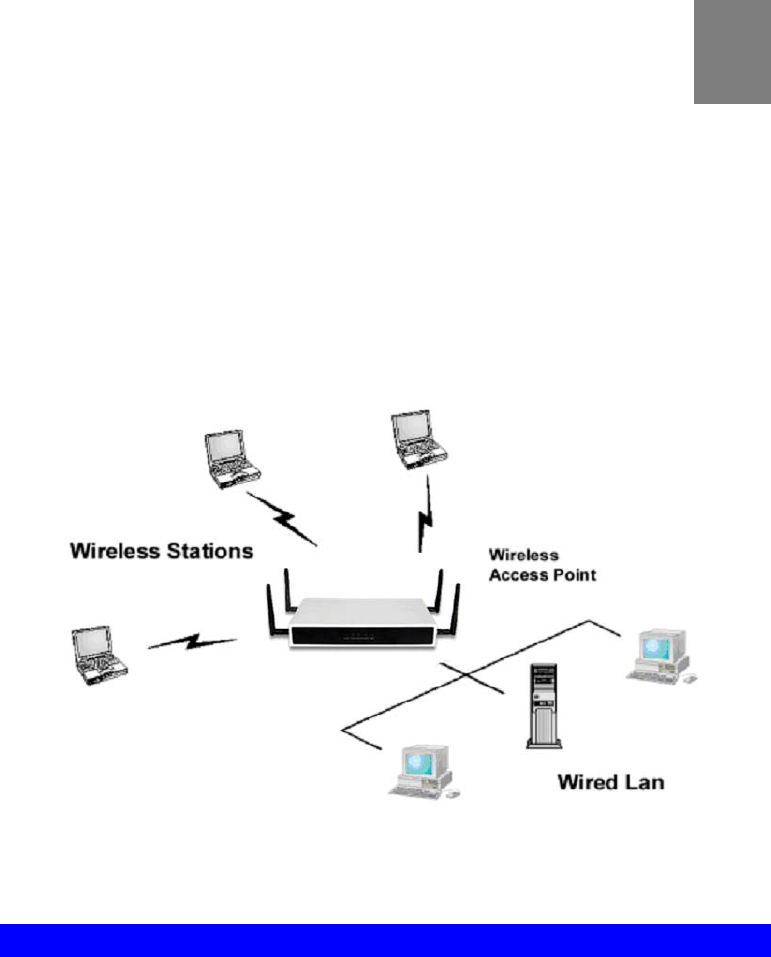
1
Chapter 1
Introduction
This Chapter provides an overview of the Wireless Access Point's features
and capabilities.
Congratulations on the purchase of your new Wireless Access Point. The Wireless Access
Point links your Wireless Stations to your wired LAN. With the Wireless Access Point, you
can select either 2.4 GHz or 5 GHz radio bands, which provides the flexibility to manage a
graceful transition from networks. The Wireless stations and devices on the wired LAN are
then on the same network, and can communicate with each other without regard for whether
they are connected to the network via a Wireless or wired connection.
Figure 1: Wireless Access Point
Features of your Wireless Access Point
The Wireless Access Point incorporates many advanced features, carefully designed to provide
sophisticated functions while being easy to use.
Standards Compliant. The Wireless Access Point complies with the IEEE802.11g and
IEEE802.11n draft 2.0 specifications for Wireless LANs.
Supports 11n Wireless Stations. The 802.11n Draft standard provides for backward
compatibility with the 802.11b standard, so 802.11n, 802.11a, 802.11b and 802.11g
Wireless stations can be used simultaneously. The Wireless Access Point supports both
the 2.4GHz and 5.0GHz (802.11a) bands.
DHCP Client Support. Dynamic Host Configuration Protocol provides a dynamic IP
address to PCs and other devices upon request. The Wireless Access Point can act as a
DHCP Client, and obtain an IP address and related information from your existing DHPC
Server.
1

Wireless Access Point User Guide
2
Upgradeable Firmware. Firmware is stored in a flash memory and can be upgraded
easily, using only your Web Browser.
PoE Support. You can use PoE (Power over Ethernet) to provide power to the Wireless
Access Point, so only a single cable connection is required.
Security Features
Virtual APs. For maximum flexibility, wireless security settings are stored in Virtual AP.
Up to 16 Virtual APs can be defined and used as any time.
Multiple BSSIDs. Because each Virtual AP has it own SSID and beacon, and up to 16
Virtual APs can be active simultaneously, multiple SSIDs are supported. Different clients
can connect to the Wireless Access Point using different SSIDs, with different security
settings.
Virtual APs Isolation. If desired, PCs and devices connecting to different Virtual APs
can be isolated from each other.
VLAN Support. The 802.1Q VLAN standard is supported, allowing traffic from differ-
ent sources to be segmented. Combined with the multiple SSID feature, this provides a
powerful tool to control access to your LAN.
WEP support. Support for WEP (Wired Equivalent Privacy) is included. The 64 Bit,
128 Bit and 152 Bit keys are supported.
WPA support. Support for WPA is included. WPA is more secure than WEP, and
should be used if possible. Both TKIP and AES encryption methods are supported.
802.1x Support. Support for 802.1x mode is included, providing for the industrial-
strength wireless security of 802.1x authentication and authorization.
Radius Client Support. The Wireless Access Point can login to your existing Radius
Server (as a Radius client).
Radius MAC Authentication. You can centralize the checking of Wireless Station
MAC addresses by using a Radius Server.
Rogue AP Detection. The Wireless Access Point can detect unauthorized (Rouge)
Access Points on your LAN.
Access Control. The Access Control feature can check the MAC address of Wireless
clients to ensure that only trusted Wireless Stations can use the Wireless Access Point to
gain access to your LAN.
Password - protected Configuration. Optional password protection is provided to
prevent unauthorized users from modifying the configuration data and settings.
Advanced Features
Command Line Interface. If desired, the command line interface (CLI) can be used for
configuration. This provides the possibility of creating scripts to perform common config-
uration changes.
Auto Configuration. The Wireless Access Point can perform self-configuration by
copying the configuration data from another Access Point. This feature is enabled by de-
fault.
Auto Update. The Wireless Access Point can automatically update its firmware, by
downloading and installing new firmware from your FTP server.
Radius Accounting Support. If you have a Radius Server, you can use it to provide
accounting data on Wireless clients.
Syslog Support. If you have a Syslog Server, the Wireless Access Point can send its log
data to your Syslog Server.

Introduction
3
SNMP Support. SNMP (Simple Network Management Protocol) is supported, allowing
you to use a SNMP program to manage the Wireless Access Point. When stores the con-
figuration, will not affect the operation of SNMP and CLI.
VPN Pass – through. Do not affect related application operation (such as ICMP, FTP,
HTTP, Etc.) when in IP network, and support VPN Pass - through function.
Package Contents
The following items should be included:
Wireless Access Point
Power Adapter
Two 5G Detachable Antennas
Two 2.4G Detachable Antennas
Quick Start Guide
CD-ROM containing the on-line manual
If any of the above items are damaged or missing, please contact your dealer immediately.
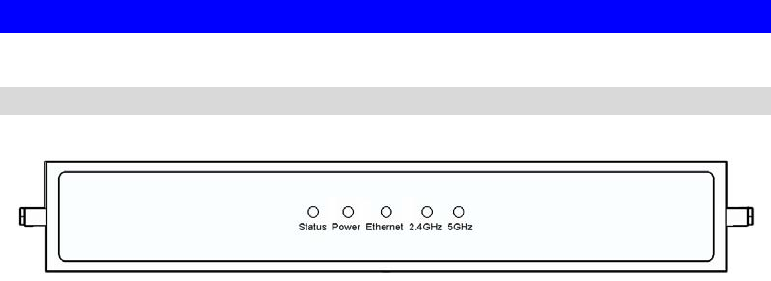
Wireless Access Point User Guide
4
Physical Details
Front Panel LEDs
Figure 2: Front Panel
Antenna Ports
(Left Side) Attach the 5G antennas here.
Status On - Error condition.
Off - Normal operation.
Blinking - During start up, and when the Firmware is being upgraded.
Power On - Normal operation.
Off - No power
Ethernet On - Corresponding LAN (hub) port is active.
Off - No active connection on the corresponding LAN (hub) port.
Flashing - Data is being transmitted or received via the corresponding
LAN (hub) port.
2.4 GHz On - Wireless connection is available in 2.4GHz mode.
Off - Wireless connection is not available in 2.4GHz mode.
Flashing - Data is being transmitted or received via the Wireless
access point. Data includes "network traffic" as well as user data.
5 GHz On - Wireless connection is available in 5GHz mode.
Off - Wireless connection is not available in 5GHz mode.
Flashing - Data is being transmitted or received via the Wireless
access point. Data includes "network traffic" as well as user data.
Antenna Ports
(Right Side) Attach the 2.4G antennas here.

Introduction
5
Rear Panel
Figure 3: Rear Panel
Reset Button This button has two (2) functions:
Reboot. When pressed and released, the Wireless Access Point
will reboot (restart).
Reset to Factory Defaults. This button can also be used to clear
ALL data and restore ALL settings to the factory default values.
To Clear All Data and restore the factory default values:
1. Hold the Reset Button until the Status (Red) LED blinks TWICE,
usually more than 5 seconds.
2. Release the Reset Button.
The factory default configuration has now been restored, and the
Access Point is ready for use.
Console port This port allows root access to the router via a dumb terminal interface.
LAN/PoE Use a standard LAN cable (RJ45 connectors) to connect this port to a
10/100/1000BaseT hub/switch on your LAN.
Power port Connect the supplied power adapter (12V) here.

Wireless Access Point User Guide
6
Wall Mount Template
The following image illustrates the mounting slots on the bottom of the device.
Figure 4: Wall Mount

7
Chapter 2
Installation
This Chapter covers the physical installation of the Wireless Access Point.
Requirements
Requirements:
TCP/IP network
Ethernet cable with RJ-45 connectors
Installed Wireless network adapter for each PC that will be wirelessly connected to the
network.
Procedure
1. Select a suitable location for the installation of your Wireless Access Point. To maximize
reliability and performance, follow these guidelines:
Use an elevated location, such as wall mounted or on the top of a cubicle.
Place the Wireless Access Point near the center of your wireless coverage area.
If possible, ensure there are no thick walls or metal shielding between the Wireless
Access Point and Wireless stations. Under ideal conditions, the Wireless Access Point
has a range of around 150 meters (450 feet). The range is reduced, and transmission
speed is lower, if there are any obstructions between Wireless devices.
Figure 5: Installation Diagram
2
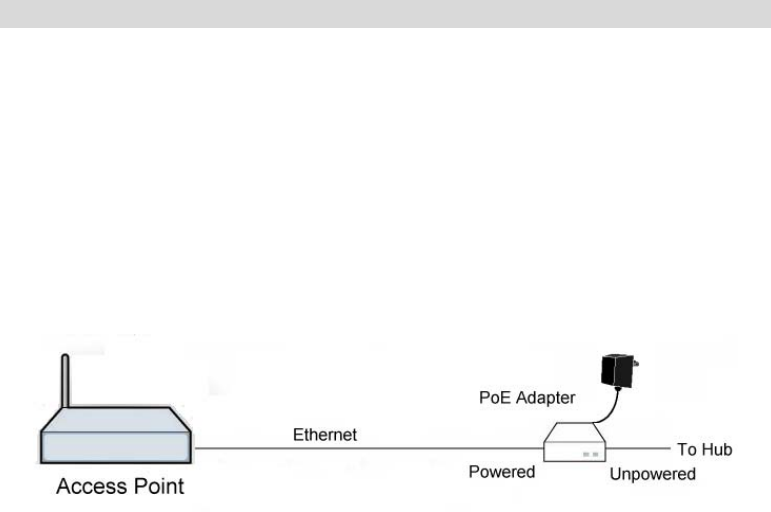
Wireless Access Point User Guide
8
2. Use a standard LAN cable to connect the "LAN" port on the Wireless Access Point to a
10/100/1000BaseT hub/switch on your LAN.
3. Connect the supplied power adapter to the Wireless Access Point and a convenient power
outlet, and power up.
4. Check the LEDs:
The Status LED should flash, then turn OFF.
The Power and Ethernet LEDs should be ON.
For more information, refer to Front Panel LEDs in Chapter 1.
Using PoE (Power over Ethernet)
The Wireless Access Point supports PoE (Power over Ethernet). To use PoE:
1. Do not connect the supplied power adapter to the Wireless Access Point.
2. Connect one end of a standard (category 5) LAN cable to the Ethernet port on the Wire-
less Access Point.
3. Connect the other end of the LAN cable to the powered Ethernet port on a suitable PoE
Adapter.
4. Connect the unpowered Ethernet port on the PoE adapter to your Hub or switch.
5. Connect the power supply to the PoE adapter and power up.
6. Check the LEDs on the Wireless Access Point to see it is drawing power via the Ethernet
connection.
Figure 6: Using PoE (Power over Ethernet)

9
Chapter 3
Access Point Setup
This Chapter provides details of the Setup process for Basic Operation of
your Wireless Access Point.
Overview
This chapter describes the setup procedure to make the Wireless Access Point a valid device
on your LAN, and to function as an Access Point for your Wireless Stations.
Wireless Stations may also require configuration. For details, see Chapter 4 - PC and Server
Configuration.
The Wireless Access Point can be configured using your Web Browser.
Setup using a Web Browser
Your Browser must support JavaScript. The configuration program has been tested on the
following browsers:
Chrome
Firefox
Internet Explorer 7 or later
Setup Procedure
Before commencing, install the Wireless Access Point in your LAN, as described previously.
1. Check the Wireless Access Point to determine its Host Name. This is shown on a label on
the base or rear, and is in the following format:
APxxxxxx
Where xxxxxx is the last 6 Hex characters (0 ~ 9, and A ~ F) of the MAC address.
2. Use a PC which is already connected to your LAN, either by a wired connection or anoth-
er Access Point.
Until the Wireless Access Point is configured, establishing a Wireless connection to it
may be not possible.
If your LAN contains a Router or Routers, ensure the PC used for configuration is on
the same LAN segment as the Wireless Access Point.
3. Start your Web browser.
4. In the Address box, enter "HTTP://" and the IP Address of the 11N Wireless Access Point,
as in this example, which uses the Wireless Access Point's default IP Address:
HTTP://192.168.0.228
5. You should then see a login prompt, which will ask for a User Name and Password.
Enter admin for the User Name, and password for the Password.
These are the default values. The password can and should be changed. Always enter the
3

Wireless Access Point User Guide
10
current user name and password, as set on the Administration-Management-Account
screen.
Figure 7: Password Dialog
6. You will then see the Status screen, which displays the current settings and status. No data
input is possible on this screen. See Chapter 5 for details of the Status screen.
7. From the menu, check the following screens, and configure as necessary for your
environment. Details of these screens and settings are described in the following sections
of this chapter.
8. Use the Apply and Logout buttons on the menu to apply your changes and exit the
Wireless Access Point.
Setup is now complete.
Wireless stations must now be set to match the Wireless Access Point. See Chapter 4 for
details.
If you can't connect:
It is likely that your PC’s IP address is incompatible with the Wireless Access
Point’s IP address. This can happen if your LAN does not have a DHCP Server.
The default IP address of the Wireless Access Point is 192.168.0.228, with a
Network Mask of 255.255.255.0.
If your PC’s IP address is not compatible with this, you must change your PC’s IP
address to an unused value in the range 192.168.0.1 ~ 192.168.0.254, with a
Network Mask of 255.255.255.0. See Appendix C - Windows TCP/IP for details
for this procedure.
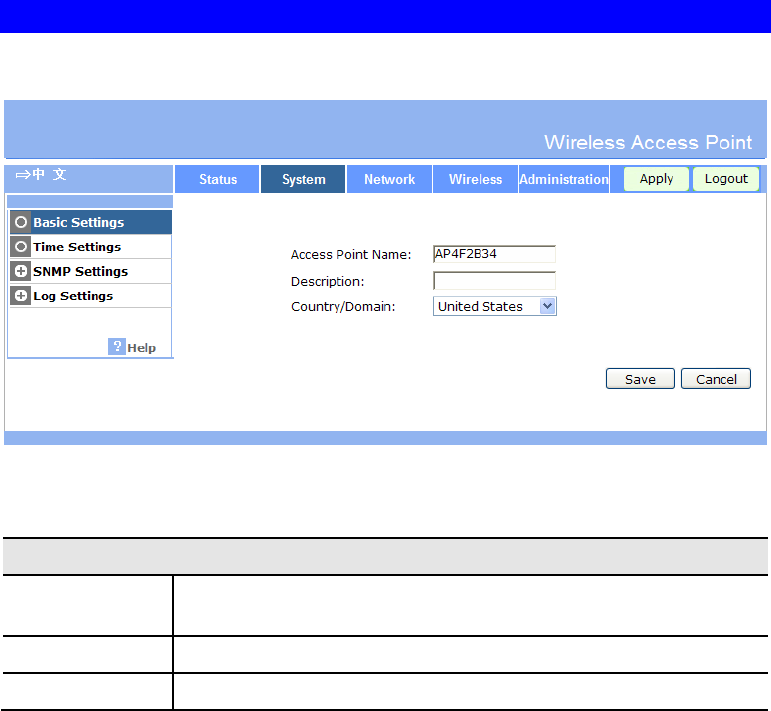
Access Point Setup
11
System - Basic Settings Screen
Click Basic Settings on the System menu to view a screen like the following.
Figure 8: Basic Settings Screen
Data - Basic Settings Screen
Basic Settings
Access Point
Name It displays the default host name of the device. Enter a suitable name
for this Access Point if required.
Description If desired, you can enter a description for the Access Point.
Country/Domain The country or domain which is matching your current location.
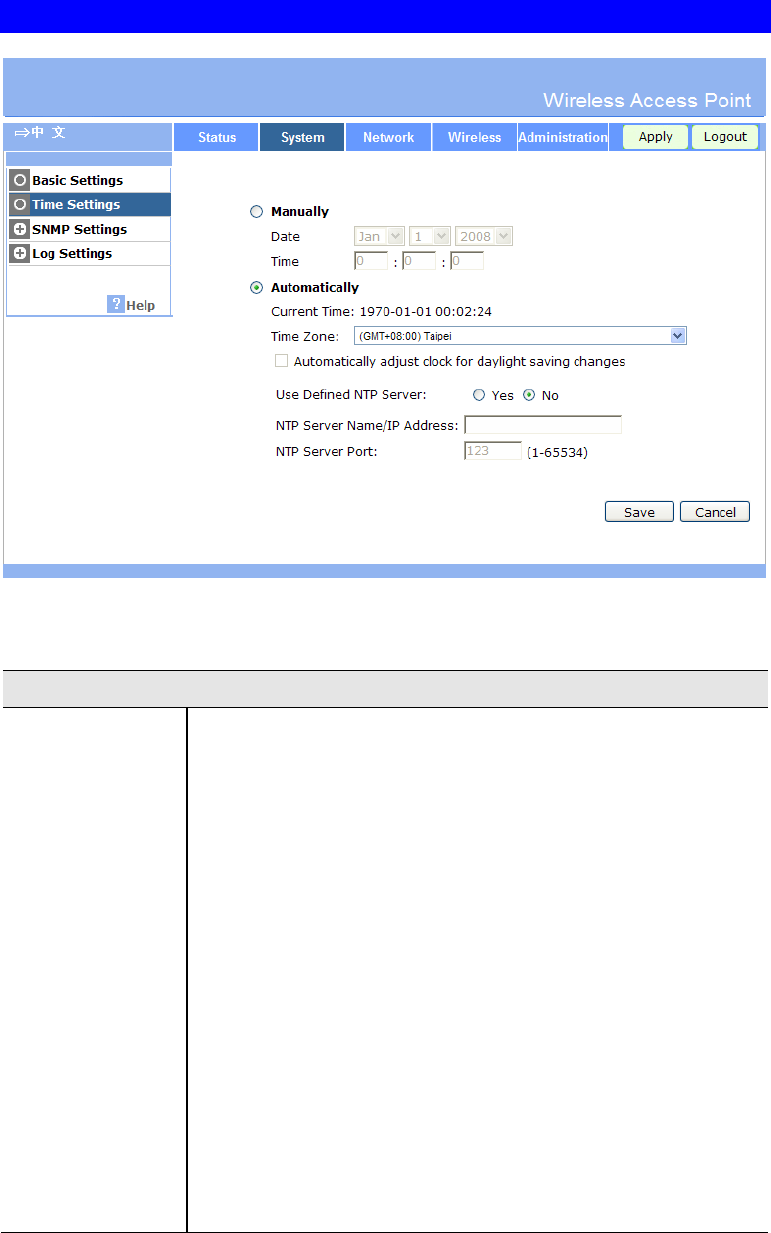
Wireless Access Point User Guide
12
System - Time Settings Screen
Figure 9: Time Settings Screen
Data - Time Settings Screen
TimeZone
Time Settings Select either Manually or Automatically
Manually
Date - Select the date to match your location.
Time - Enter the correct time.
Automatically
Current Time - It displays the current date and time.
Time Zone - Choose the Time Zone for your location from
the drop-down list. If your location is currently using Day-
light Saving, enable the Automatically adjust for daylight
saving changes checkbox.
You must UNCHECK this checkbox when Daylight Saving
Time finishes.
Use Defined NTP Server - If you prefer to use a particular
NTP server as the primary server, check this checkbox and
enter the Server's IP address in the fields provided. If this
setting is not enabled, the default NTP Server is used.
NTP Server Name/IP Address - Enter the server name or IP
address of the NTP.
NTP Server Port - Enter the port for the NTP server.
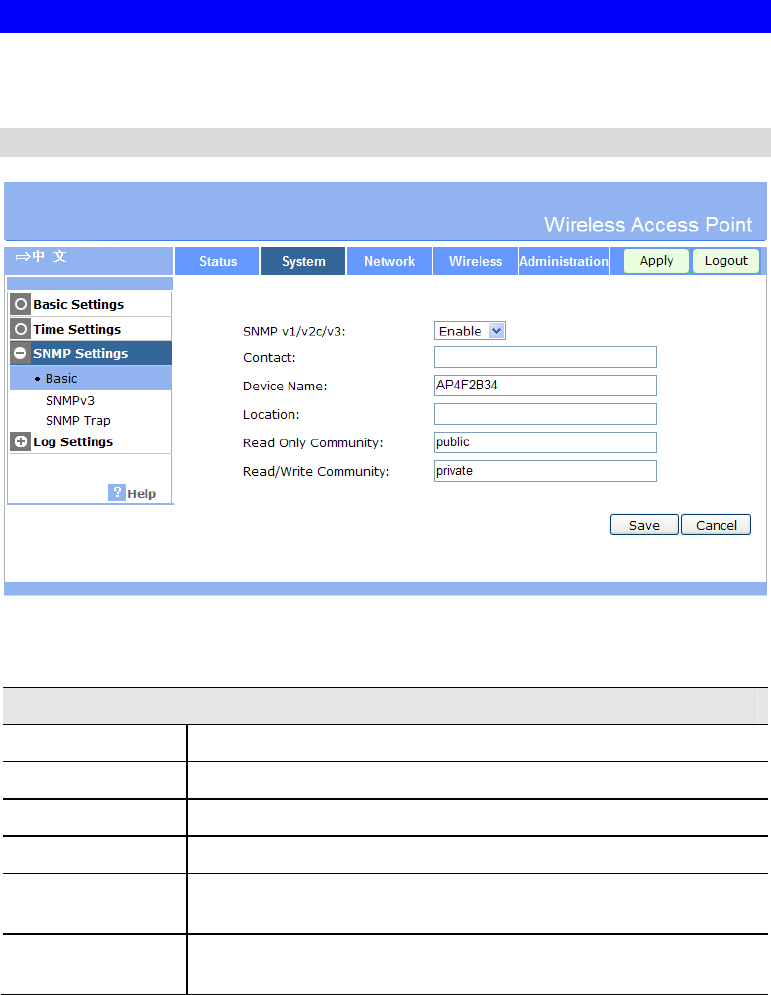
Access Point Setup
13
System - SNMP Settings
SNMP (Simple Network Management Protocol) is only useful if you have a SNMP program
on your PC. To reach this screen, select SNMP in the System section of the menu.
Basic Screen
Figure 10: Basic Screen
Data - Basic Screen
Basic
SNMP v1/v2/v3 Use this to enable or disable SNMP as required.
Contact The identification of the contact person.
Device Name Enter the desired name for the device.
Location The physical location of this node.
Read Only
community Data can be read, but not changed.
Read/Write
Community Data can be read and changed.
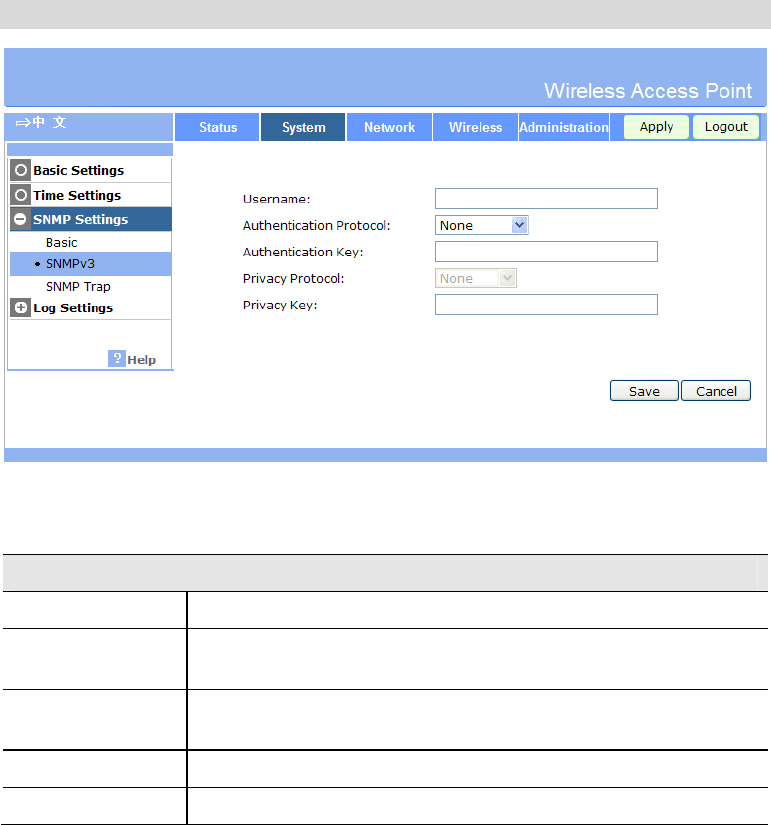
Wireless Access Point User Guide
14
SNMPv3
Figure 11: SNMPv3 Screen
Data - SNMPv3 Screen
SNMPv3
User Name Enter the user name for SNMPv3.
Authentication
Protocol Select the authentication protocol used by SNMPv3.
Authentication
Key Enter the authentication key required by SNMPv3.
Privacy Protocol Select the private protocol as required.
Privacy Key Enter the private key here.
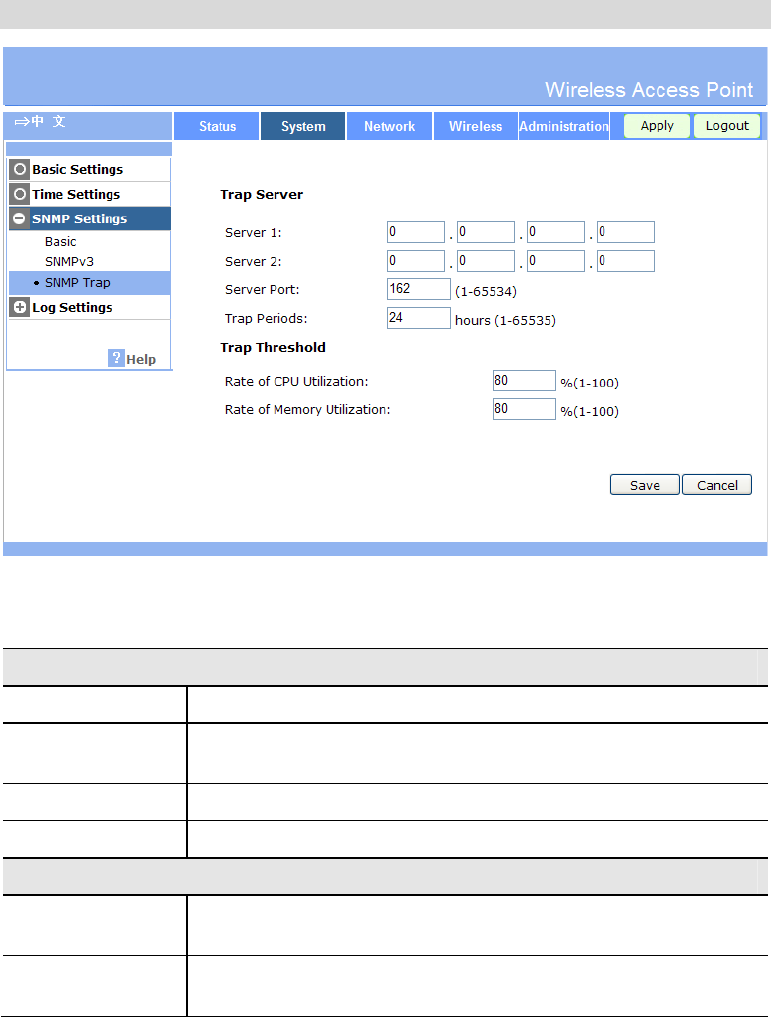
Access Point Setup
15
SNMP Trap
Figure 12: SNMP Trap Screen
Data - SNMP Trap Screen
SNMP Trap
Server 1 Enter the IP address of the server 1.
Server 2 Enter the IP address of the server 2 in case the server 1 is not
available.
Server Port Enter the port number for the server.
Trap Periods Enter the desired hours (1 ~ 65535).
Trap Threshold
Rate of CPU
Utilization When Rate of CPU Utilization reaches the threshold, then one SNMP
trap will be sent out.
Rate of Memory
Utilization When Rate of Memory Utilization reaches the threshold, then one
SNMP trap will be sent out.
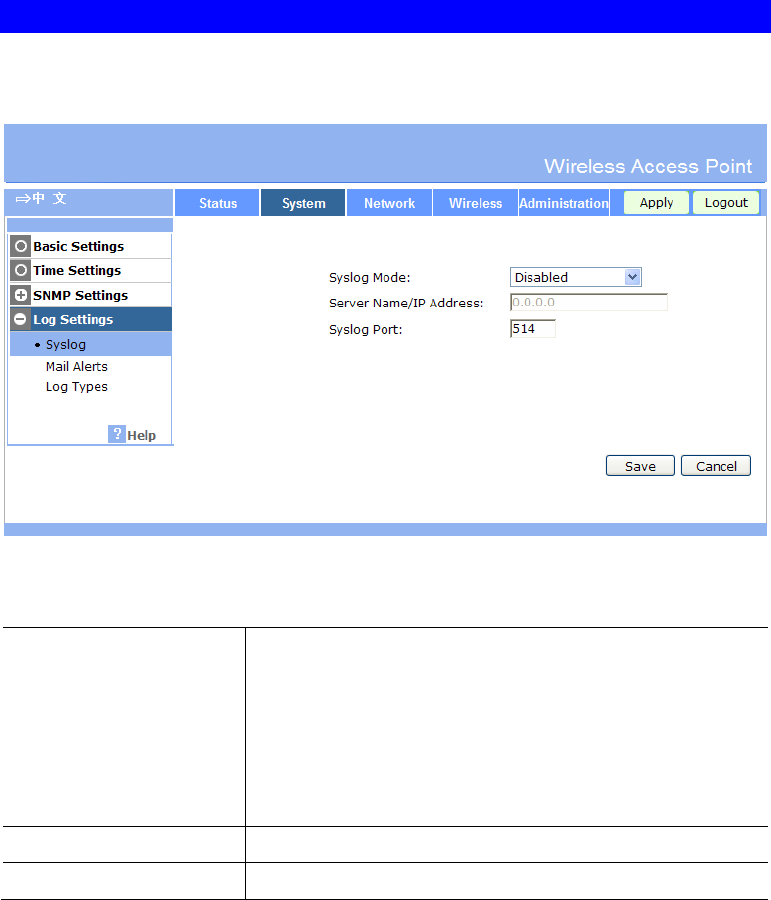
Wireless Access Point User Guide
16
System - Log Settings
If you have a Syslog Server on your LAN, this screen allows you to configure the Access Point
to send log data to your Syslog Server.
Figure 13: Syslog Settings Screen
Data - Syslog Settings Screen
Syslog Mode Select the desired Option:
Disabled - Syslog server is not used.
Broadcast - Syslog data is broadcast. Use this option if
different PCs act as the Syslog server at different times.
Unicast - Select this if the same PC is always used as the
Syslog server. If selected, you must enter the server ad-
dress in the field provided.
Server Name/IP Address Enter the name or IP address of your Syslog Server.
Syslog Port Enter the port for the Syslog Server.
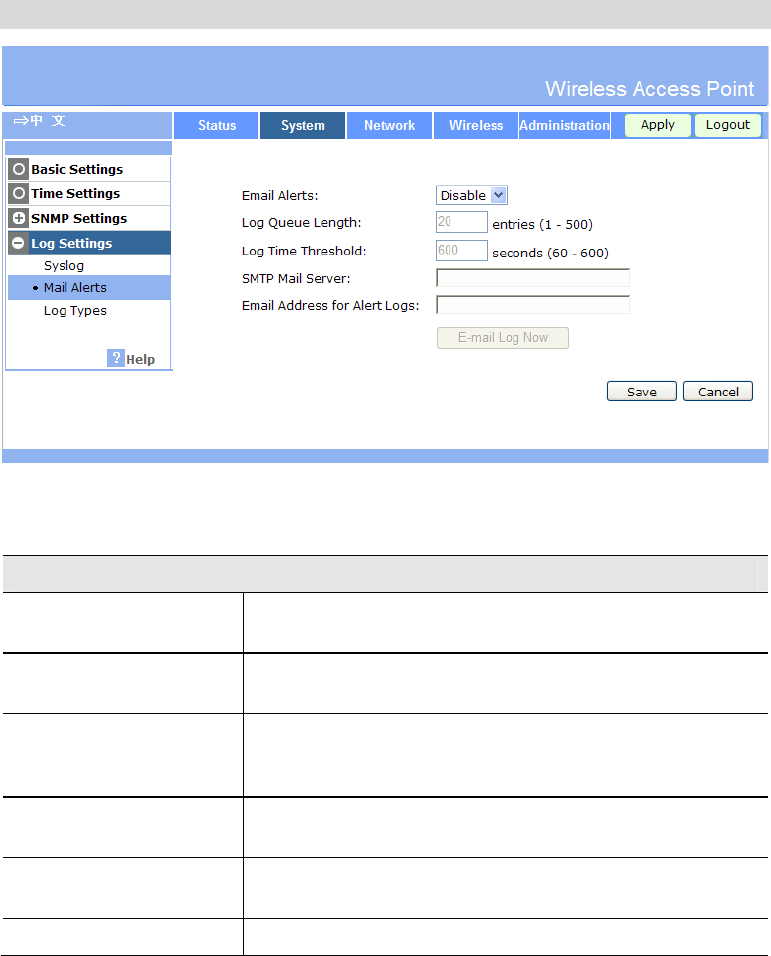
Access Point Setup
17
Mail Alerts
Figure 14: Mail Alerts Screen
Data - Mail Alerts Screen
Email Alerts
Email Alerts If enabled, an E-mail will be sent. If enabled, the e-mail
address information (below) must be provided.
Log Queue Length Enter the desired length of the log queue. The default is 20
entries.
Log Time Threshold Enter the preferred value between 60 and 600, which deter-
mine how often the log will be emailed to you. Normally, this
can be left at the default value. The default is 600 seconds.
SMTP Mail Server Enter the domain name or IP address of the SMTP (Simple
Mail Transport Protocol) server you use for sending e-mails.
Email Address for Alert
Logs Enter the e-mail address the log is to be sent to.
E-mail Log Now Press this button to let the log to be e-mailed immediately.
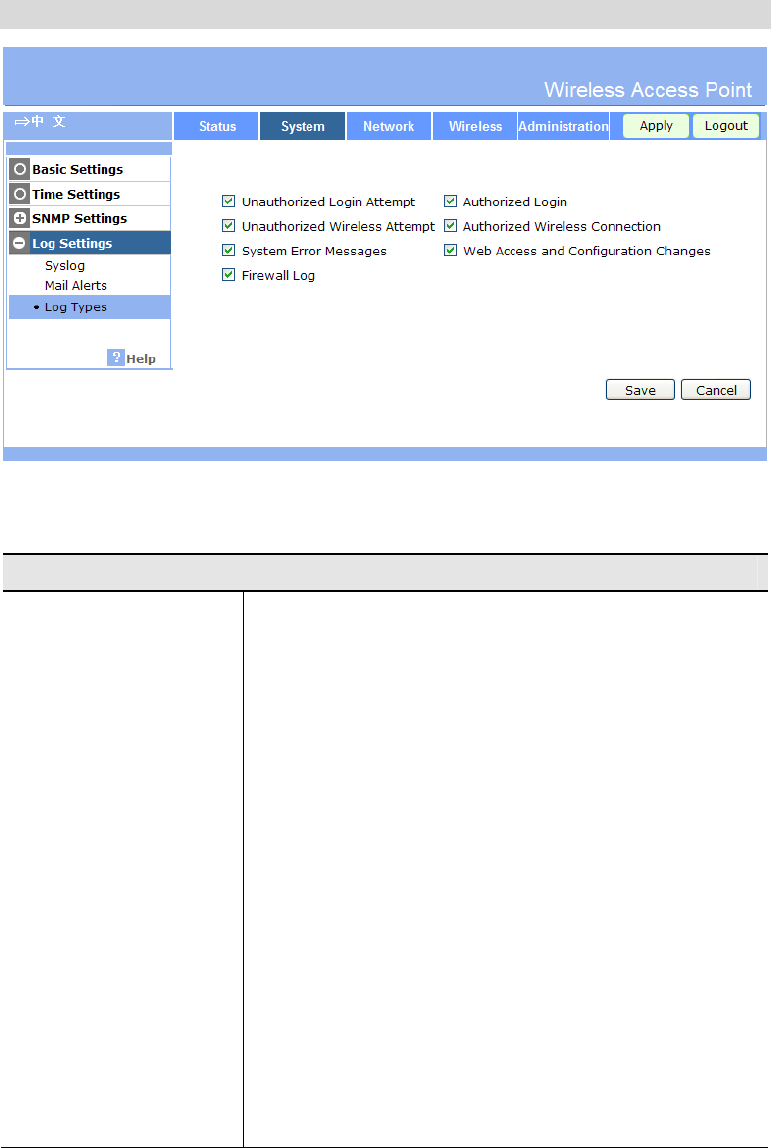
Wireless Access Point User Guide
18
Log Types
Figure 15: Log Types Screen
Data - Log Types Screen
Log Types
Log Types Use these checkboxes to determine which events are included
in the log. Checking all options will increase the size of the
log, so it is good practice to disable any events which are not
really required.
Unauthorized Login Attempt - If checked, the unau-
thorized users who attempted to login to the Access Point
are logged.
Authorized Login - If checked, this will log the author-
ized login TO this Access Point.
Unauthorized Wireless Attempt - If checked, the
unauthorized wireless attempted will be login to the
Access Point are logged.
Authorized Wireless Connection - If checked, this will
log the authorized wireless connection to this Access
Point.
System Error Messages - If checked, the system error
message will be logged.
Web Access and Configuration Changes - If checked,
the changes of configuration will be logged.
Firewall Log - If checked, the firewall message will be
logged.
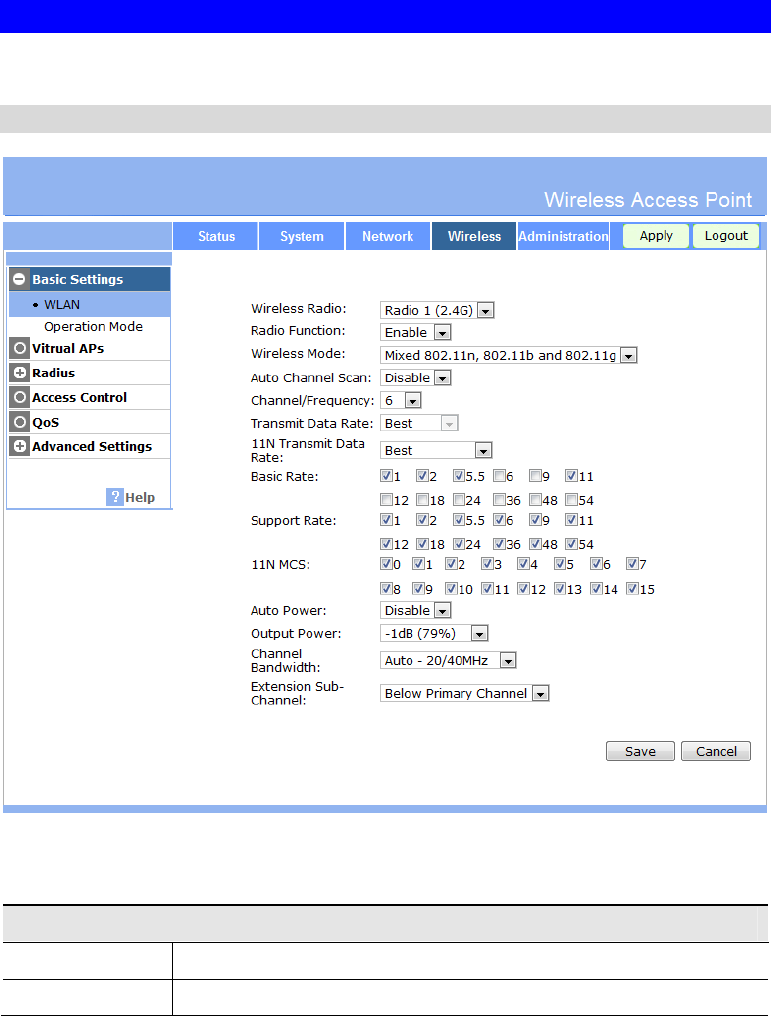
Access Point Setup
19
Wireless - Basic Settings Screen
The settings on this screen must match the settings used by Wireless Stations.
WLAN
Figure 16: WLAN Settings Screen
Data - WLAN Settings Screen
Operation
Wireless Radio Select the either Radio 1 or Radio 2 for the wireless feature.
Radio Function Enable this to use the wireless feature.

Wireless Access Point User Guide
20
Wireless Mode For 5G, select the desired option:
802.11a Only (5G) - only 802.11a connections are allowed. If you
only have 802.11a, selecting this option may provide a perfor-
mance improvement over using the default setting.
802.11n Only (5G) - only 802.11n connections are allowed. If
you only have 802.11n, selecting this option may provide a per-
formance improvement over using the default setting.
802.11a and 802.11n (5G) - this will allow connections by both
802.11a and 802.11n wireless stations.
For 2.4G, select the desired option:
802.11b only (2.4G) - if selected, only 802.11b connections are
allowed. 802.11g wireless stations will only be able to connect if
they are fully backward-compatible with the 802.11b standard.
802.11g only (2.4G) - only 802.11g connections are allowed. If
you only have 802.11g, selecting this option may provide a per-
formance improvement over using the default setting.
802.11n only (2.4G) - only 802.11n connections are allowed. If
you only have 802.11n, selecting this option may provide a per-
formance improvement over using the default setting.
802.11b and 802.11g (2.4G) - this will allow connections by both
802.11b and 802.11g wireless stations.
802.11n and 802.11g (2.4G) - this will allow connections by both
802.11n and 802.11g wireless stations.
Mixed 802.11n/802.11b/802.11g (2.4G) - this is the default, and
will allow connections by 802.11n, 802.11b and 802.11g wireless
stations.
Auto Channel
Scan If "Enable" is selected, the Access Point will select the best available
Channel.
Channel
/Frequency If you experience interference (shown by lost connections and/or slow
data transfers) you may need to experiment with manually setting
different channels to see which one is better.
Transmit Data
Rate Select the desired rate from the drop-down list as required.
11N Transmit
Data Rate Select the desired rate for 802.11N from the list.
Basic Rate It is the rate that the WAP device will advertise to the network for
setting up communication with other access points and client stations
on the network.
Support Rate This indicates the rates that the WAP device supports. Multiple rates
can be selected. The WAP device will automatically choose the most
efficient rate based on error rates and distance of client stations.
11N MCS Select the MCS index below. The WAP device supports MCS indexes
from 0 to 15, which allows a maximum transmission rate of 300 Mbps.
Auto Power Select the desired option. The default is Disable.
Output Power Select the desired power output. Can support -1dB~-15dB, step 1dB.
Higher levels will give a greater range, but are also more likely to
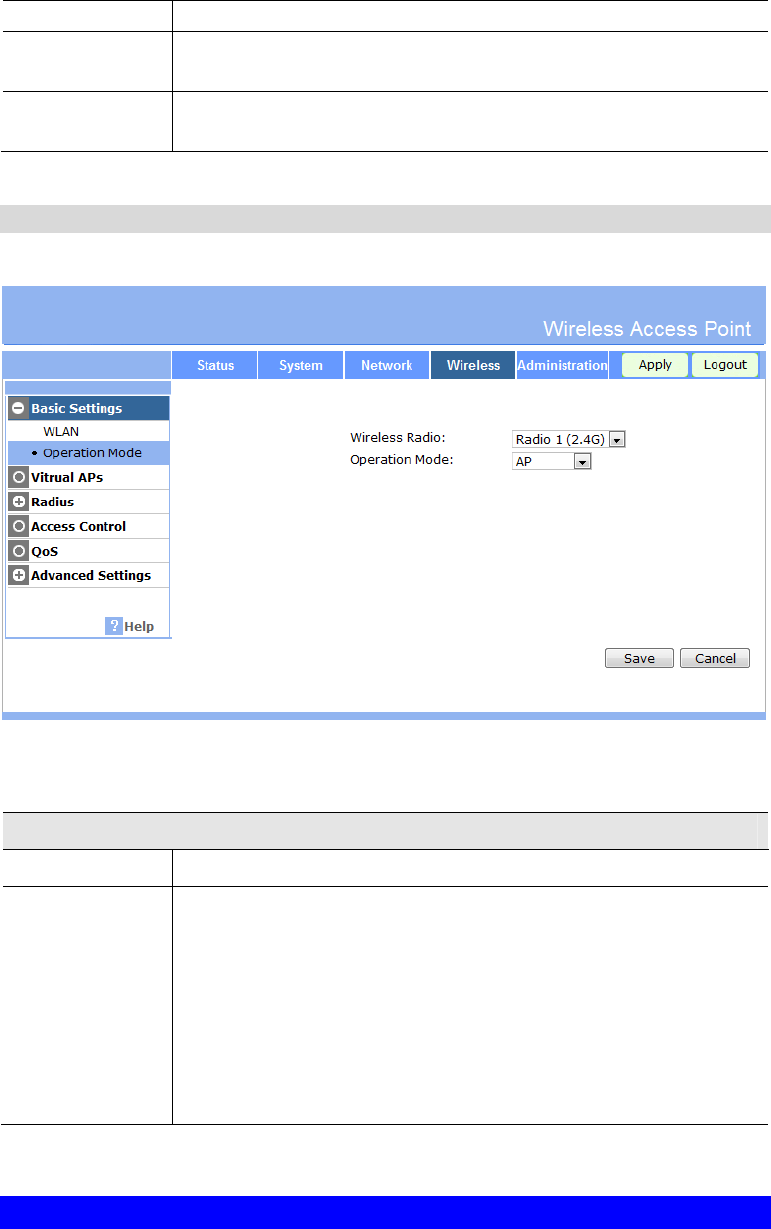
Access Point Setup
21
cause interference with other devices.
Channel
Bandwidth Select the desired bandwidth from the list.
Extension
Sub-Channel Select Above or Below Primary Channel from the list.
Operation Mode
Figure 17: Operation Mode
Data - Operation Mode Settings Screen
Operation
Wireless Radio Select the either Radio 1 or Radio 2 for the wireless feature.
Operation Mode Select the desired option from the list:
AP: Choose this to make the device act as a normal AP.
AP+WDS: Select this mode and make configurations in Vitrual
APs pages. In WDS mode, you can choose which interface to be
worked as a root AP or WDS client. Select only one interface to
be worked as a root AP for the device is recommended. A root AP
is the "Master" for a group of Bridge-mode APs. The other
Bridge-mode APs must be set to Point-to-Point Bridge mode
(WDS Client) with the AP's MAC address.
Wireless - Virtual APs Screen
Clicking the Virtual APs link on the Wireless menu will result in a screen like the following.
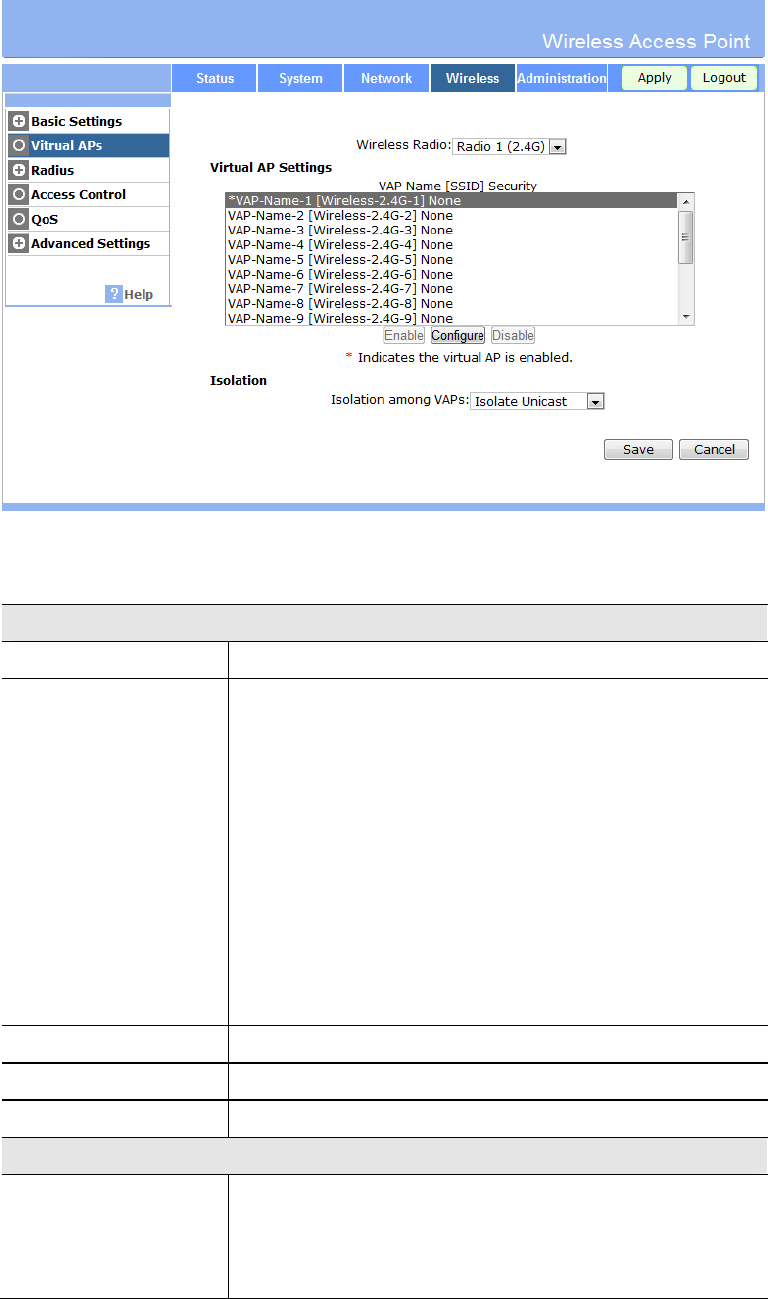
Wireless Access Point User Guide
22
Figure 18: Virtual APs Settings
Data - Virtual APs Settings Screen
VAPs
Wireless Radio Select the either Radio 1 or Radio 2 for the wireless feature.
VAP List All available VAPs are listed. Up to 16 VAPs/Radios can be
supported. For each VAP, the following data is displayed:
*
If displayed before the name of the VAP, this indicates
the VAP is currently enabled. If not displayed, the
VAP is currently disabled.
VAP Name
The current VAP name is displayed.
[SSID]
The current SSID associated with this VAP.
Security System
The current security system (e.g. WPA-PSK) is dis-
played.
Enable Button Enable the selected VAP.
Configure Button Change the settings for the selected VAP.
Disable Button Disable the selected VAP.
Isolation
Isolation among VAPs Select the desired option from the list. If this option is enabled,
wireless clients using different VAPs (different SSIDs) are
isolated from each other, so they will NOT be able to communi-
cate with each other. They will still be able to communicate
with other clients using the same profile, unless the "Wireless

Access Point Setup
23
Separation" setting on the "Advanced" screen has been enabled.
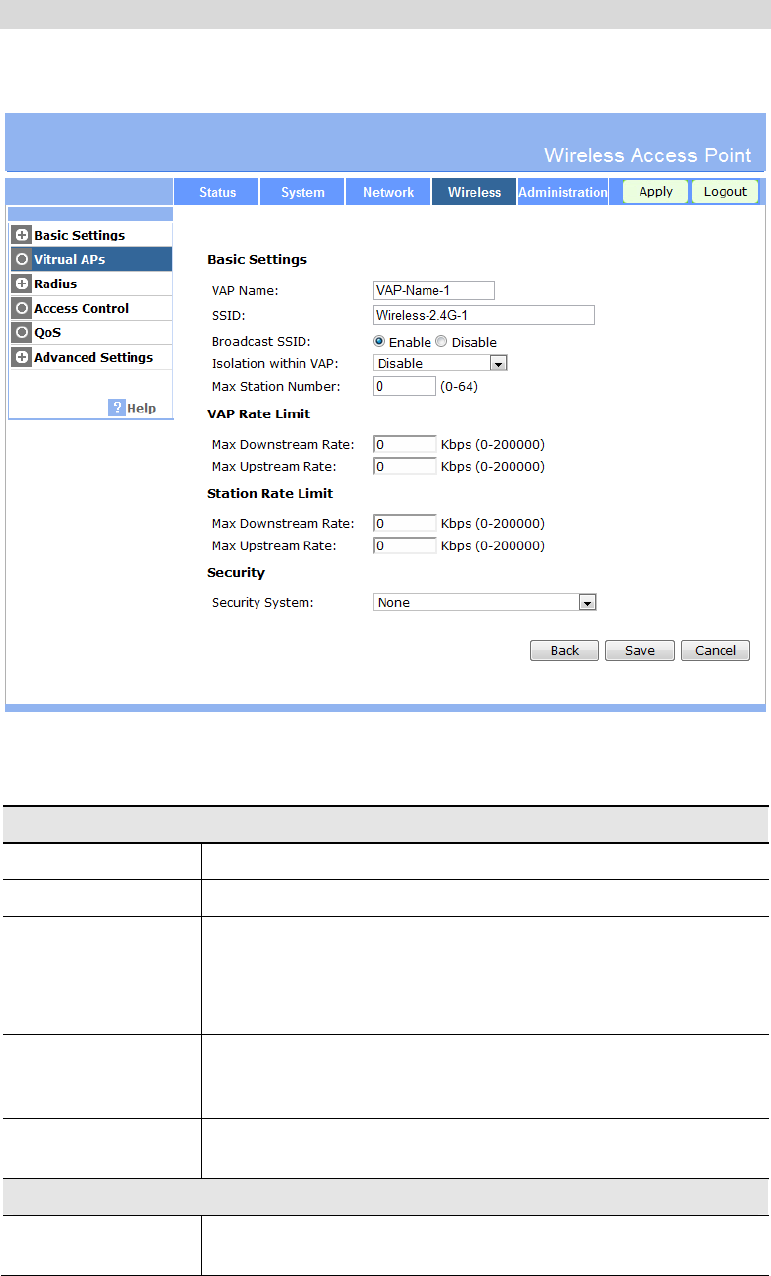
Wireless Access Point User Guide
24
Virtual AP Screen
This screen is displayed when you select a VAP on the Virtual AP Settings screen, and click
the Configure button.
Figure 19: Virtual VAP Screen
Data - Virtual VAP Screen
Basic Settings
VAP Name Enter a suitable name for this VAP.
SSID Enter the desired SSID. Each VAP must have a unique SSID.
Broadcast SSID If Disabled, no SSID is broadcast.
If enabled, the SSID will then be broadcast to all Wireless Stations.
Stations which have no SSID (or a "null" value) can then adopt the
correct SSID for connections to this Access Point.
Isolation within
VAP If enabled, then each Wireless station using the Access Point is
invisible to other Wireless stations. In most business stations, this
setting should be Disabled.
Max Station
Number Enter the number between 0 and 64.
VAP Rate Limit
Max Downstream
Rate Enter the maximum downstream rate for the VAP. "0" means no
limit.

Access Point Setup
25
Max Upstream Rate Enter the maximum upstream rate for the VAP. "0" means no limit.
Station Rate Limit
Max Downstream
Rate Enter the maximum downstream rate for each wireless station. "0"
means no limit.
Max Upstream Rate Enter the maximum upstream rate for each wireless station. "0"
means no limit.
Security
Security System Choose the security method from the drop-down list. Refer to the
following section for more details.
Security Settings
Select the desired option, and then enter the settings for the selected method.
The available options are:
None - No security is used. Anyone using the correct SSID can connect to your network.
WEP - The 802.11b standard. Data is encrypted before transmission, but the encryption
system is not very strong.
WPA-PSK - Like WEP, data is encrypted before transmission. WPA is more secure than
WEP, and should be used if possible. The PSK (Pre-shared Key) must be entered on each
Wireless station. The 256Bit encryption key is derived from the PSK, and changes fre-
quently.
WPA2-PSK - This is a further development of WPA-PSK, and offers even greater securi-
ty, using the AES (Advanced Encryption Standard) method of encryption.
WPA-PSK and WPA2-PSK - This method, sometimes called "Mixed Mode", allows
clients to use EITHER WPA-PSK (with TKIP) OR WPA2-PSK (with AES).
WPA with Radius - This version of WPA requires a Radius Server on your LAN to
provide the client authentication according to the 802.1x standard. Data transmissions are
encrypted using the WPA standard.
If this option is selected:
This Access Point must have a "client login" on the Radius Server.
Each user must have a "user login" on the Radius Server.
Each user's wireless client must support 802.1x and provide the login data when
required.
All data transmission is encrypted using the WPA standard. Keys are automatically
generated, so no key input is required.
WPA2 with Radius - This version of WPA2 requires a Radius Server on your LAN to
provide the client authentication according to the 802.1x standard. Data transmissions are
encrypted using the WPA2 standard.
If this option is selected:
This Access Point must have a "client login" on the Radius Server.
Each user must authenticate on the Radius Server. This is usually done using digital
certificates.
Each user's wireless client must support 802.1x and provide the Radius authentication
data when required.
Wireless Access Point User Guide
26
All data transmission is encrypted using the WPA2 standard. Keys are automatically
generated, so no key input is required.
WPA and WPA2 with Radius - EITHER WPA or WPA2 require a Radius Server on
your LAN to provide the client authentication according to the 802.1x standard. Data
transmissions are encrypted using EITHER WPA or WPA2 standard.
If this option is selected:
This Access Point must have a "client login" on the Radius Server.
Each user must authenticate on the Radius Server. This is usually done using digital
certificates.
Each user's wireless client must support 802.1x and provide the Radius authentication
data when required.
All data transmission is encrypted using EITHER WPA or WPA2 standard. Keys are
automatically generated, so no key input is required.
802.1x - This uses the 802.1x standard for client authentication, and WEP for data
encryption.
If this option is selected:
This Access Point must have a "client login" on the Radius Server.
Each user must have a "user login" on the Radius Server.
Each user's wireless client must support 802.1x and provide the login data when re-
quired.
All data transmission is encrypted using the WEP standard. You only have to select
the WEP key size; the WEP key is automatically generated.
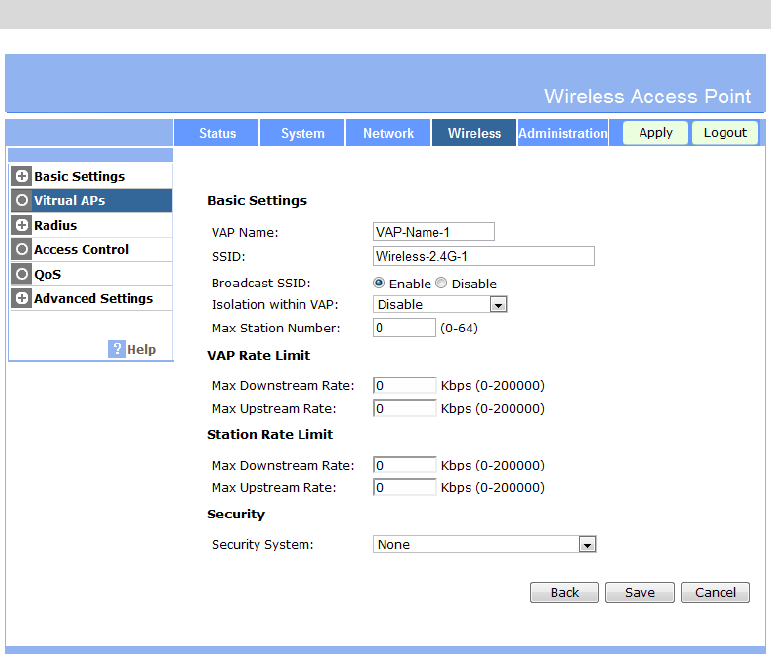
Access Point Setup
27
Security Settings - None
Figure 20: Wireless Security - None
No security is used. Anyone using the correct SSID can connect to your network.

Wireless Access Point User Guide
28
Security Settings - WEP
This is the 802.11b standard. Data is encrypted before transmission, but the encryption system
is not very strong.
Figure 21: WEP Screen
Data - WEP Screen
WEP
Data
Encryption Select the desired option, and ensure your Wireless stations have the
same setting:
64 Bit Encryption - Keys are 10 Hex (5 ASCII) characters.
128 Bit Encryption - Keys are 26 Hex (13 ASCII) characters.
152 Bit Encryption - Keys are 32 Hex (16 ASCII) characters.

Access Point Setup
29
Authentication Normally, you can leave this at “Automatic”, so that Wireless Stations
can use either method ("Open System" or "Shared Key".).
If you wish to use a particular method, select the appropriate value -
"Open System" or "Shared Key". All Wireless stations must then be set
to use the same method.
Key Input Select "Hex" or "ASCII" depending on your input method. (All keys
are converted to Hex, ASCII input is only for convenience.)
Key Value Enter the key values you wish to use. The default key, selected by the
radio button, is required. The other keys are optional. Other stations
must have matching key values.
Passphrase Use this to generate a key or keys, instead of entering them directly.
Enter a word or group of printable characters in the Passphrase box
and click the "Generate Key" button to automatically configure the
WEP Key(s).
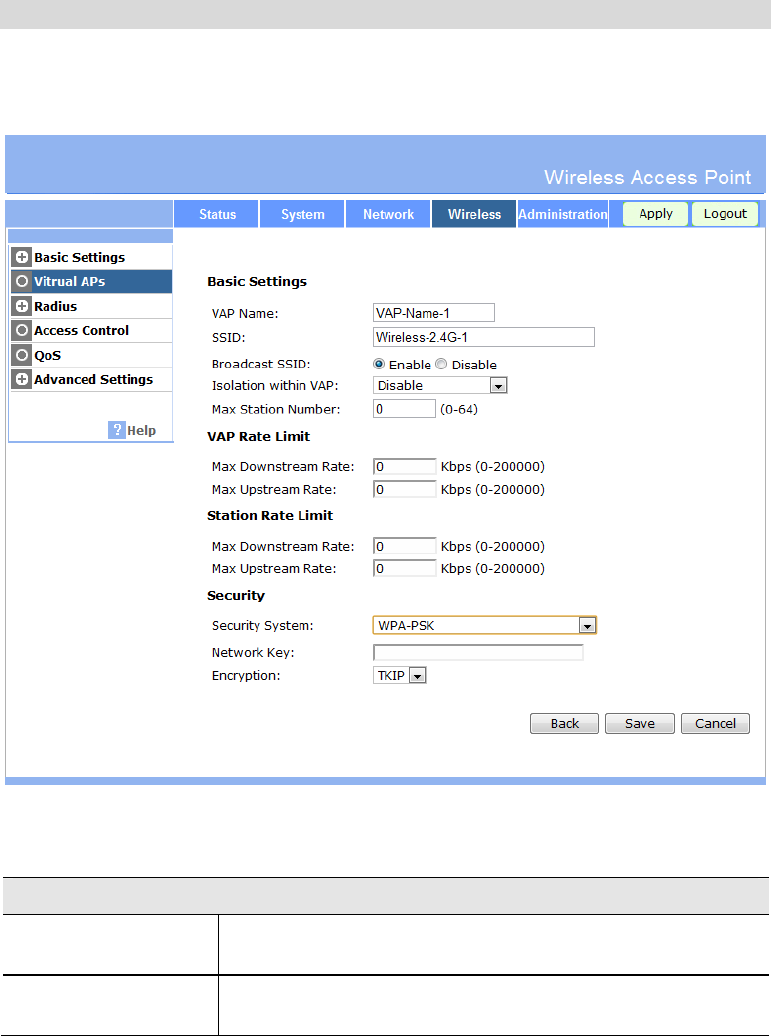
Wireless Access Point User Guide
30
Security Settings - WPA-PSK
Like WEP, data is encrypted before transmission. WPA is more secure than WEP, and should
be used if possible. The PSK (Pre-shared Key) must be entered on each Wireless station. The
256Bit encryption key is derived from the PSK, and changes frequently.
Figure 22: WPA-PSK Screen
Data - WPA-PSK Screen
WPA-PSK
Network Key Enter the key value. Data is encrypted using a 256Bit key derived
from this key. Other Wireless Stations must use the same key.
Encryption The encryption method is TKIP. Wireless Stations must also use
TKIP.
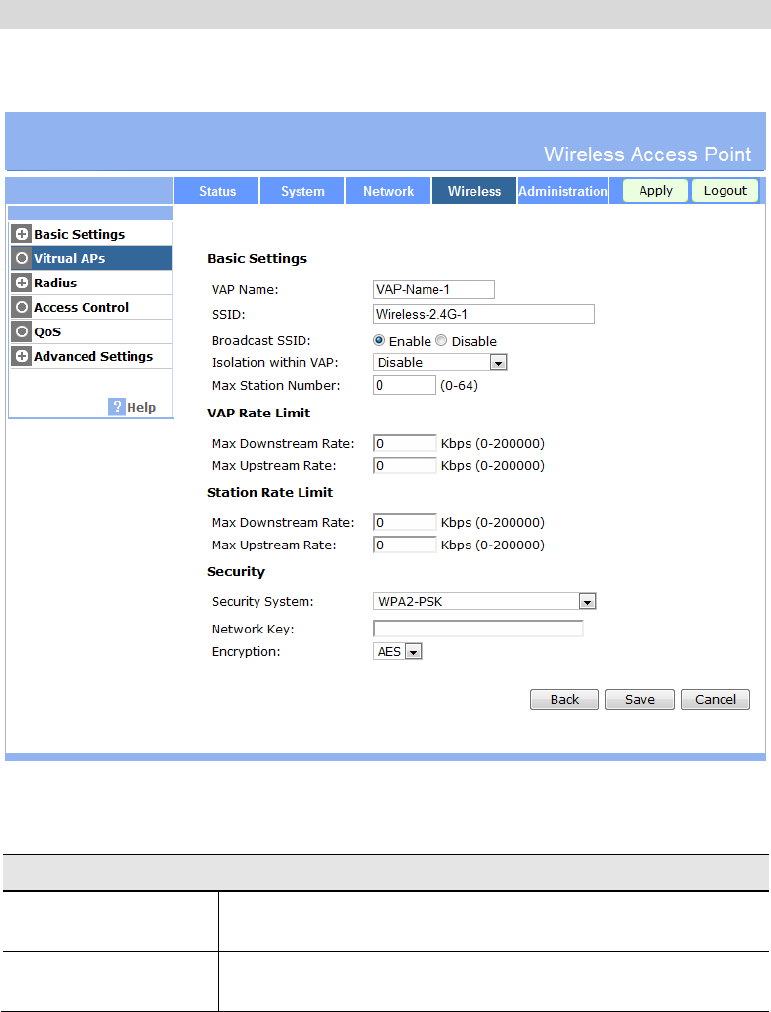
Access Point Setup
31
Security Settings - WPA2-PSK
This is a further development of WPA-PSK, and offers even greater security, using the AES
(Advanced Encryption Standard) method of encryption.
Figure 23: WPA2-PSK Screen
Data - WPA2-PSK Screen
WPA2-PSK
Network Key Enter the key value. Data is encrypted using a 256Bit key derived
from this key. Other Wireless Stations must use the same key.
Encryption The encryption method is AES. Wireless Stations must also use
AES.
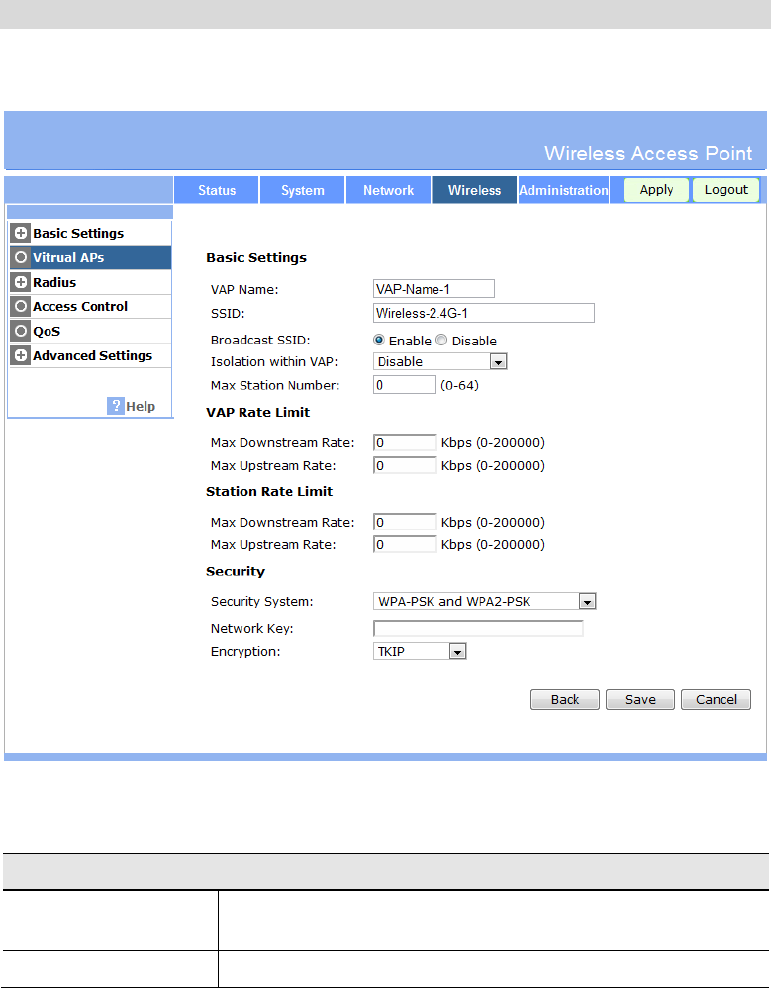
Wireless Access Point User Guide
32
Security Settings - WPA-PSK and WPA2-PSK
This method, sometimes called "Mixed Mode", allows clients to use EITHER WPA-PSK (with
TKIP) OR WPA2-PSK (with AES).
Figure 24: WPA-PSK and WPA2-PSK Screen
Data - WPA-PSK and WPA2-PSK Screen
WPA-PSK and WPA2-PSK
Network Key Enter the key value. Data is encrypted using this key. Other
Wireless Stations must use the same key.
Encryption Select the desired encryption method from the list.
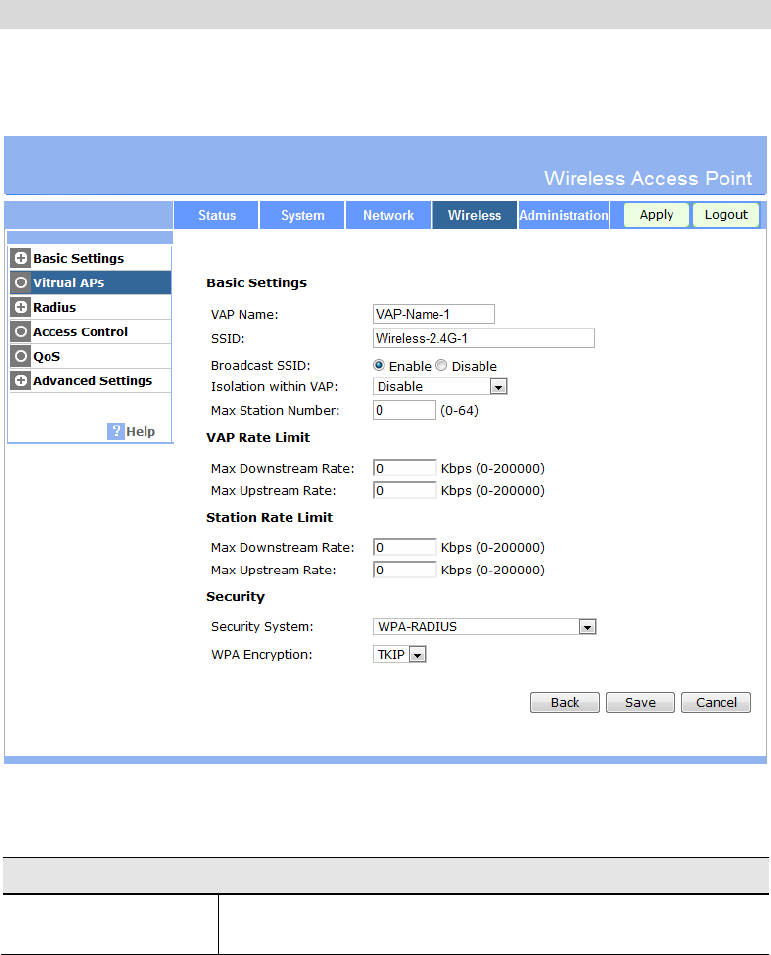
Access Point Setup
33
Security Settings - WPA with Radius
This version of WPA requires a Radius Server on your LAN to provide the client authentica-
tion according to the 802.1x standard. Data transmissions are encrypted using the WPA
standard.
Figure 25: WPA with Radius Screen
Data - WPA with Radius Screen
WPA with Radius
WPA Encryption The encryption method is TKIP. Wireless Stations must also use
TKIP.
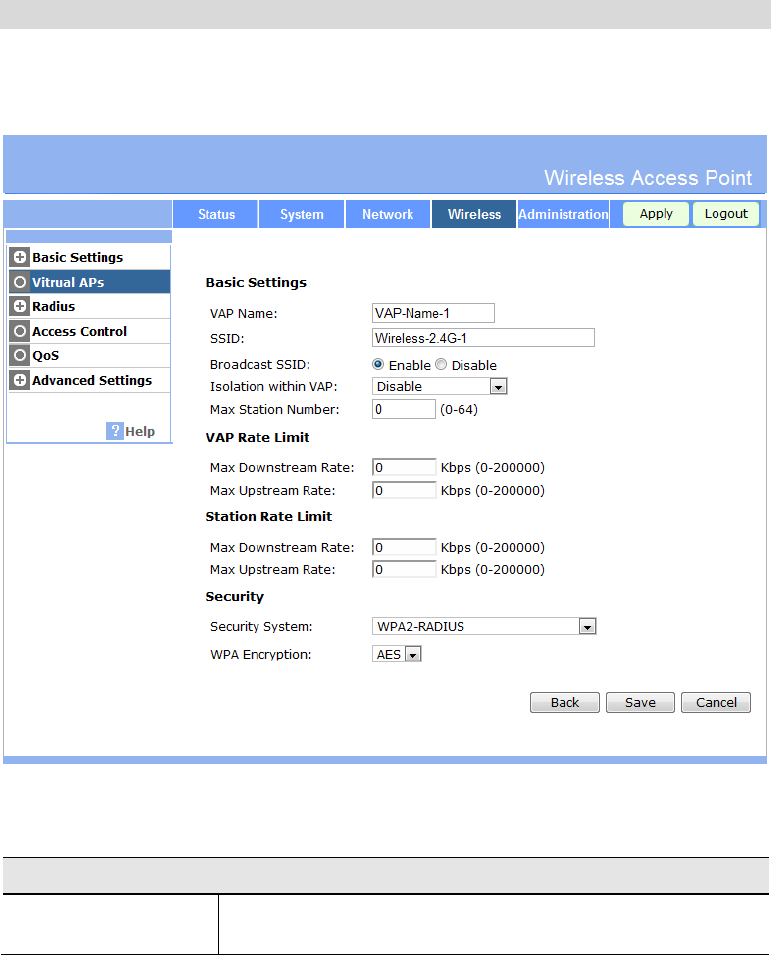
Wireless Access Point User Guide
34
Security Settings - WPA2 with Radius
This version of WPA2 requires a Radius Server on your LAN to provide the client authentica-
tion according to the 802.1x standard. Data transmissions are encrypted using the WPA2
standard.
Figure 26: WPA2 with Radius Screen
Data - WPA2 with Radius Screen
WPA2 with Radius
WPA Encryption The encryption method is AES. Wireless Stations must also use
AES.
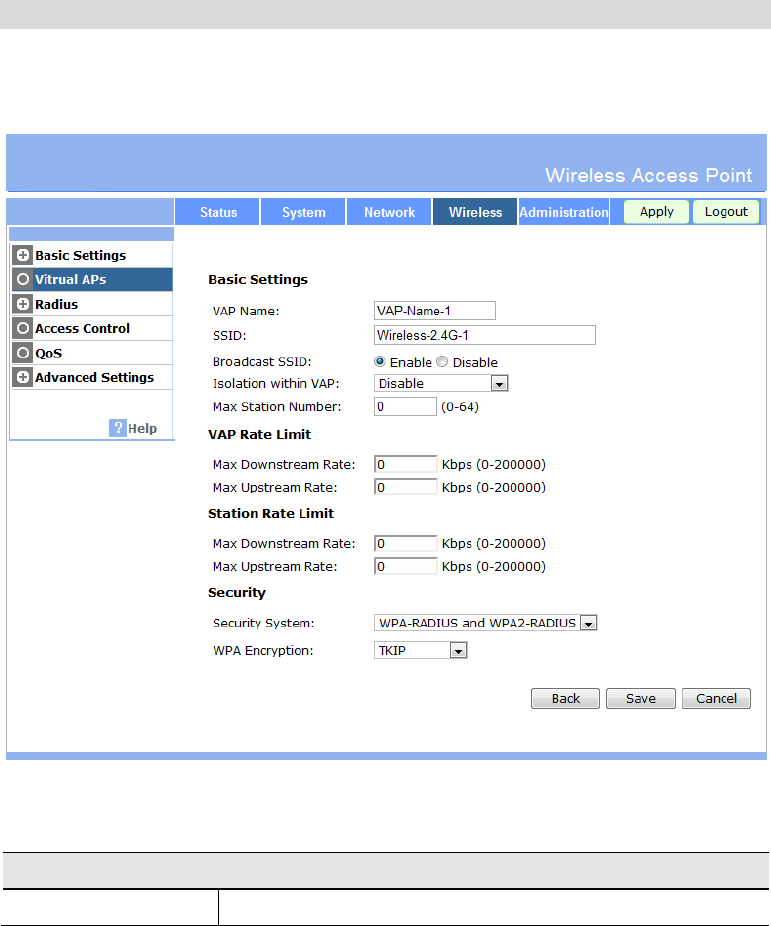
Access Point Setup
35
Security Settings - WPA and WPA2 with Radius
EITHER WPA or WPA2 require a Radius Server on your LAN to provide the client authenti-
cation according to the 802.1x standard. Data transmissions are encrypted using EITHER
WPA or WPA2 standard.
Figure 27: WPA and WPA2 with Radius Screen
Data - WPA and WPA2 with Radius Screen
WPA and WPA2 with Radius
WPA Encryption Select the desired encryption method from the list.
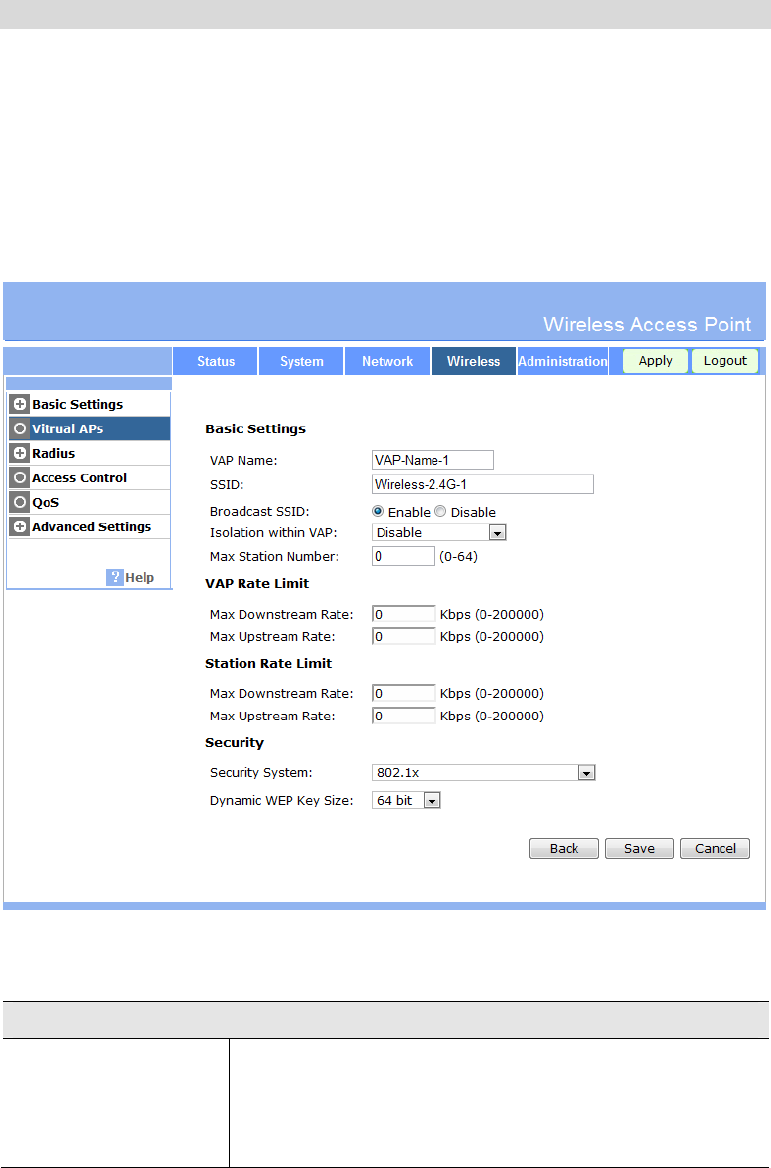
Wireless Access Point User Guide
36
Security Settings - 802.1x
This uses the 802.1x standard for client authentication, and WEP for data encryption. If this
option is selected:
This Access Point must have a "client login" on the Radius Server.
Each user must have a "user login" on the Radius Server. Normally, a Certificate is used to
authenticate each user. See Chapter4 for details of user configuration.
Each user's wireless client must support 802.1x.
All data transmission is encrypted using the WEP standard. You only have to select the
WEP key size; the WEP key is automatically generated.
Figure 28: 802.1x Screen
Data - 802.1x Screen
802.1x
Dynamic WEP Key
Size Select the desired option:
64 Bit - Keys are 10 Hex (5 ASCII) characters.
128 Bit - Keys are 26 Hex (13 ASCII) characters.
152 Bit - Keys are 32 Hex (16 ASCII) characters.
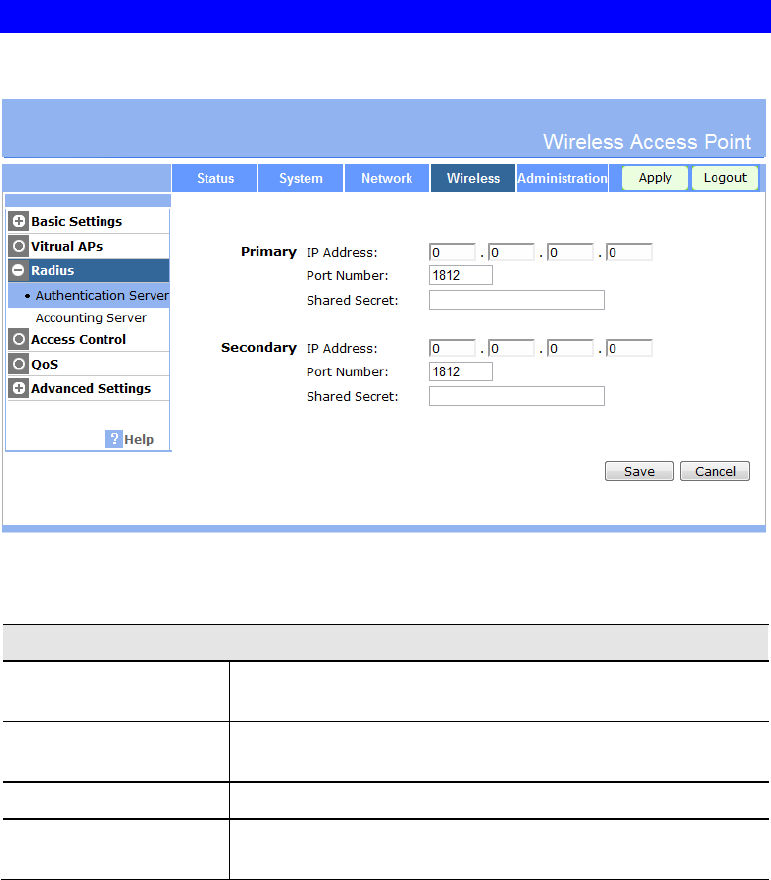
Access Point Setup
37
Wireless - Radius Settings
Clicking the Radius link on the Wireless menu will result in a screen like the following.
Figure 29: Authentication Server Settings
Data - Authentication Server Screen
Authentication Server
Primary IP Address Enter the name or IP address of the Radius Server on your
network.
Port Number Enter the port number used for connections to the Radius
Server.
Shared Secret Enter the key value to match the Radius Server.
Secondary IP Address The Secondary Authentication Server will be used when the
Primary Authentication Server is not available.
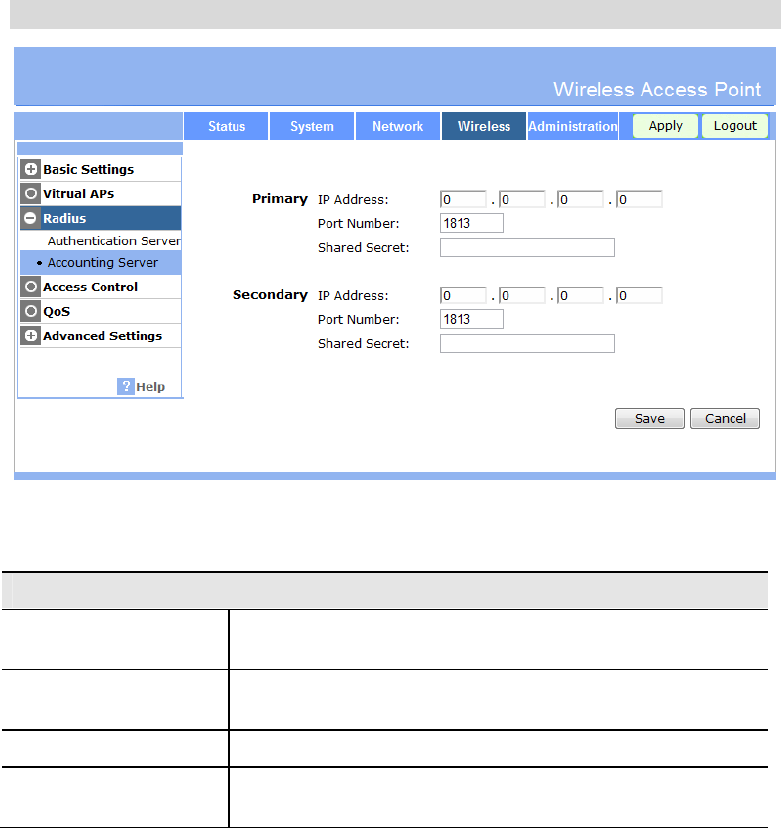
Wireless Access Point User Guide
38
Accounting Server
Figure 30: Accounting Server Screen
Data - Accounting Server Screen
Accounting Server
Primary IP Address Enter the IP address in the following fields if you want this
Access Point to send accounting data to the Radius Server.
Port Number The port used by your Radius Server must be entered in the
field.
Shared Secret Enter the key value to match the Radius Server.
Secondary IP Address The Secondary Accounting Server will be used when the
Primary Accounting Server is not available.
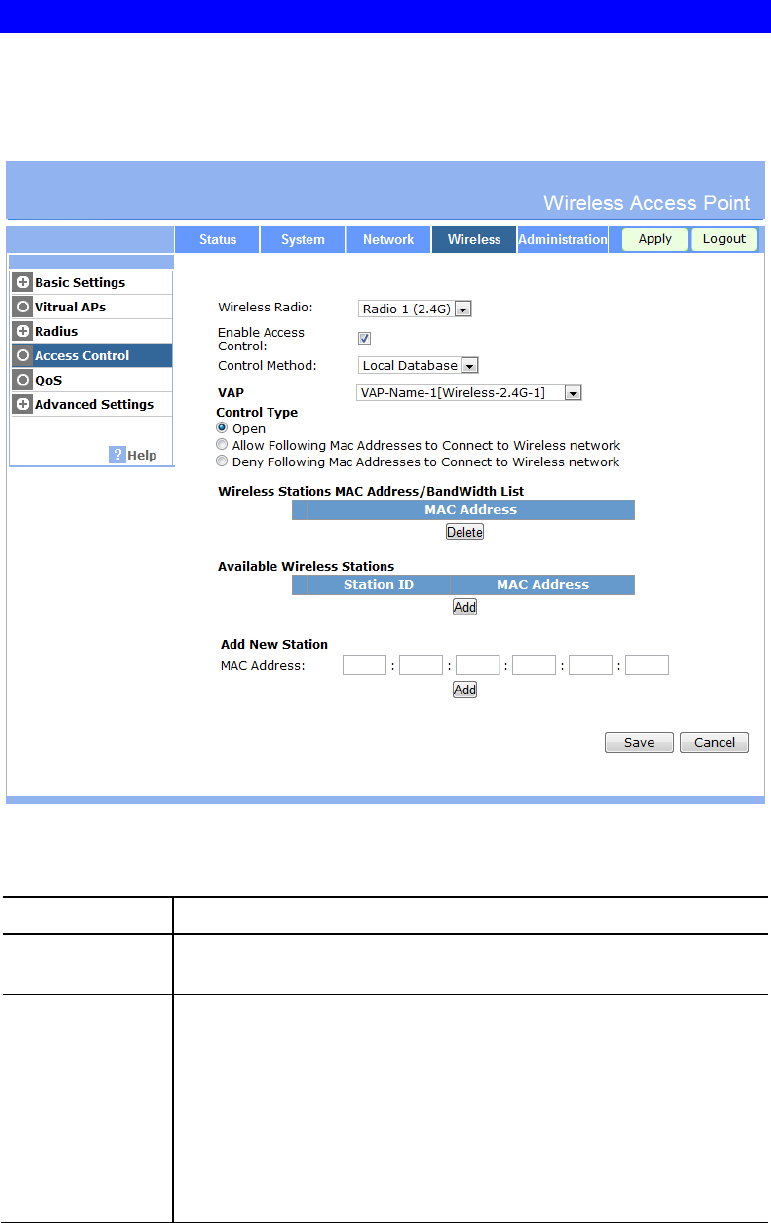
Access Point Setup
39
Wireless - Access Control
This feature can be used to block access to your LAN by unknown or untrusted wireless
stations.
Click Access Control on the Wireless menu to view a screen like the following.
Figure 31: Access Control Screen
Data - Access Control Screen
Wireless Radio Select the either Radio 1 or Radio 2 for the wireless feature.
Enable Access
Control Enable or Disable the Access Control feature as required.
Control Method Select the desired option, as required
Local Database- The device will use the local MAC address table
for Access Control.
RADIUS Server- The Access Point will use the MAC address
table located on the external Radius server on the LAN for Access
Control.
Warning ! Ensure your own PC is in the "Trusted Wireless Stations"
list before enabling this feature.

Wireless Access Point User Guide
40
Control Type There are three options:
Open
Allow Following MAC Addresses to Connect to Wireless
network - It's only used for Access Control with Local
Database. If selected, then clients with MAC Addresses in
Local Database can connect to the wireless network.
Deny Following MAC Addresses to Connect to Wireless
network - It's only used for Access Control with Local Data-
base. If selected, then clients with MAC Addresses in Local
Database cannot connect to the wireless network.
Wireless Stations
MAC Address
List
All Wireless Stations defined in Local Database are listed here. Use the
"Delete" button to delete the items from the list.
Available
Wireless Stations All Wireless Stations connecting to the device are listed here. You can
choose some stations from the list and click "Add" button to add them
into Local Database.
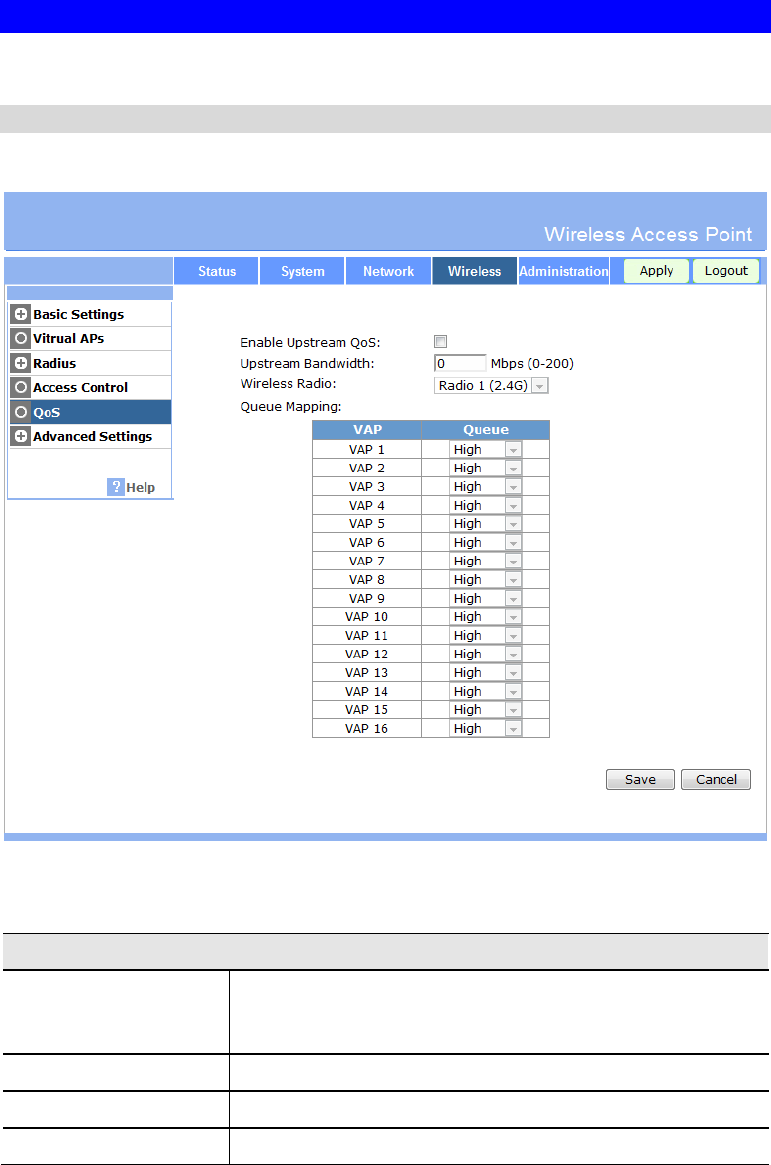
Access Point Setup
41
Wireless - QoS Settings
QoS Screen
Clicking the QoS link on the Wireless menu will result in a screen like the following.
Figure 32: QoS Screen
Data - QoS Screen
Parameters
Enable Upstream QoS Enable or Disable upstream QoS of Ethernet Port. The QoS
includes four outbound priority queues. The packets from high
priority queue will be processed first.
Upstream Bandwidth Specify the maximum upstream bandwidth of the AP.
Wireless Radio Select the desired radio to configure the queue mappings.
Queue Mapping Define the mapping for the queues.
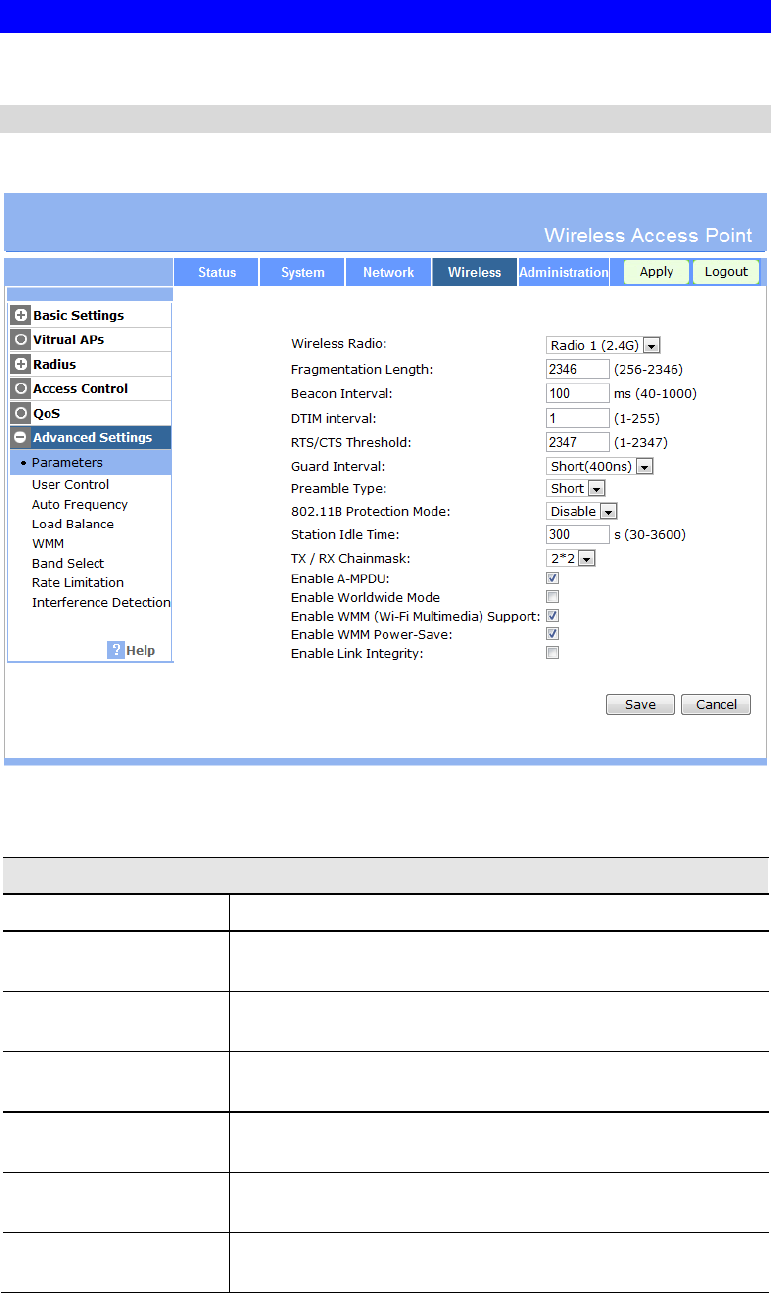
Wireless Access Point User Guide
42
Wireless - Advanced Settings
Parameters Screen
Clicking the Parameters link on the Wireless menu will result in a screen like the following.
Figure 33: Parameters Screen
Data - Parameters Screen
Parameters
Wireless Radio Select the either Radio 1 or Radio 2 for the wireless feature.
Fragmentation Length Enter the preferred setting between 256 and 2346. Normally,
this can be left at the default value.
Beacon Interval Enter the preferred setting between 20 and 1000. Normally, this
can be left at the default value.
DTIM Interval Enter the preferred setting between 1 and 255. Normally, this
can be left at the default value.
RTS/CTS Threshold Enter the preferred setting between 1 and 2347. Normally, this
can be left at the default value.
Guard Interval Select the guard interval manually for Wireless-N connections.
The two options are Short (400ns) and Long (800ns).
Preamble Type Select the desired option. The default is "Long". The "Short"
setting takes less time when used in a good environment.

Access Point Setup
43
802.11b Protection
Mode The Protection system is intended to prevent older 802.11b
devices from interfering with 802.11g transmissions. (Older
802.11b devices may not be able to detect that the 802.11g
transmission is in progress.)
Station Idle Time This indicates the time (seconds) of the station whose node will
be deleted from AP if there is no traffic for the link.
TX/RX Chainmask Select the desired TX/RX chainmask.
Enable A-MPDU Enable this setting if you wish to use this feature.
Enable Worldwide
Mode Enable this setting if you want to use this mode, and your
Wireless stations also support this mode.
Enable WMM (Wi-Fi
Multimedia) Support Check this to enable WMM (Wi-Fi Multimedia) support in the
Access Point. If WMM is also supported by your wireless
clients, voice and multimedia traffic will be given a higher
priority than other traffic.
Enable WMM Power-
Save Enable or Disable WMM Power-Save feature.
Enable Link Integrity If enabled, the device can detect the plugging or unplugging of
the Ethernet cable and start/stop the related services
correspondingly.
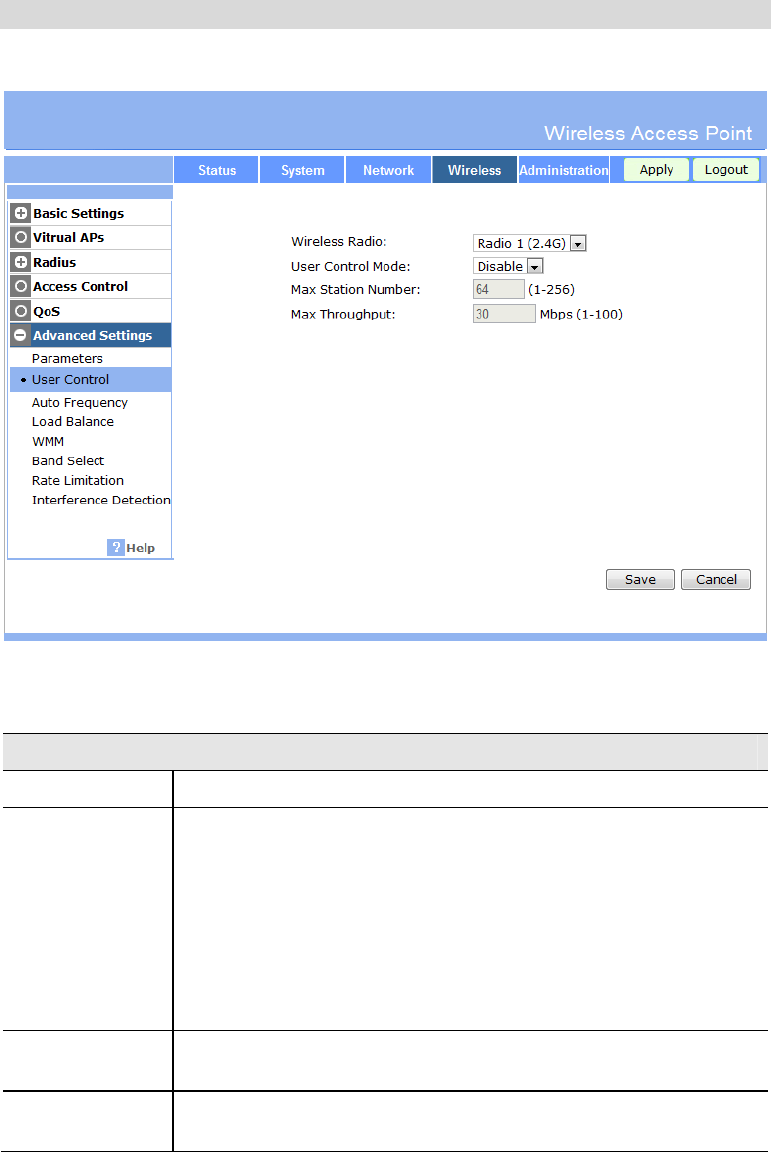
Wireless Access Point User Guide
44
User Control Screen
Click User Control on the Wireless menu to view a screen like the following:
Figure 34: User Control Screen
Data - User Control Screen
User Control
Wireless Radio Select the either Radio 1 or Radio 2 for the wireless feature.
User Control
Mode Select the method of controlling the Wireless Stations. It can be one of
following options:
Disable - This function is disabled.
Users - In this mode, number of Wireless Stations that can connect
this device is limited to the specified value.
Flux - In this mode, if total throughput of the device reaches the
specified value, the Wireless Stations will refuse to connect the
device.
Max Station
Number Enter the maximum number (1~256) of wireless stations connecting to
the device.
Max
Throughput Enter the desired number between 1 and 100 for the maximum
throughput.
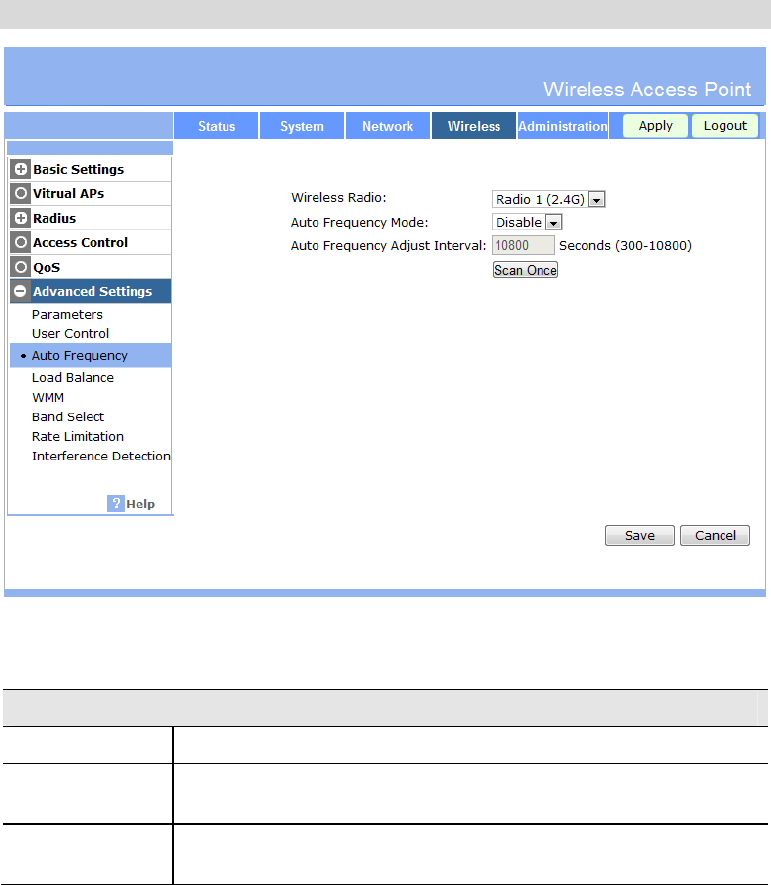
Access Point Setup
45
Auto Frequency Screen
Figure 35: Auto Frequency Screen
Data - Auto Frequency Screen
Auto Frequency
Wireless Radio Select the either Radio 1 or Radio 2 for the wireless feature.
Auto Frequency
Mode If enabled, the device can adjust its wireless channel at a specified
interval.
Auto Frequency
Adjust Interval Specify the interval at which the device will scan and adjust its
wireless channel.
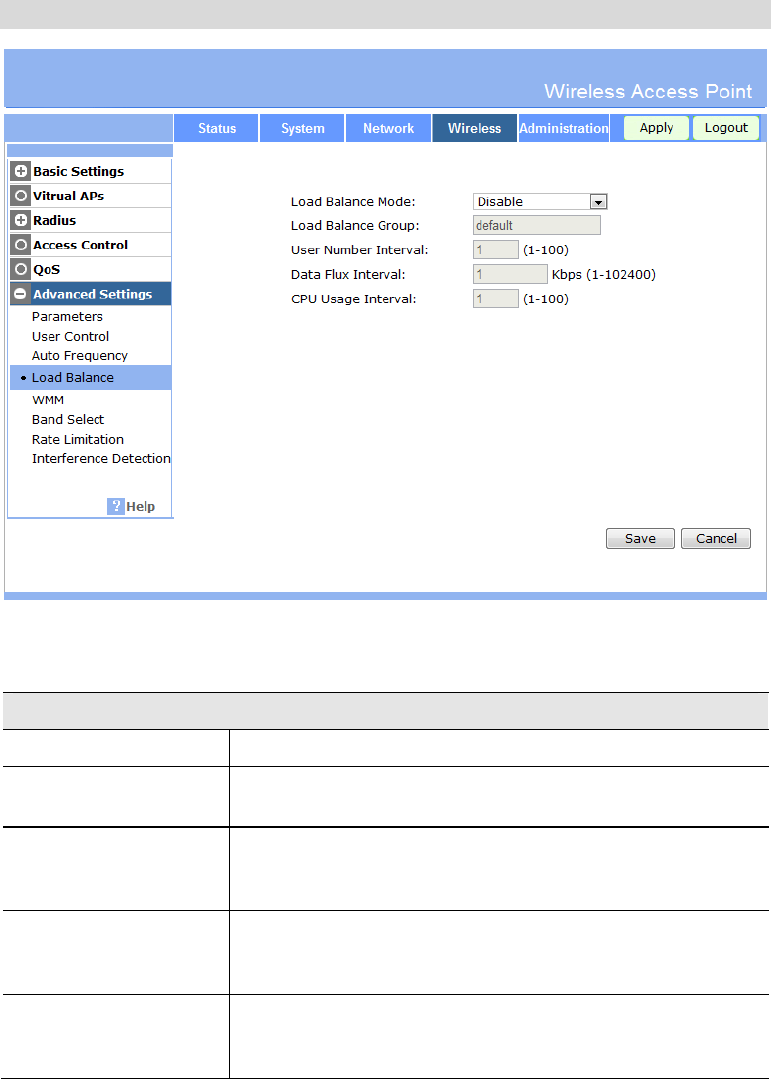
Wireless Access Point User Guide
46
Load Balance Screen
Figure 36: Load Balance Screen
Data - Load Balance Screen
Load Balance
Load Balance Mode Enable or disable this function.
Load Balance Group Specify the group name. The feature will only work with the
Access Points that are in same group.
User Number Interval Specify the User Number Interval. When user number
difference of Access Points reaches the interval, the new client
will connect to the Access Point with fewer users.
Data Flux Interval Specify the Data Flux Interval here. When data flux difference
of Access Points reach the interval, the new client will connect
to the Access Point with fewer data flow.
CPU Usage Interval Specify the CPU Usage Interval. When CPU usage difference
of Access Points reaches the interval, the new client will
connect to the Access Point with fewer users.
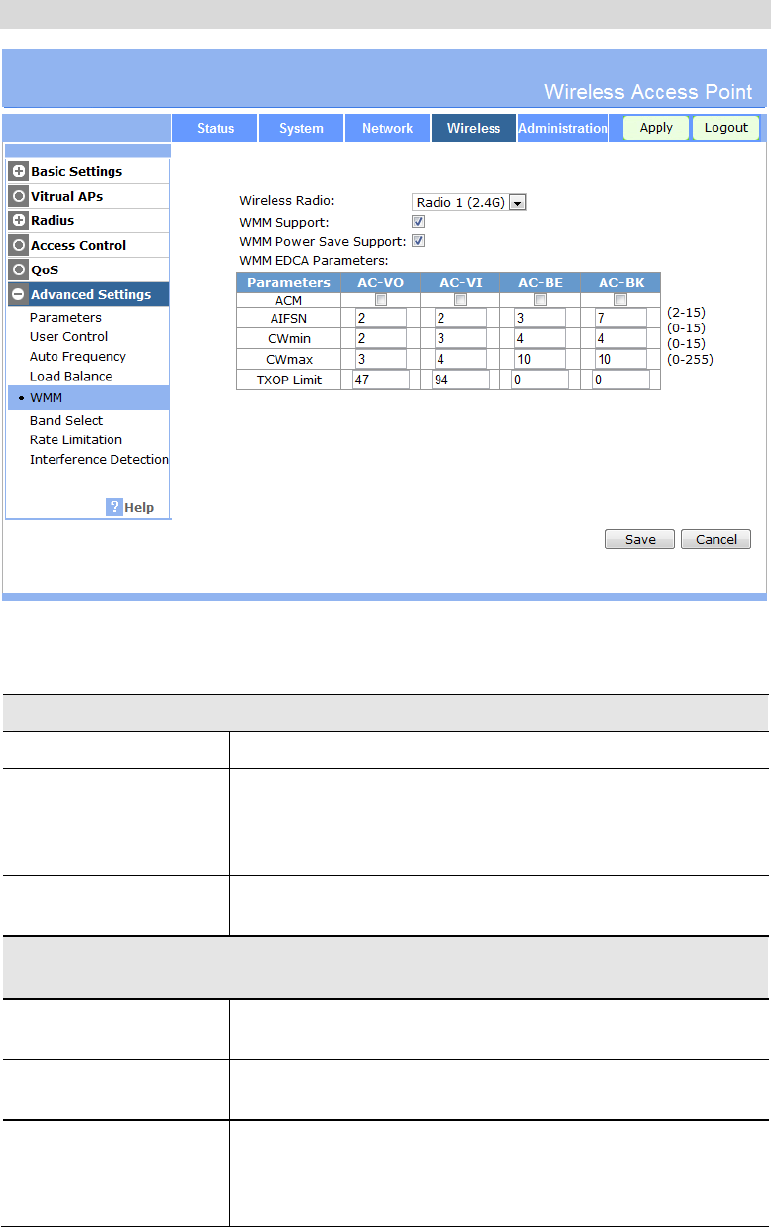
Access Point Setup
47
WMM Screen
Figure 37: WMM Screen
Data - WMM Screen
WMM
Wireless Radio Select the desired radio option from the list.
WMM Support Check this to enable WMM (Wi-Fi Multimedia) support. This
feature is also supported by your wireless clients, whose voice
and multimedia traffic will be given a higher priority than other
traffic.
WMM Power Save
Support Enable or disable WMM Power-Save feature
WMM EDCA Parameters (When the Number of Spatial Streams≥ 2,Can
support static and dynamic Spatial Multiplexing Power Saving.
ACM ACM (Admission Control Mandatory) is used to restrict
stations from using a specific AC.
AIFSN Specify the AIFSN (Arbitration Interframe Space) of the AC
here. The idle duration increases as the AIFSN value increases.
CWmin/CWmax CWmin (Minimum Contention Windows) and CWmax (Maxi-
mum Contention Windows) determine the
average backoff slots, which increases as the two values in-
crease. CWMax value must be greater than or equal to CWMin.
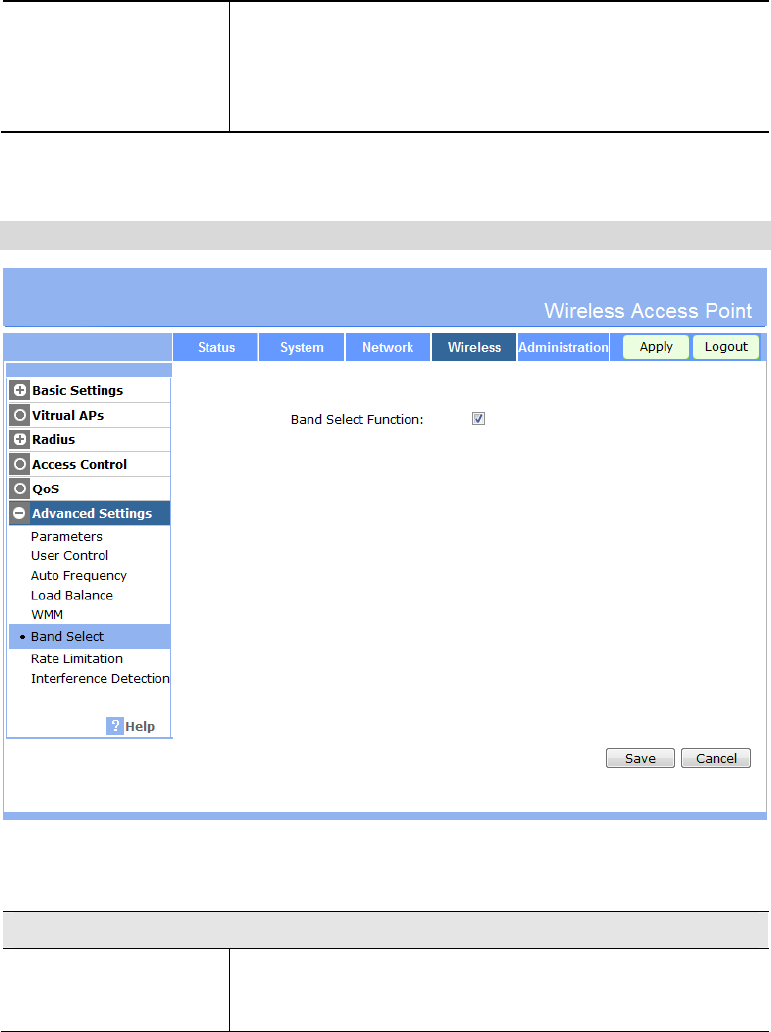
Wireless Access Point User Guide
48
TXOPlimit Transmission opportunity limit (TXOPLimit) indicates the
maximum time, which a user can use a channel after a
successful contention. The greater the TXOPLimit is, the longer
the user can use the channel. The value 0 indicates that the user
can send only one packet each time when it uses the channel.
Band Select Screen
Figure 38: Band Select Screen
Data - Band Select Screen
Band Select
Band Select Function When 2.4G radio and 5G radio are both enabled, and both have
the same SSIDs, this function will force dual band (2.4G & 5G)
clients to connect with 5G channel.
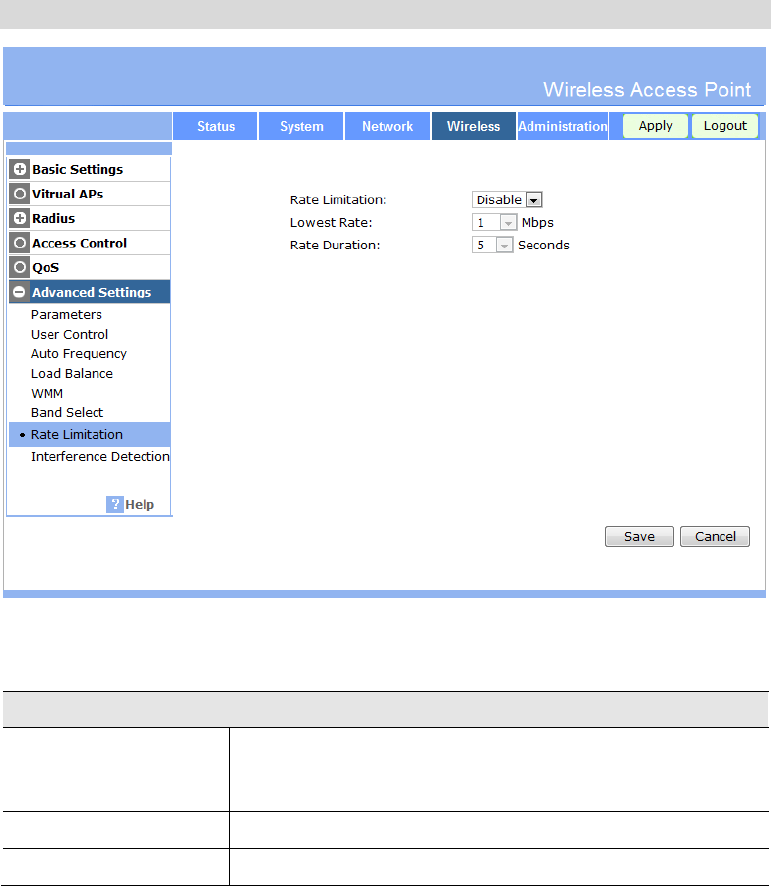
Access Point Setup
49
Rate Limitation Screen
Figure 39: Rate limitation Screen
Data - Rate limitation Screen
Rate limitation
Rate Limitation If this feature is enabled, it will be disconnected when one
wireless client's link rate is lower than the specified lowest rate
in a specified duration.
Lowest Rate Select the lowest rate from the list.
Rate Duration Choose the desired duration from the drop-down list.
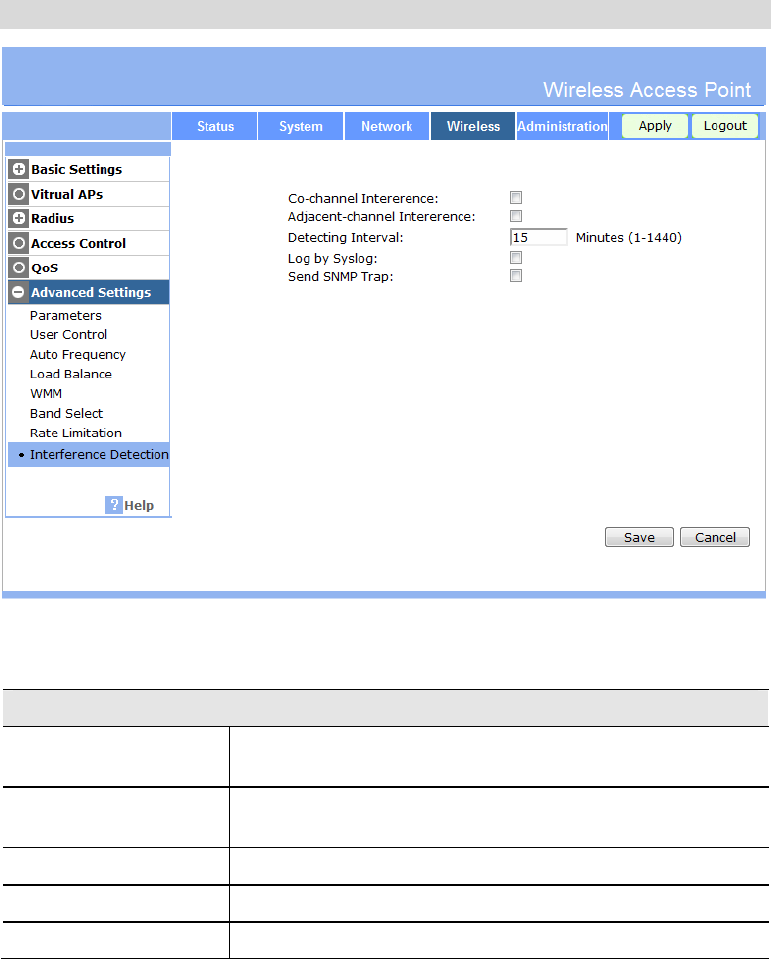
Wireless Access Point User Guide
50
Interference Detection Screen
Figure 40: Interference Detection Screen
Data - Interference Detection Screen
Interference Detection
Co-channel
Interference Check it to enable the detecting interference of APs with same
channels.
Adjacent-channel
Interference Check it to enable the detecting interference of APs with adja-
cent channels.
Detecting Interval Specify the interval for detecting.
Log by Syslog Enable it if you want to use this function.
Send SNMP Trap Send the results of interference by SNMP trap if enabled.
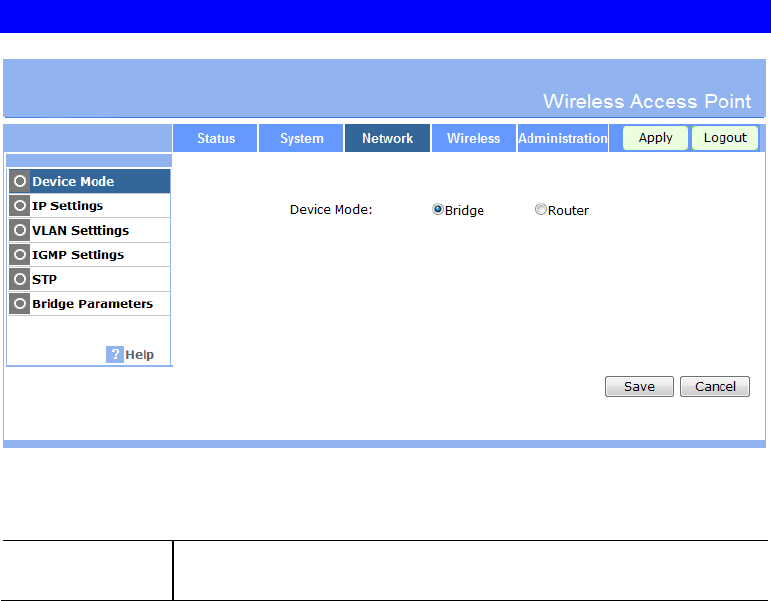
Access Point Setup
51
Network - Device Mode Screen
Figure 41: Device Mode Screen
Data - Device Mode Screen
Device Mode If bridge mode is selected, then the device will act as an Access Point.
If router mode is selected, then the device will act as a router.
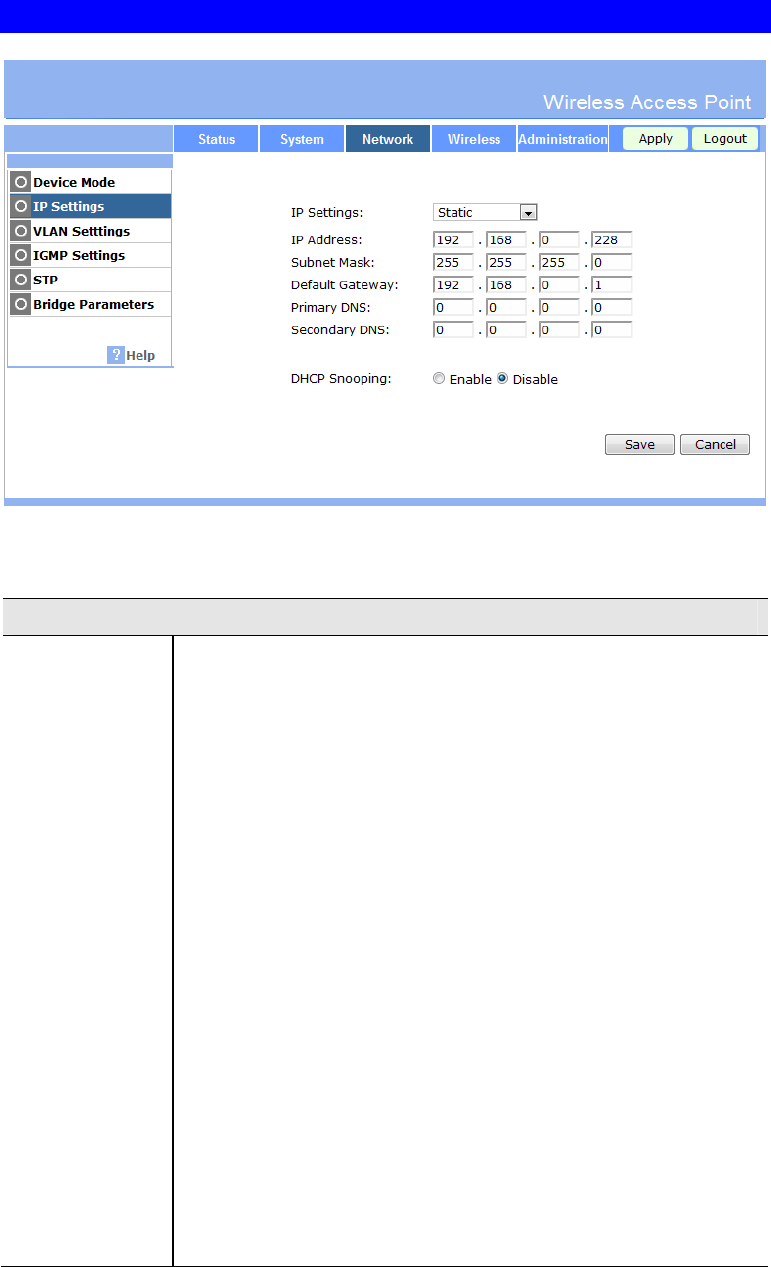
Wireless Access Point User Guide
52
Network - IP Settings Screen
Figure 42: IP Settings Screen
Data - IP Settings Screen
IP Settings
IP Settings Select the desired option from the drop-down list.
Static - Select it if you want to configure one static IP Address for
the Access Point. You need input following settings:
IP Address: The IP Address of this device.
Subnet Mask: The Network Mask associated with the IP
|Address above.
Default Gateway: The IP Address of your Gateway or Router.
Primary DNS: Specify a primary DNS here. It's necessary for
functions like NTP Client, E-Mail alert and so on.
Secondary DNS: Specify a secondary DNS here. It's optional.
DHCP Client - Select it if you want the device to obtain an IP
address automatically.
PPPoE Client - This is the most common login method, widely
used with DSL modems.
Username - The user name (or account name) provided by
your ISP.
Password - Enter the password for the login name above.
Timeout - Enter the desired value in seconds for the timeout
period.
Retry - Enter the retry times for the PPPoE connection.
Auth-Type - Choose the desired option from the list.
MTU - Enter the number between 128 and 1492 for MTU.

Access Point Setup
53
AC IP Address Enter the IP address for the AC. It's necessary when the IP Settings is
"Static".
AC DNS Name 1 Enter the primary DNS name for the AC.
AC DNS Name 2 Enter the secondary DNS name for the AC. It is optional.
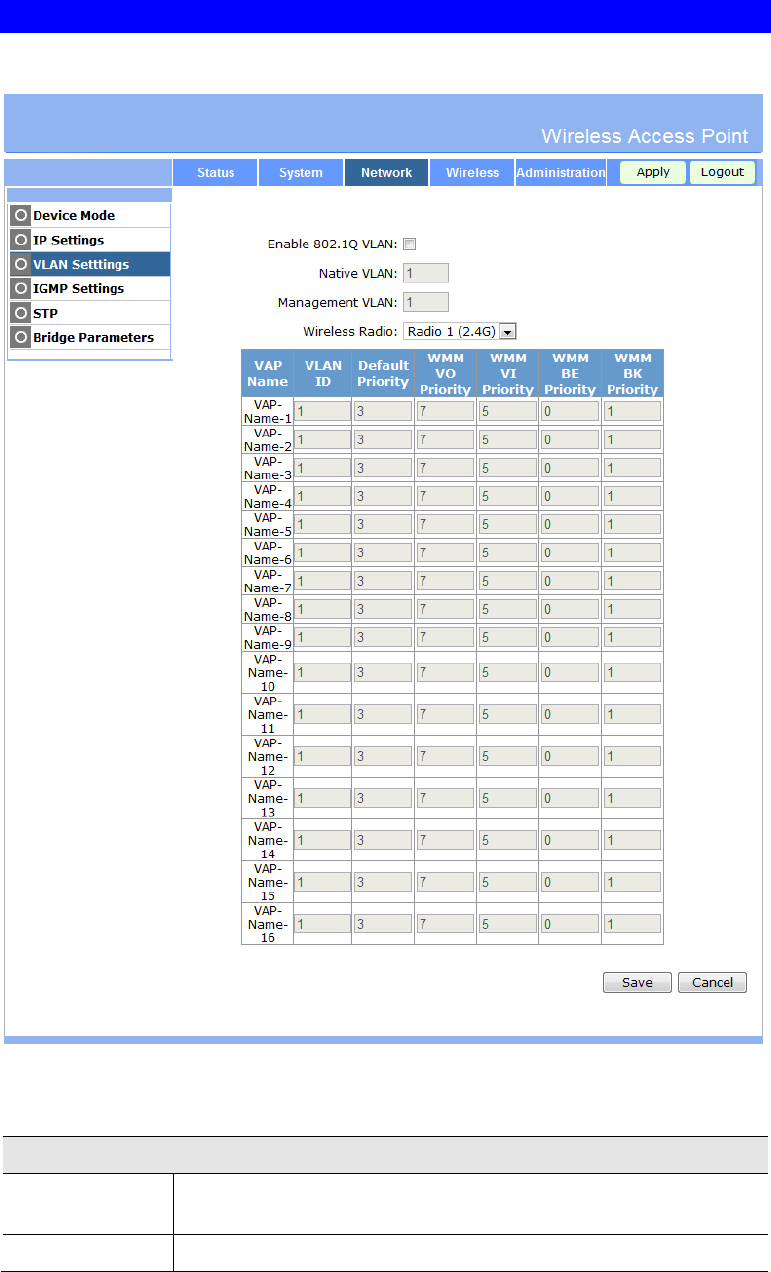
Wireless Access Point User Guide
54
Network - VLAN Settings Screen
Figure 43: VLAN Settings Screen
Data - VLAN Settings Screen
VLAN Settings
Enable 802.1Q
VLAN This option is only useful if the hubs/switches on your LAN support
the VLAN standard.
Native VLAN Enter the value for Native VLAN.

Access Point Setup
55
Management
VLAN Define the VLAN ID used for management.
Wireless Radio Select the desired option from the list.
VLAN Table 802.1p setting: Enter the values for VLAN ID, Default Priority, WMM
VO Priority, WMM VI Priority, WMM BE Priority, WMM BK
Priority in the table.
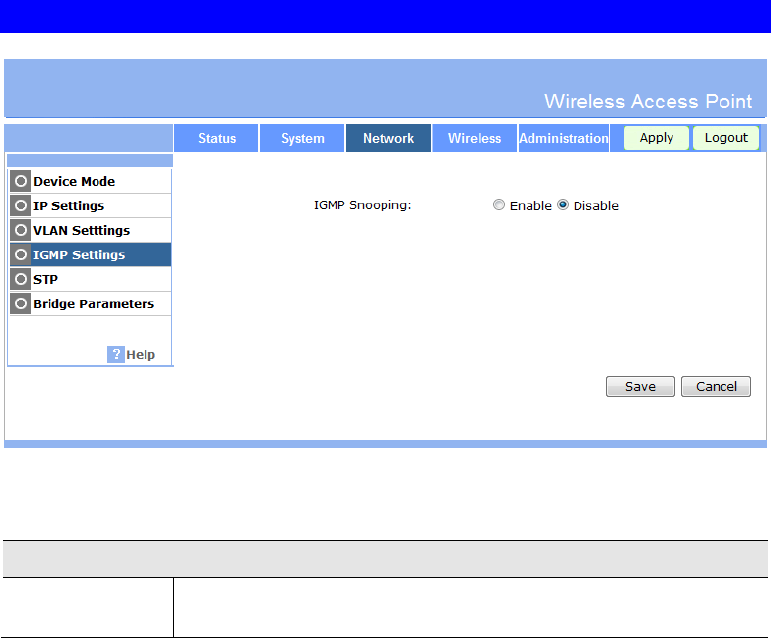
Wireless Access Point User Guide
56
Network - IGMP Settings Screen
Figure 44: IGMP Settings Screen
Data - IGMP Settings Screen
IGMP Settings
IGMP Snooping This option is only useful if the hubs/switches on your LAN support
the VLAN standard.
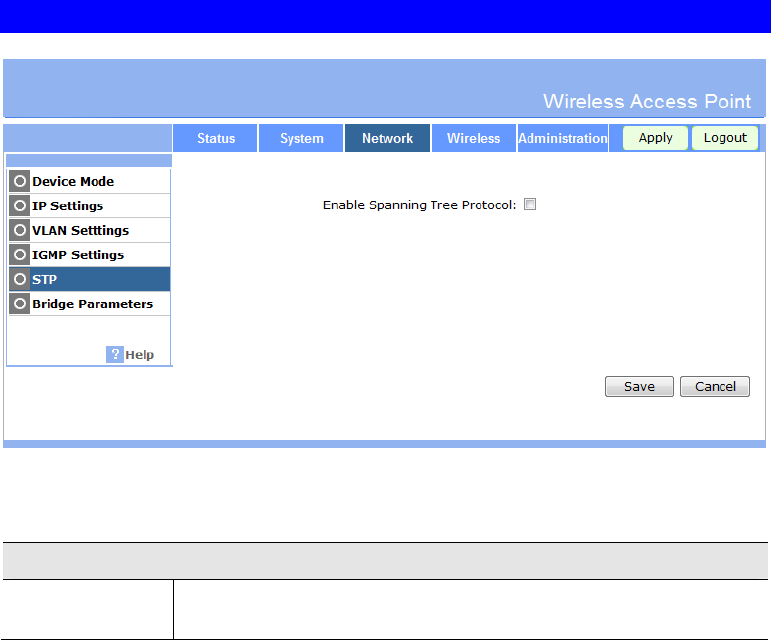
Access Point Setup
57
Network - STP Screen
Figure 45: STP Screen
Data - STP Screen
STP
Enable Spanning
Tree Protocol Enable this if you want to use this feature.
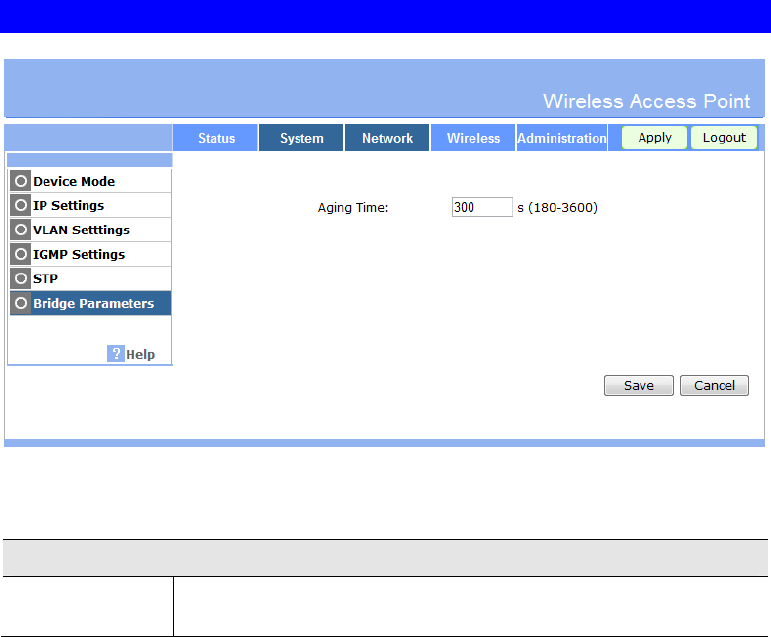
Wireless Access Point User Guide
58
Network - Bridge Parameters Screen
Figure 46: Bridge Parameters Screen
Data - Bridge Parameters Screen
Bridge Parameters
Ageing Time This value indicates the ageing time on the bridge. If it is timeout, this
station will be removed from the bridge table.

59
Chapter 4
PC and Server Configuration
This Chapter details the PC Configuration required for each PC on the local
LAN.
Overview
All Wireless Stations need to have settings which match the Wireless Access Point. These
settings depend on the mode in which the Access Point is being used.
If using WEP or WPA-PSK, it is only necessary to ensure that each Wireless station's
settings match those of the Wireless Access Point, as described below.
For 802.1x modes, configuration is much more complex. The Radius Server must be
configured correctly, and setup of each Wireless station is also more complex.
Using WEP
For each of the following items, each Wireless Station must have the same settings as the
Wireless Access Point.
Mode On each PC, the mode must be set to Infrastructure.
SSID (ESSID) This must match the value used on the Wireless Access Point.
The default value is wireless
Note! The SSID is case sensitive.
Wireless
Security
Each Wireless station must be set to use WEP data encryption.
The Key size (64 bit, 128 bit, 152 bit) must be set to match the
Access Point.
The keys values on the PC must match the key values on the Access
Point.
Note:
On some systems, the key sizes may be shown as 40bit, 104bit, and
128bit instead of 64 bit, 128 bit and 152bit. This difference arises be-
cause the key input by the user is 24 bits less than the key size used for
encryption.
4

Wireless Access Point User Guide
60
Using WPA-PSK/WPA2-PSK
For each of the following items, each Wireless Station must have the same settings as the
Wireless Access Point.
Mode On each PC, the mode must be set to Infrastructure.
SSID (ESSID) This must match the value used on the Wireless Access Point.
The default value is wireless
Note! The SSID is case sensitive.
Wireless
Security On each client, Wireless security must be set to WPA-PSK.
The Pre-shared Key entered on the Access Point must also be
entered on each Wireless client.
The Encryption method (e.g. TKIP, AES) must be set to match the
Access Point.

PC and Server Configuration
61
Using WPA-Enterprise
This is the most secure and most complex system.
WPA-Enterprise mode provides greater security and centralized management, but it is more
complex to configure.
Wireless Station Configuration
For each of the following items, each Wireless Station must have the same settings as the
Wireless Access Point.
Mode On each PC, the mode must be set to Infrastructure.
SSID (ESSID) This must match the value used on the Wireless Access Point.
The default value is wireless
Note! The SSID is case sensitive.
802.1x
Authentication Each client must obtain a Certificate which is used for authentication for
the Radius Server.
802.1x
Encryption Typically, EAP-TLS is used. This is a dynamic key system, so keys do
NOT have to be entered on each Wireless station.
However, you can also use a static WEP key (EAP-MD5); the Wireless
Access Point supports both methods simultaneously.
Radius Server Configuration
If using WPA-Enterprise mode, the Radius Server on your network must be configured as
follow:
It must provide and accept Certificates for user authentication.
There must be a Client Login for the Wireless Access Point itself.
The Wireless Access Point will use its Default Name as its Client Login name. (How-
ever, your Radius server may ignore this and use the IP address instead.)
The Shared Key, set on the Security Screen of the Access Point, must match the
Shared Secret value on the Radius Server.
Encryption settings must be correct.

Wireless Access Point User Guide
62
802.1x Server Setup (Windows 2000 Server)
This section describes using Microsoft Internet Authentication Server as the Radius Server,
since it is the most common Radius Server available that supports the EAP-TLS authentication
method.
The following services on the Windows 2000 Domain Controller (PDC) are also required:
dhcpd
dns
rras
webserver (IIS)
Radius Server (Internet Authentication Service)
Certificate Authority
Windows 2000 Domain Controller Setup
1. Run dcpromo.exe from the command prompt.
2. Follow all of the default prompts, ensure that DNS is installed and enabled during installa-
tion.
Services Installation
1. Select the Control Panel - Add/Remove Programs.
2. Click Add/Remove Windows Components from the left side.
3. Ensure that the following components are activated (selected):
Certificate Services. After enabling this, you will see a warning that the computer
cannot be renamed and joined after installing certificate services. Select Yes to select
certificate services and continue
World Wide Web Server. Select World Wide Web Server on the Internet Information
Services (IIS) component.
From the Networking Services category, select Dynamic Host Configuration Protocol
(DHCP), and Internet Authentication Service (DNS should already be selected and in-
stalled).
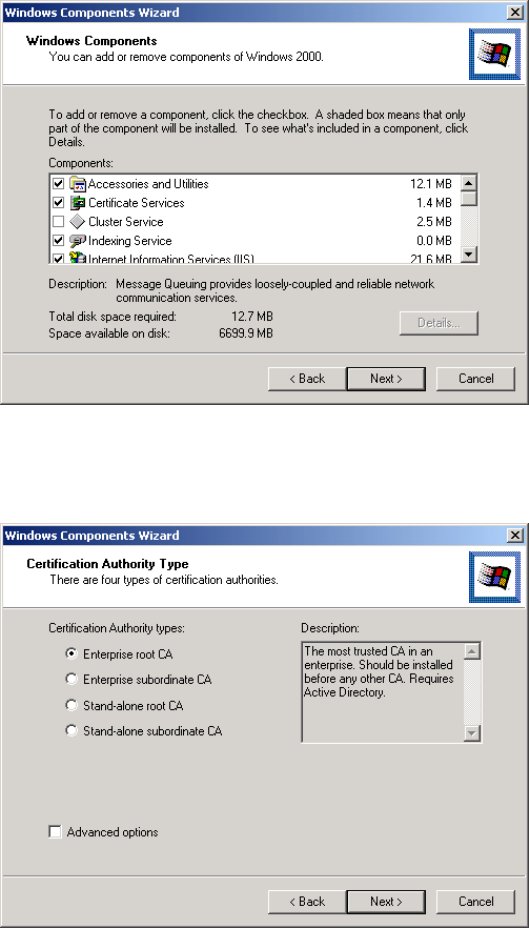
PC and Server Configuration
63
Figure 47: Components Screen
4. Click Next.
5. Select the Enterprise root CA, and click Next.
Figure 48: Certification Screen
6. Enter the information for the Certificate Authority, and click Next.
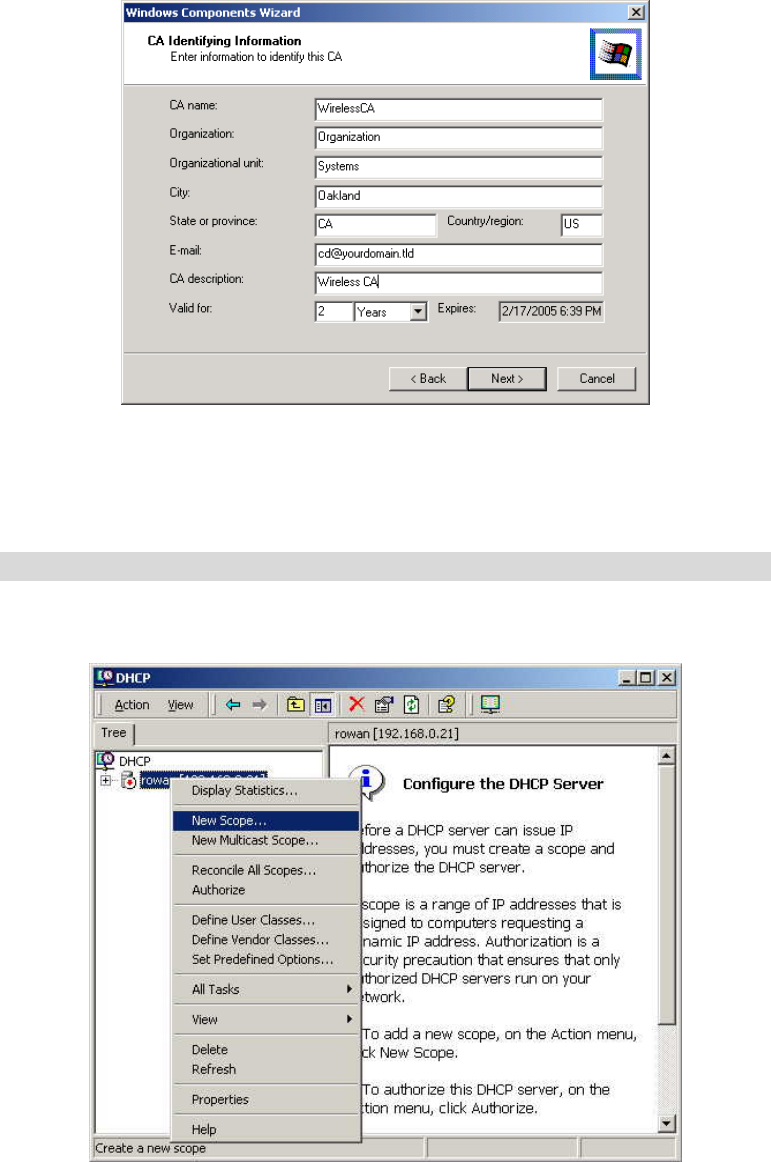
Wireless Access Point User Guide
64
Figure 49: CA Screen
7. Click Next if you don't want to change the CA's configuration data.
8. Installation will warn you that Internet Information Services are running, and must be
stopped before continuing. Click Ok, then Finish.
DHCP server configuration
1. Click on the Start - Programs - Administrative Tools - DHCP
2. Right-click on the server entry as shown, and select New Scope.
Figure 50: DHCP Screen
3. Click Next when the New Scope Wizard Begins.
4. Enter the name and description for the scope, click Next.
5. Define the IP address range. Change the subnet mask if necessary. Click Next.
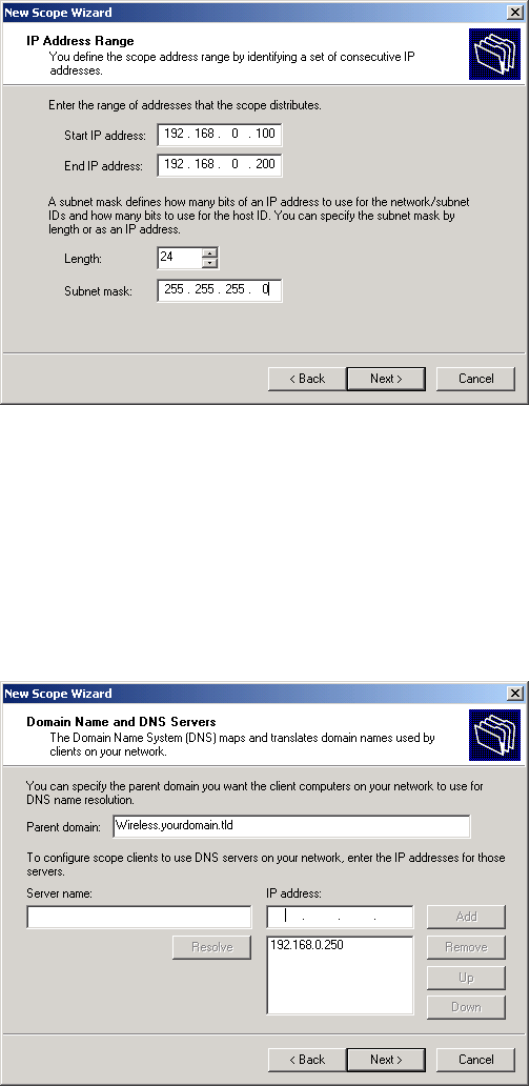
PC and Server Configuration
65
Figure 51: IP Address Screen
6. Add exclusions in the address fields if required. If no exclusions are required, leave it
blank. Click Next.
7. Change the Lease Duration time if preferred. Click Next.
8. Select Yes, I want to configure these options now, and click Next.
9. Enter the router address for the current subnet. The router address may be left blank if
there is no router. Click Next.
10. For the Parent domain, enter the domain you specified for the domain controller setup, and
enter the server's address for the IP address. Click Next.
Figure 52: DNS Screen
11. If you don't want a WINS server, just click Next.
12. Select Yes, I want to activate this scope now. Click Next, then Finish.
13. Right-click on the server, and select Authorize. It may take a few minutes to complete.
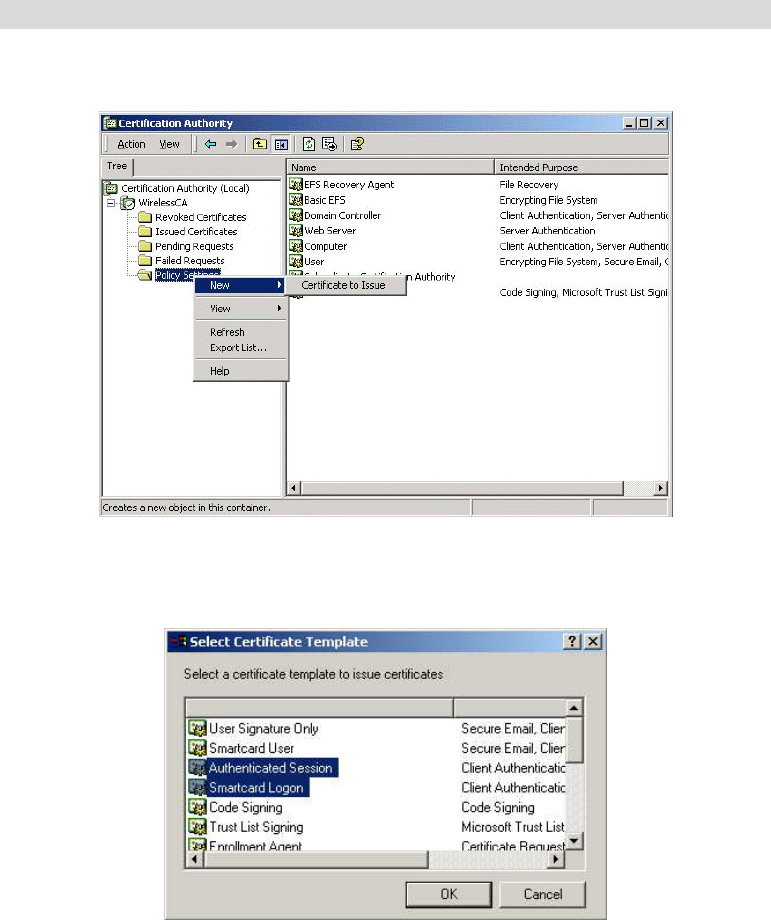
Wireless Access Point User Guide
66
Certificate Authority Setup
1. Select Start - Programs - Administrative Tools - Certification Authority.
2. Right-click Policy Settings, and select New - Certificate to Issue.
Figure 53: Certificate Authority Screen
3. Select Authenticated Session and Smartcard Logon (select more than one by holding down
the Ctrl key). Click OK.
Figure 54: Template Screen
4. Select Start - Programs - Administrative Tools - Active Directory Users and Computers.
5. Right-click on your active directory domain, and select Properties.
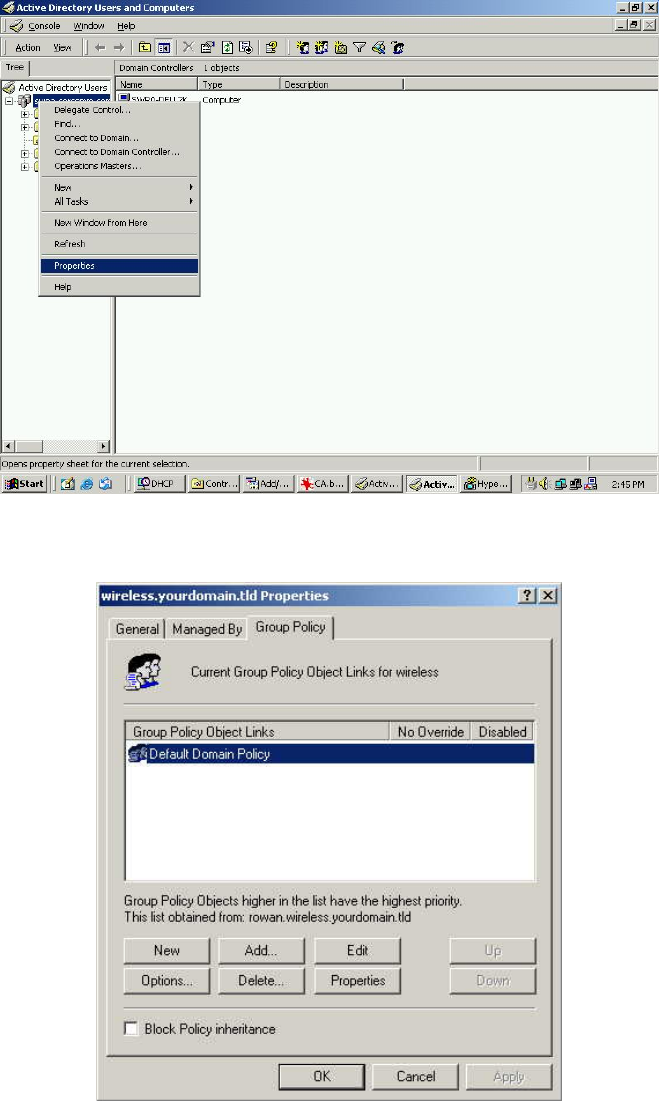
PC and Server Configuration
67
Figure 55: Active Directory Screen
6. Select the Group Policy tab, choose Default Domain Policy then click Edit.
Figure 56: Group Policy Tab
7. Select Computer Configuration - Windows Settings - Security Settings - Public Key
Policies, right-click Automatic Certificate Request Settings - New - Automatic Certificate
Request.
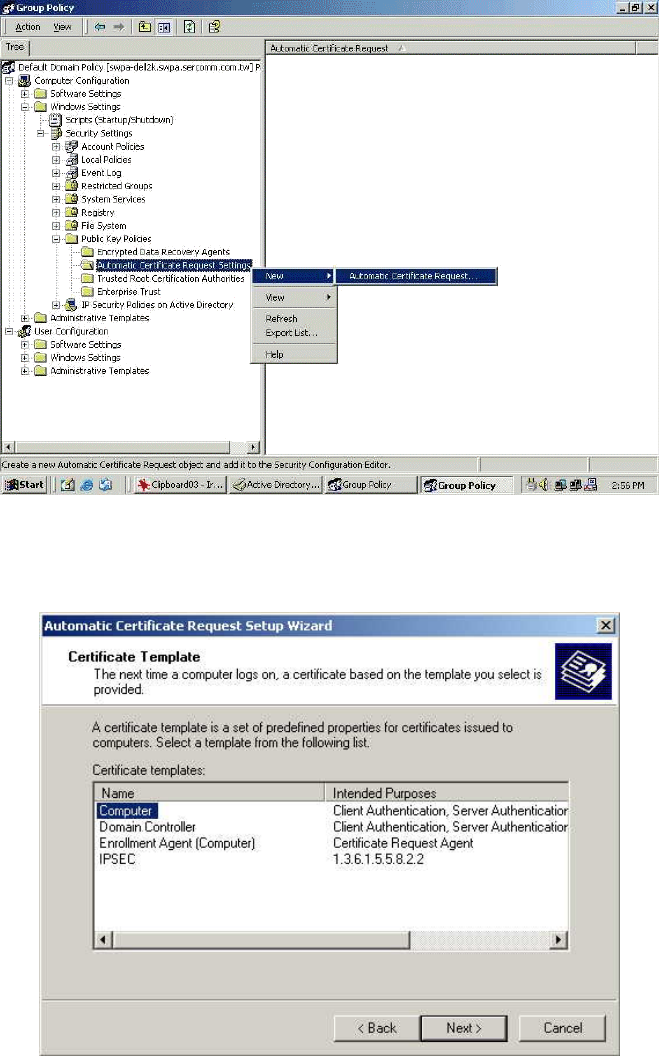
Wireless Access Point User Guide
68
Figure 57: Group Policy Screen
8. When the Certificate Request Wizard appears, click Next.
9. Select Computer, then click Next.
Figure 58: Certificate Template Screen
10. Ensure that your certificate authority is checked, then click Next.
11. Review the policy change information and click Finish.
12. Click Start - Run, type cmd and press enter.
Enter secedit /refreshpolicy machine_policy
This command may take a few minutes to take effect.
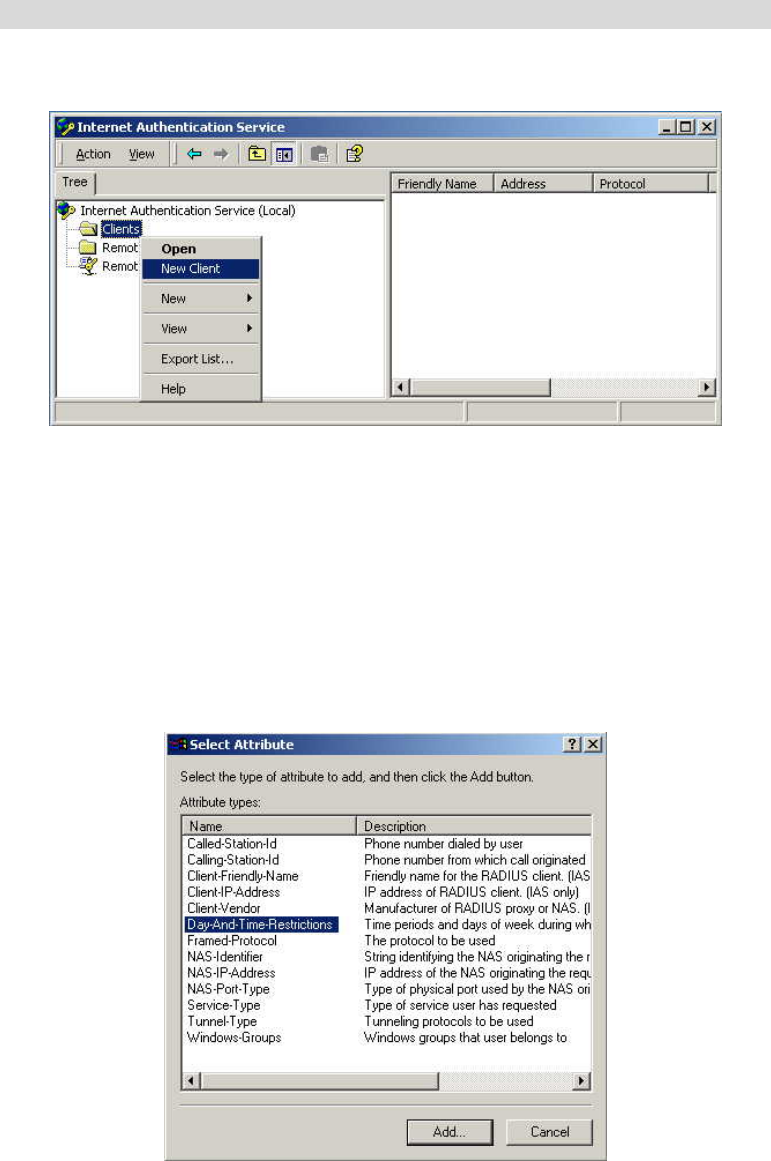
PC and Server Configuration
69
Internet Authentication Service (Radius) Setup
1. Select Start - Programs - Administrative Tools - Internet Authentication Service
2. Right-click on Clients, and select New Client.
Figure 59: Service Screen
3. Enter a name for the access point, click Next.
4. Enter the address or name of the Wireless Access Point, and set the shared secret, as
entered on the Security Settings of the Wireless Access Point.
5. Click Finish.
6. Right-click on Remote Access Policies, select New Remote Access Policy.
7. Assuming you are using EAP-TLS, name the policy eap-tls, and click Next.
8. Click Add...
If you don't want to set any restrictions and a condition is required, select Day-And-Time-
Restrictions, and click Add...
Figure 60: Attribute Screen
9. Click Permitted, then OK. Select Next.
10. Select Grant remote access permission. Click Next.
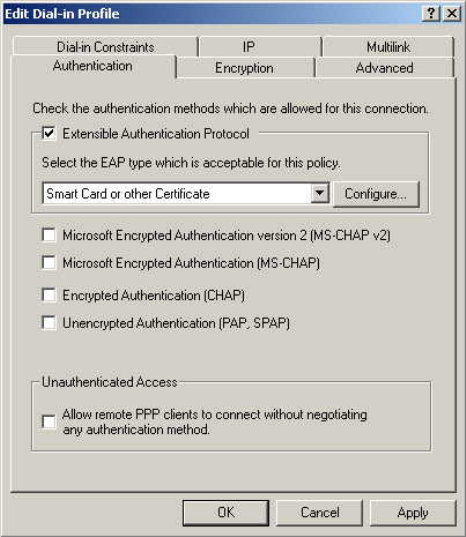
Wireless Access Point User Guide
70
11. Click Edit Profile... and select the Authentication tab. Enable Extensible Authentication
Protocol, and select Smart Card or other Certificate. Deselect other authentication meth-
ods listed. Click OK.
Figure 61: Authentication Screen
12. Select No if you don't want to view the help for EAP. Click Finish.
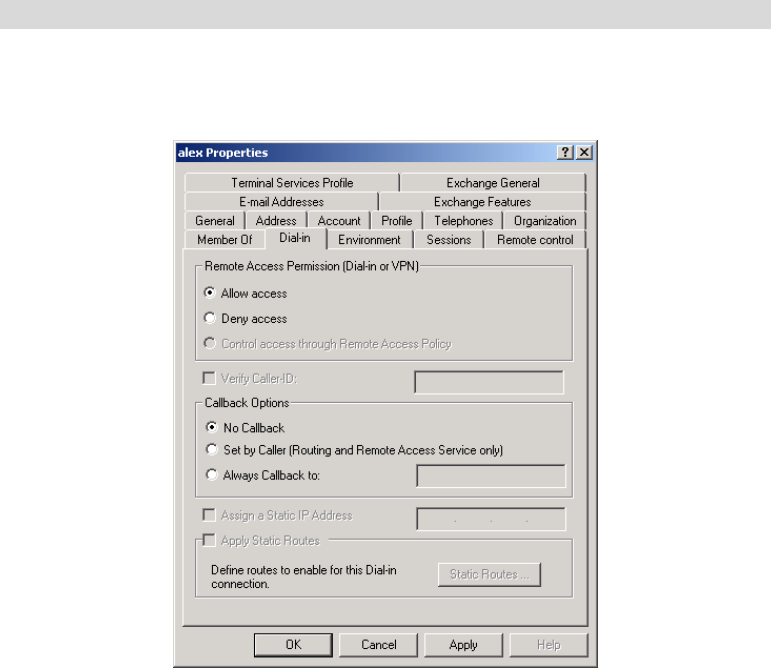
PC and Server Configuration
71
Remote Access Login for Users
1. Select Start - Programs - Administrative Tools- Active Directory Users and Computers.
2. Double click on the user who you want to enable.
3. Select the Dial-in tab, and enable Allow access. Click OK.
Figure 62: Dial-in Screen
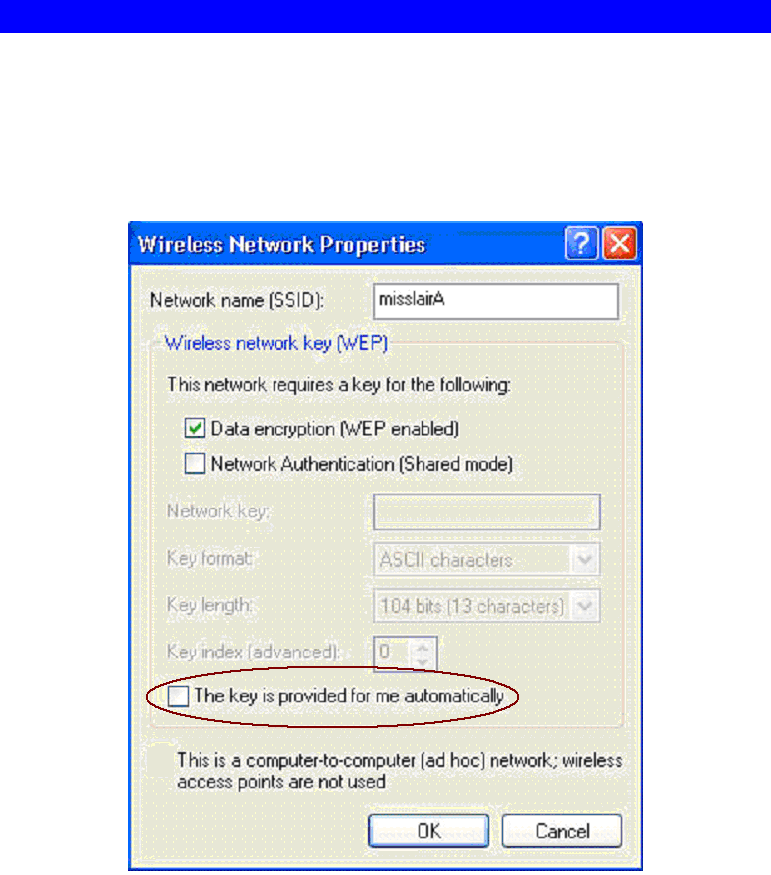
Wireless Access Point User Guide
72
Using 802.1x Mode (without WPA)
This is very similar to using WPA-Enterprise.
The only difference is that on your client, you must NOT enable the setting The key is provid-
ed for me automatically.
Instead, you must enter the WEP key manually, ensuring it matches the WEP key used on the
Access Point.
Figure 63: Properties Screen
Note:
On some systems, the "64 bit" WEP key is shown as "40 bit" and the "128 bit" WEP key is
shown as "104 bit". This difference arises because the key input by the user is 24 bits less than
the key size used for encryption.
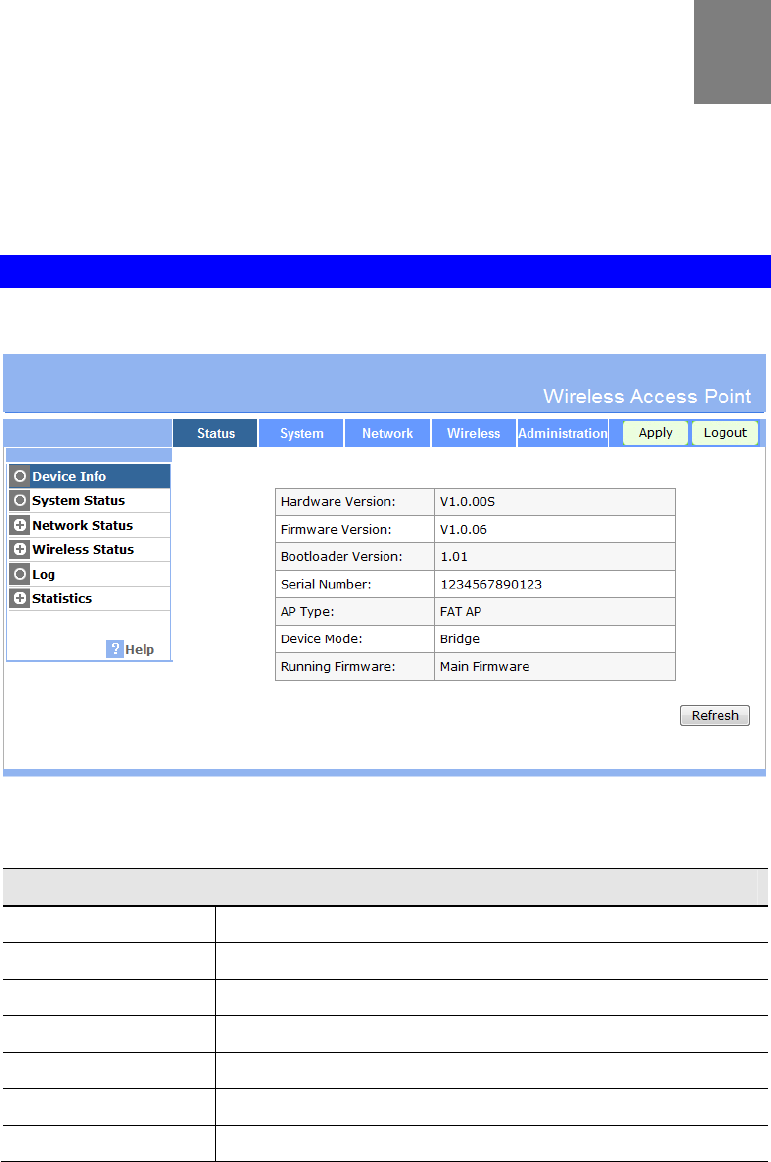
73
Chapter 5
Operation and Status
This Chapter details the operation of the Wireless Access Point and the status
screens.
Status Screen
Use the Status link on the main menu to view this screen.
Figure 64: Device Info Screen
Data - Device Info Screen
Access Point
Hardware Version The version of the hardware currently used.
Firmware Version The version of the firmware currently installed.
Bootloader Version The version of the bootloader currently used.
Serial Number The serial number of the device.
AP Type The current AP type is displayed.
Device Mode The current Device mode is displayed
Running Firmware The currently running firmware is displayed.
5
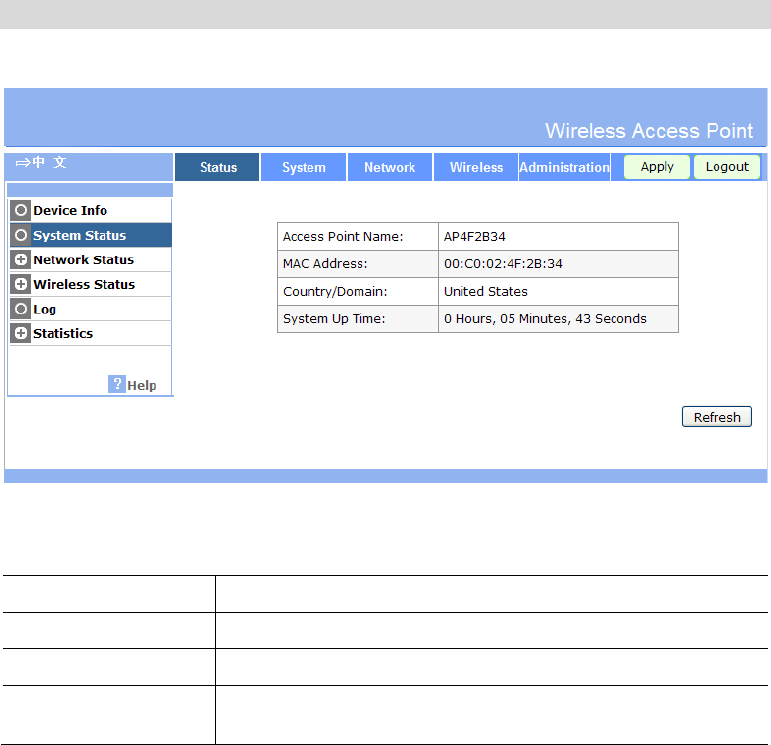
Wireless Access Point User Guide
74
System Status
This screen is displayed when the System Status button is clicked.
Figure 65: System Status Screen
Data - System Status Screen
Access Point Name The current name will be displayed.
MAC Address The MAC (physical) address of the Wireless Access Point.
Country/Domain The region or domain, as selected on the System screen.
System Up Time This indicates how long the system has been running since the
last restart or reboot.
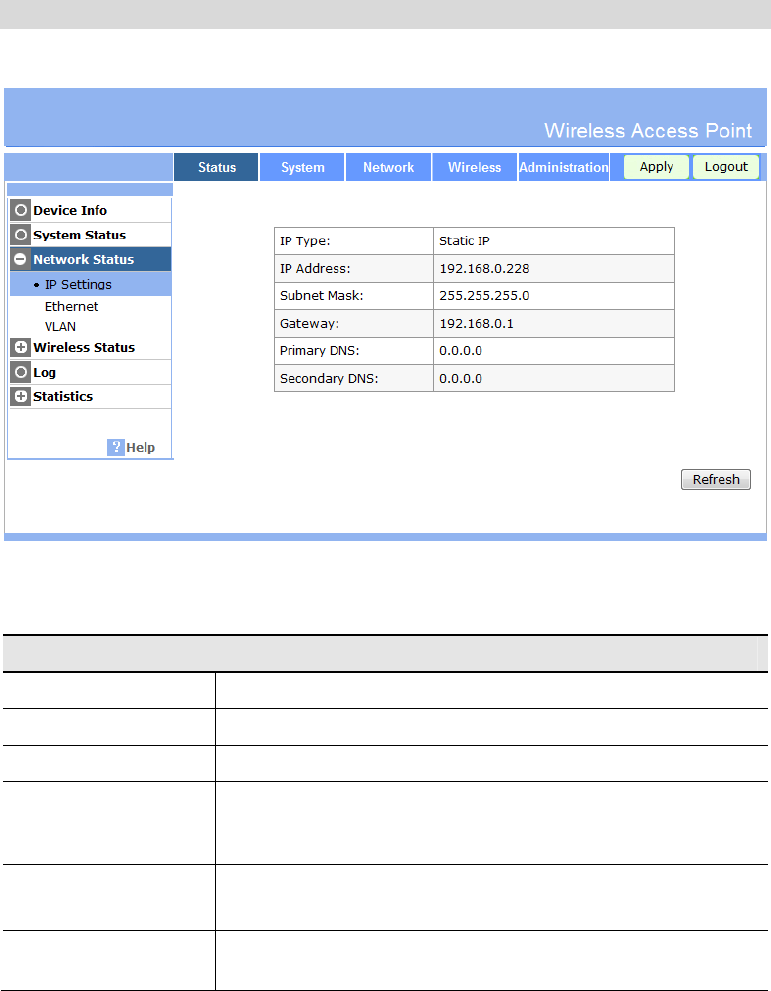
Operation and Status
75
Network Status
This screen is displayed when the Network Status button is clicked.
Figure 66: IP Settings Screen
Data - IP Settings Screen
TCP/IP
IP Type The current IP type is displayed.
IP Address The IP Address of the Wireless Access Point.
Subnet Mask The Network Mask (Subnet Mask) for the IP Address above.
Gateway Enter the Gateway for the LAN segment to which the Wireless
Access Point is attached (the same value as the PCs on that LAN
segment).
Primary DNS Enter the IP Address of the DNS (Domain Name Servers) here.
These DNS will be used only if the primary DNS is unavailable.
Secondary DNS The Secondary DNS will be used only if the primary DNS is
unavailable.
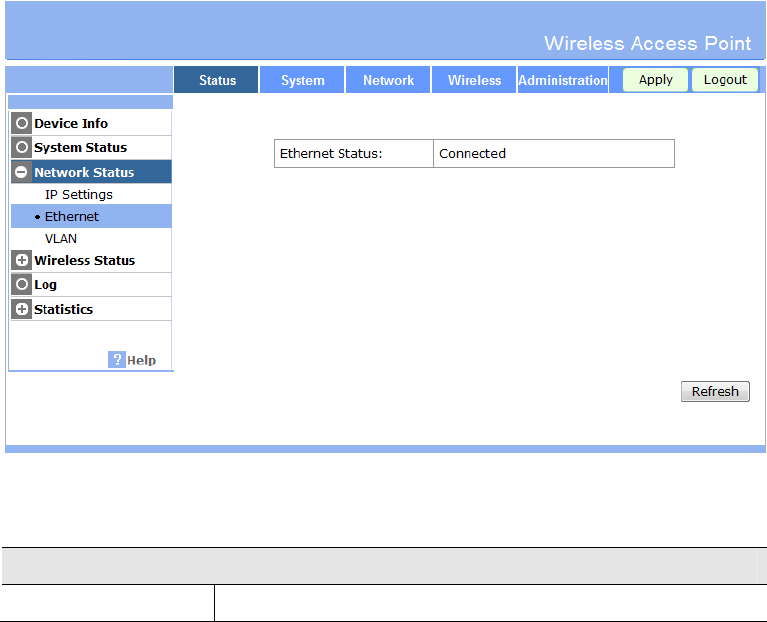
Wireless Access Point User Guide
76
Ethernet
This screen is displayed when the Ethernet button is clicked.
Figure 67 Ethernet Screen
Data - Ethernet Screen
Ethernet
Ethernet Status The current Ethernet status is displayed.
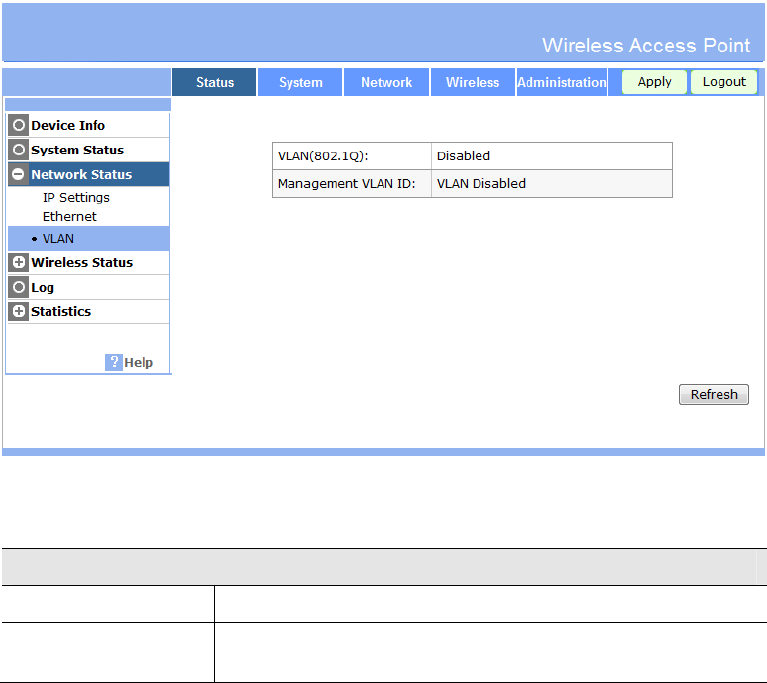
Operation and Status
77
VLAN
This screen is displayed when the VLAN button is clicked.
Figure 68: VLAN Screen
Data - VLAN Screen
VLAN
VLAN The current VLAN status is displayed.
Management VLAN
ID It displays the VLAN ID of Management VLAN.
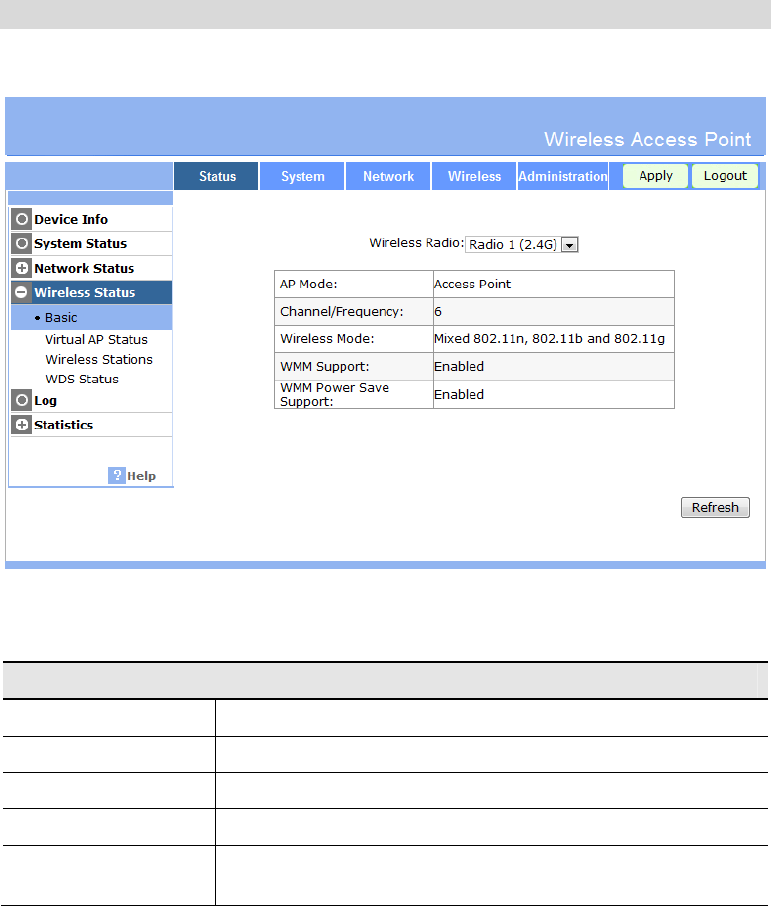
Wireless Access Point User Guide
78
Wireless Status
Basic Screen
Figure 69: Basic Screen
Data - Basic Screen
Basic
AP Mode The current Access Point mode is displayed.
Channel/Frequency The Channel currently in use is displayed.
Wireless Mode The current mode (e.g. 802.11g) is displayed.
WMM Support "Enabled" or "Disabled" is displayed for the WMM status.
WMM Power Save
Support "Enabled" or "Disabled" is displayed for the WMM Power Save
status.
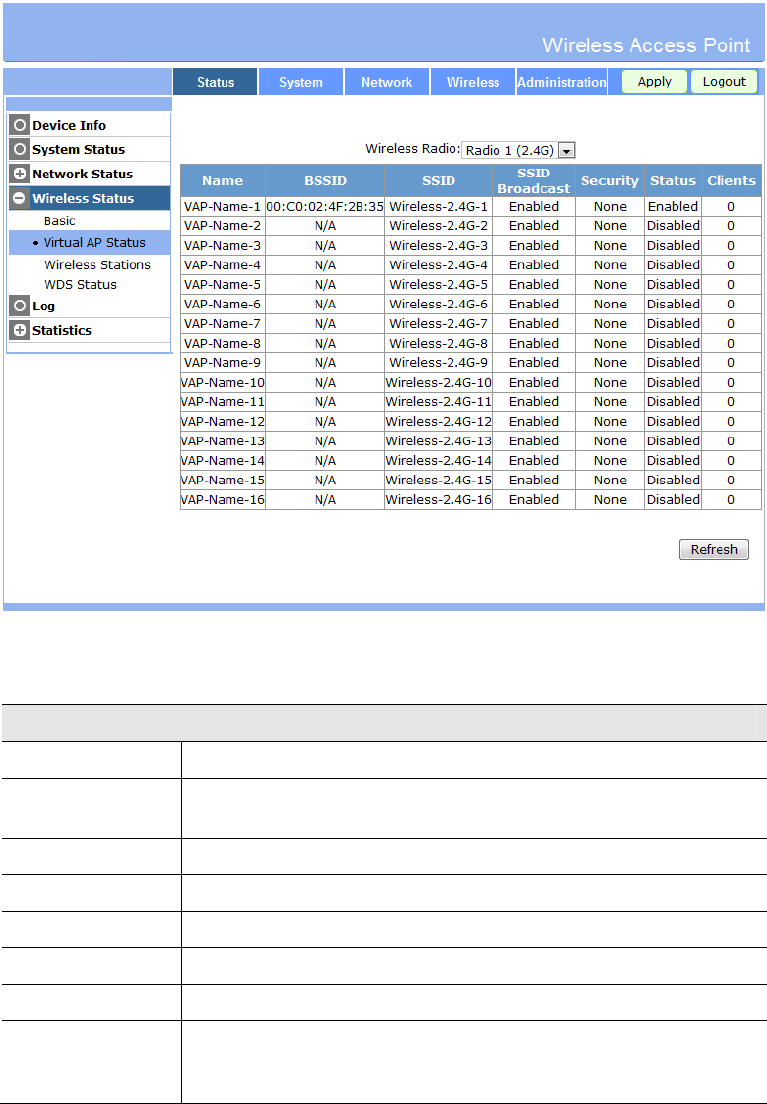
Operation and Status
79
Virtual AP Status Screen
Figure 70: Virtual AP Status Screen
Data - Virtual AP Status Screen
Virtual AP Status
Wireless Radio Select the desired band (2.4 GHz or 5 GHz) used by this profile.
Name The name you gave to this profile; if you didn't change the name, the
default name is used.
BSSID The BSSID assigned to this profile.
SSID The SSID assigned to this profile.
SSID Broadcast Indicates whether or not the SSID is broadcast.
Security The security method used by this profile.
Status Indicates whether or not this profile is enabled or currently used.
Clients The number of wireless stations currently using accessing this Access
Point using this profile.
If the profile is disabled, this will always be zero.
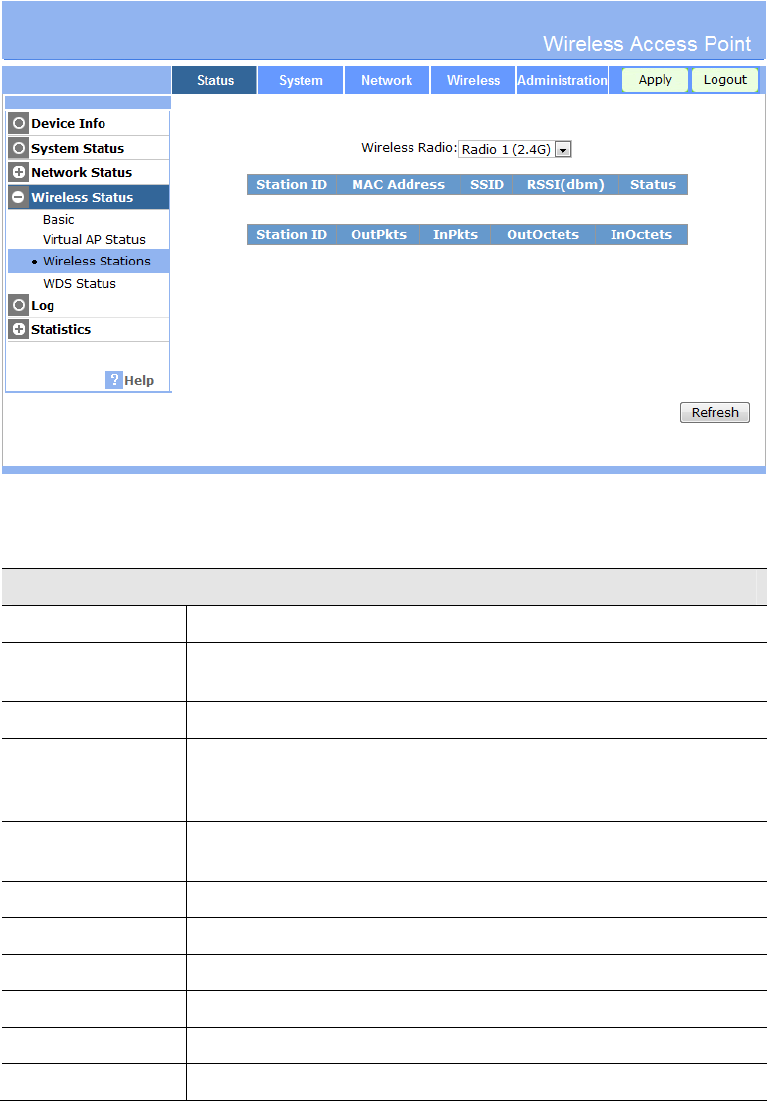
Wireless Access Point User Guide
80
Wireless Stations Screen
Figure 71: Wireless Stations Screen
Data - Wireless Station Screen
Station List
Wireless Radio Select the desired band (2.4 GHz or 5 GHz) used by this profile.
Station ID The ID of each Wireless Station is displayed. If the ID is not known,
"unknown" will be displayed.
MAC Address The MAC (physical) address of each Wireless Station is displayed.
SSID This displays the SSID used by the Wireless station. Because the
Wireless Access Point supports multiple SSIDs, different PCs could
connect using different SSIDs.
RSSI It displays the RSSI (received signal strength indicator) of received
radio signal
Status This indicates the current status of each Wireless Station.
OutPkts Number of valid Data packets transmitted to Wireless Stations
InPkts Number of valid Data packets received from Wireless Stations.
OutOctets Number of octests transmitted to Wireless Stations
InOctets This indicates the current status of each Wireless Station.
Refresh Button Update the data on screen.
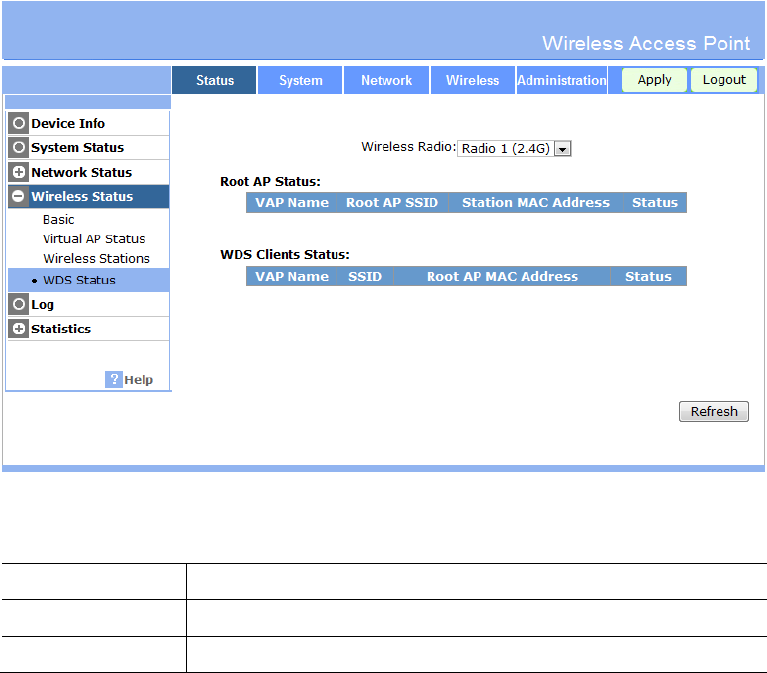
Operation and Status
81
WDS Status Screen
Figure 72: WDS Status Screen
Data - WDS Status Screen
Wireless Radio Select the desired band (2.4 GHz or 5 GHz) used by this profile.
Root AP Status The following table shows the current status of the root AP.
WDS Client Status The following table shows the current status of the WDS Client.
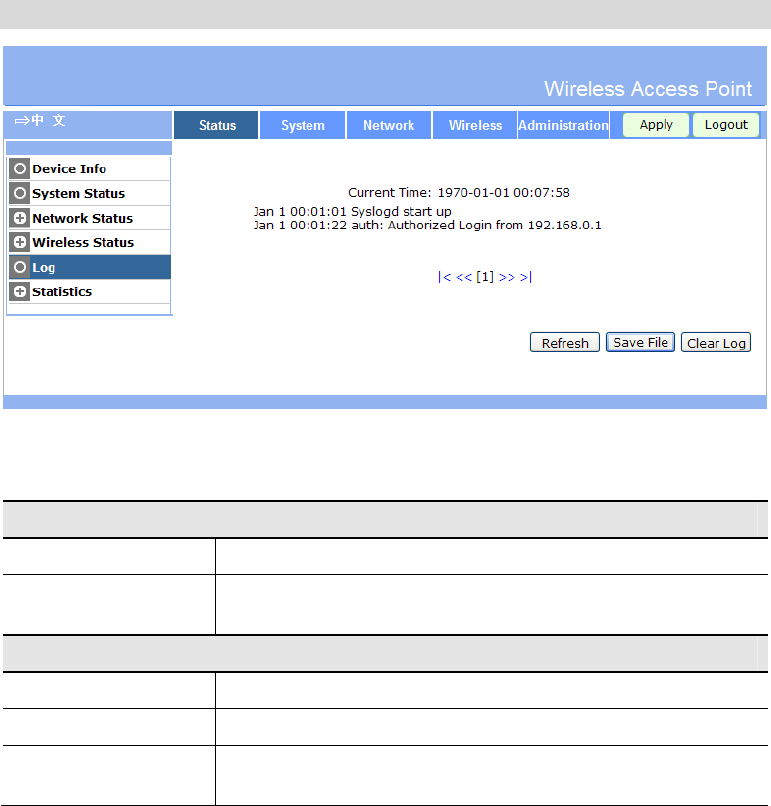
Wireless Access Point User Guide
82
Log Screen
Figure 73: Log Screen
Data - Log Screen
Data
Current Time The system date and time is displayed.
Log The Log shows details of the connections to the Wireless Access
Point.
Buttons
Refresh Update the data on screen.
Save File Save the log to a file on your pc.
Clear Log This will delete all data currently in the Log. This will make it
easier to read new messages.
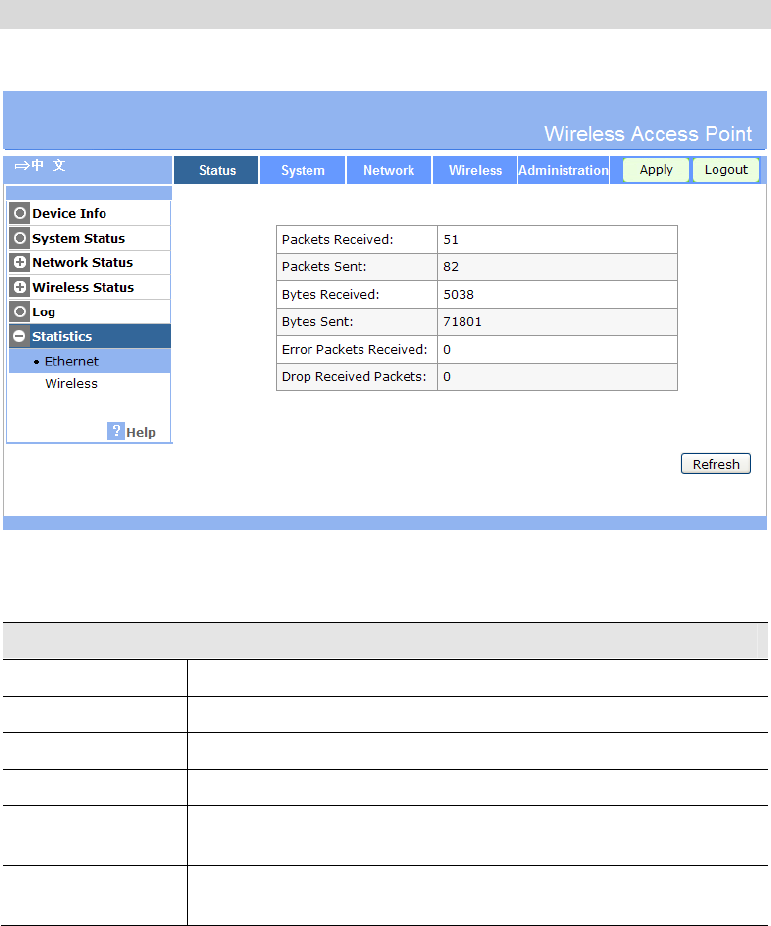
Operation and Status
83
Statistics Screen
Ethernet Screen
Figure 74: Ethernet Screen
Data - Ethernet Screen
Ethernet
Packets Received The number of packets received by the Access Point.
Packets Sent The number of packets sent by the Access Point.
Bytes Received The number of bytes received by the Access Point.
Bytes Sent The number of bytes sent by the Access Point.
Error Packets
Received The number of error packets received.
Drop Received
Packets The number of drop packets received.
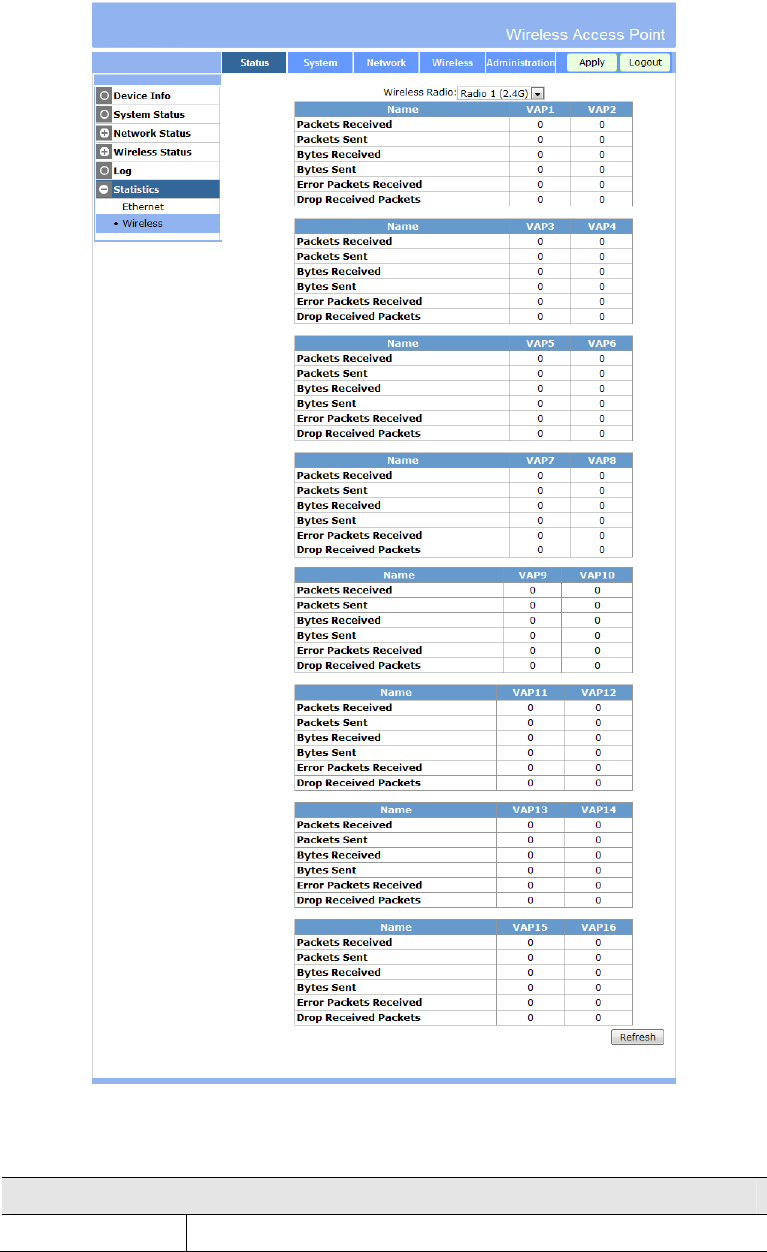
Wireless Access Point User Guide
84
Wireless Screen
Figure 75: Wireless Screen
Data - Wireless Screen
VAP1~VAP16
Wireless Radio Select the desired band (2.4 GHz or 5 GHz) used by this profile.

Operation and Status
85
Packets Received The number of packets received by the Access Point.
Packets Sent The number of packets sent by the Access Point.
Bytes Received The number of bytes received by the Access Point.
Bytes Sent The number of bytes sent by the Access Point.
Error Packets
Received The number of error packets received.
Drop Received
Packets The number of drop packets.
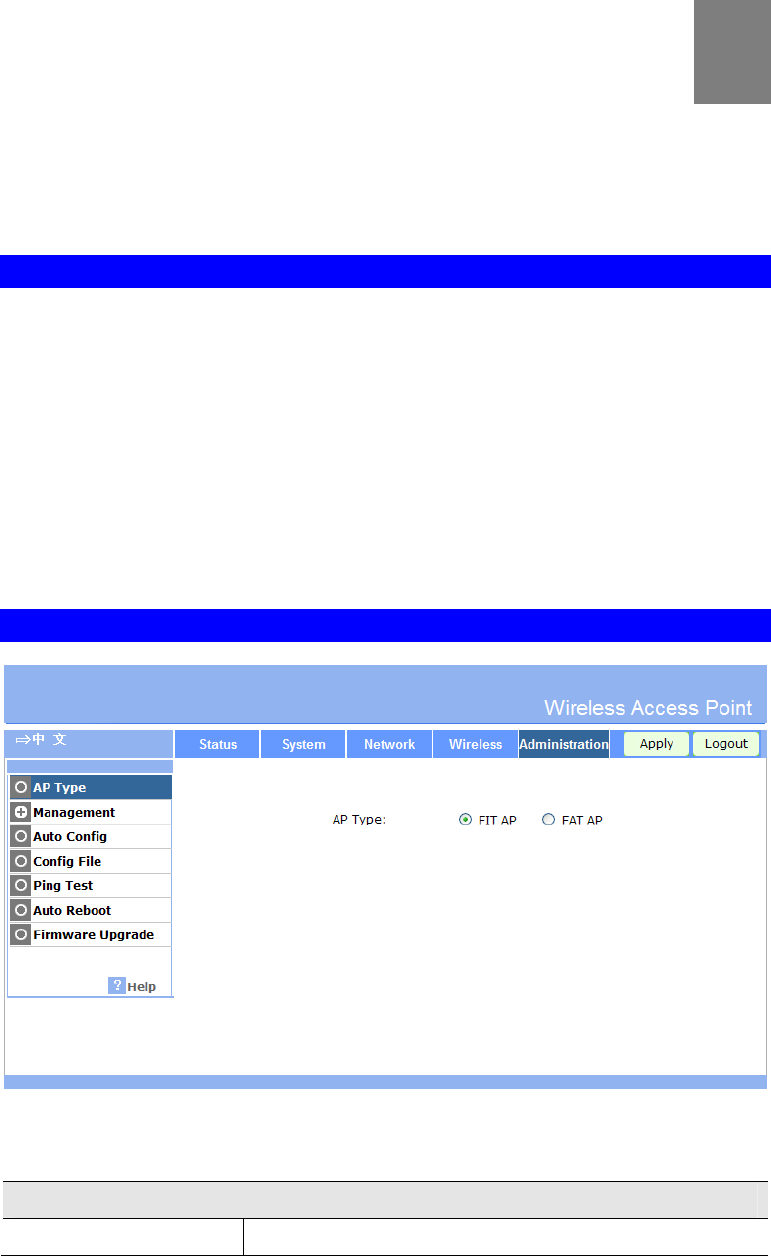
86
Chapter 6
Access Point Management
This Chapter explains when and how to use the Wireless Access Point's
"Administration" Features.
Overview
This Chapter covers the following features, available on the Wireless Access Point’s
Administration menu.
AP Type
Management
Auto Config
Config File
Ping Test
Auto Reboot
Firmware Upgrade
AP Type
Figure 76: AP Type Screen
Data - AP Type Screen
Account
AP Type Select the AP type as required.
6
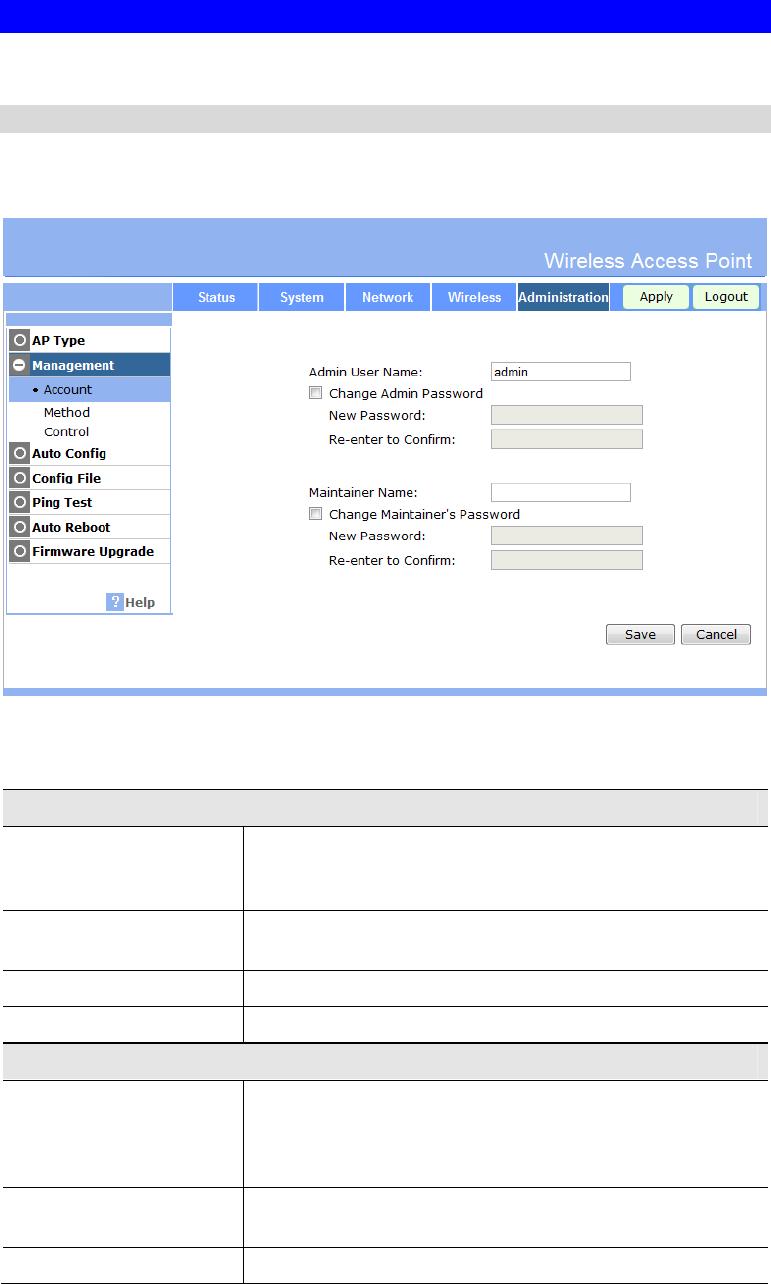
Access Point Management
87
Management Screen
Account Screen
The Account screen allows you to assign or modify the names and passwords for the
administrator and maintainer. It is recommended that this be changed, using this screen.
Figure 77: Account Screen
Data - Account Screen
Account
Admin User Name Enter the login name for the Administrator. The
administrator has the maintenance and operation for all the
functions.
Change Admin Password If you wish to change the Admin password, check this field
and enter the new login password in the fields below.
New Password Enter the desired login password.
Re-enter to Confirm Re-enter the desired login password.
Maintainer
Maintainer Name Enter the login name for the maintainer. This account can only
be allowed to use some functions (such as Firmware Upgrade,
Auto Reboot, Config file, AP Type, Device Mode and Wire-
less).
Change Maintainer’s
Password If you wish to change the password, check this field and enter
the new login password in the fields below.
New Password Enter the desired login password.
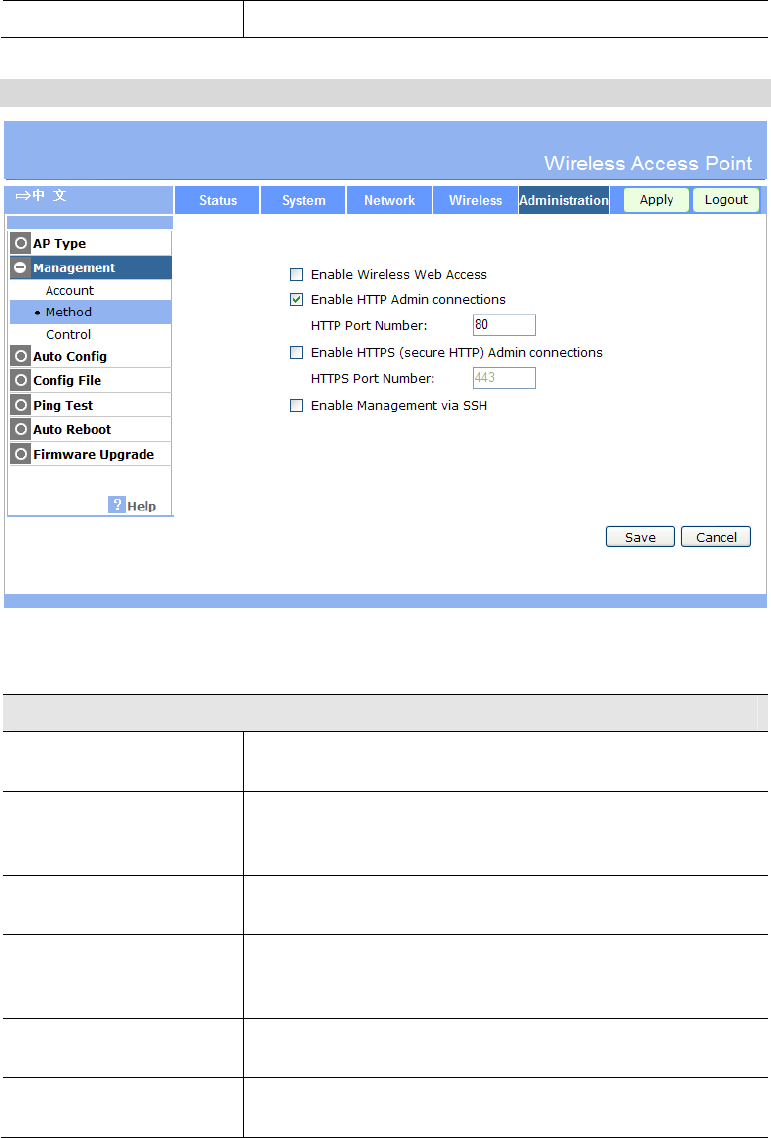
Wireless Access Point User Guide
88
Re-enter to Confirm Re-enter the desired login password.
Method Screen
Figure 78: Method Screen
Data - Method Screen
Method
Enable Wireless Web
Access Enable this to allow wireless client access the device.
Enable HTTP Enable this to allow admin connections via HTTP. If enabled,
you must provide a port number in the field below. Either
HTTP or HTTPS must be enabled.
HTTP Port Number Enter the port number to be used for HTTP connections to this
device. The default value is 80.
Enable HTTPS Enable this to allow admin connections via HTTPS (secure
HTTP). If enabled, you must provide a port number in the
field below. Either HTTP or HTTPS must be enabled.
HTTPS Port Number Enter the port number to be used for HTTPS connections to
this device. The default value is 443.
Enable Management via
SSH If desired, you can enable this option. If enabled, you will able
to connect to this AP using a SSH client.
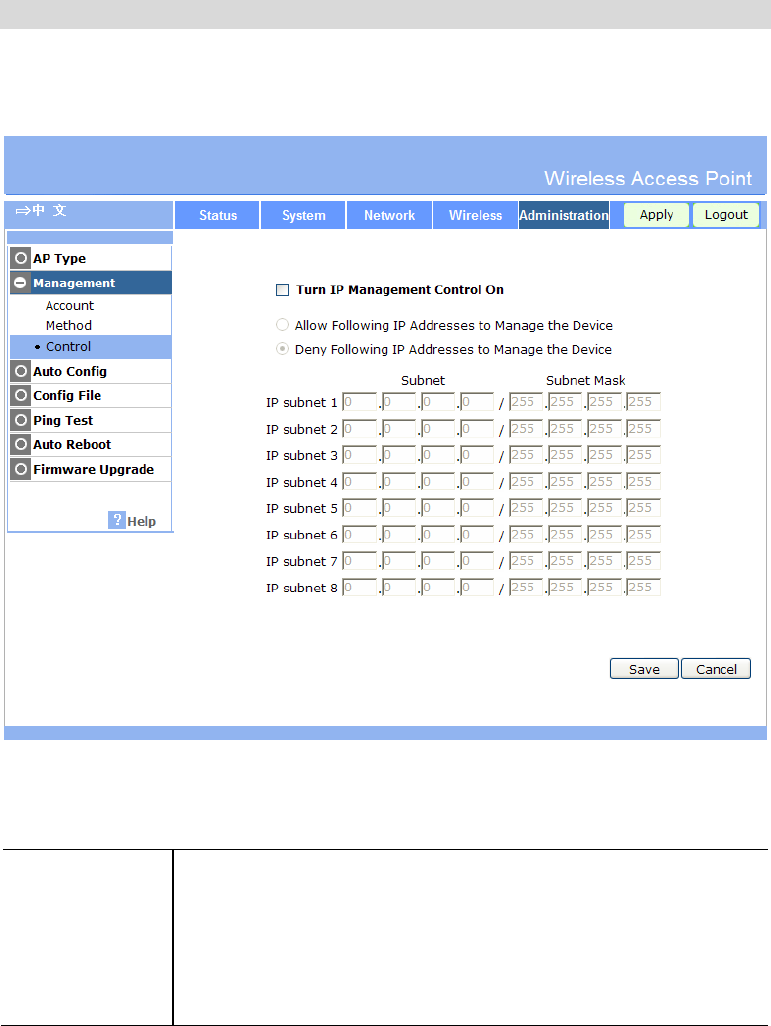
Access Point Management
89
Control Screen
This feature can be used to block access to your LAN by unknown or untrusted wireless
stations.
Figure 79: Control Screen
Data - Control Screen
Turn IP
Management
Control On
Select the desired option, as required
Enable or Disable the Management Control feature.
Select either Allow following IP addresses to Manage the Device
or Deny following IP addresses to Manage the Device.
Enter the physical IP address and Subnet Mask of each Wireless
station.
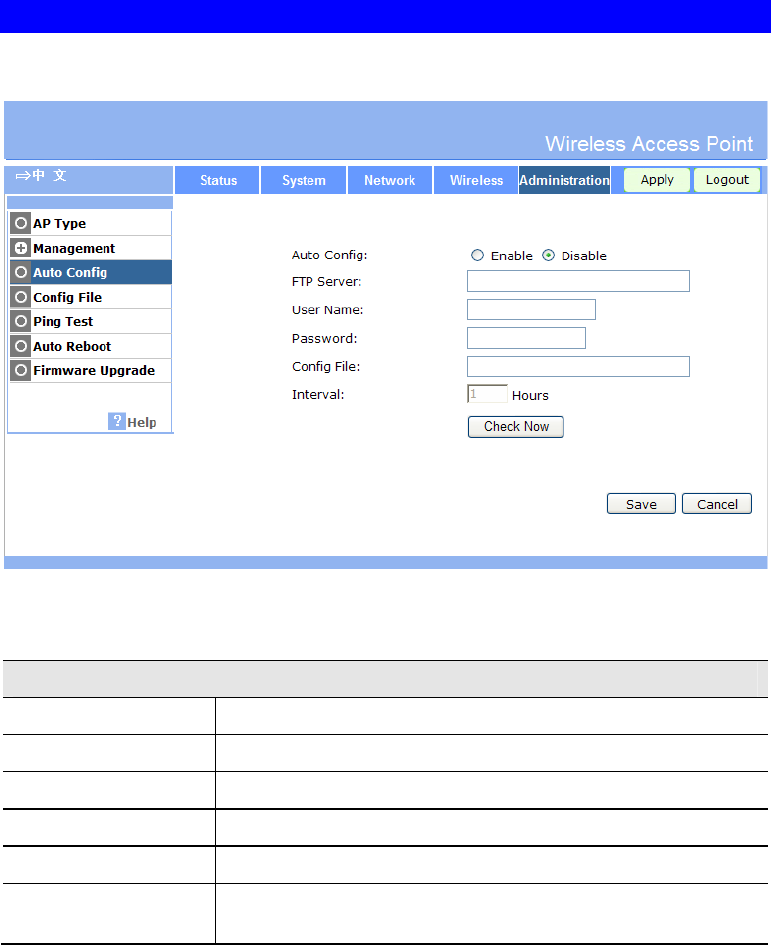
Wireless Access Point User Guide
90
Auto Config
To reach this screen, select Auto Config in the Administration section of the menu.
Figure 80: Auto Config Screen
Data - Auto Config Screen
Auto Config
Auto Config If enabled, this AP will perform Auto Configuration.
FTP Server Enter the address for the FTP server.
User Name Enter the login name for the FTP server.
Password Enter the login password for the FTP server.
Config File Enter the full path of the firmware in the FTP server.
Interval If enabled, the device will check the config file in the time
interval. Enter the desired time in the field.
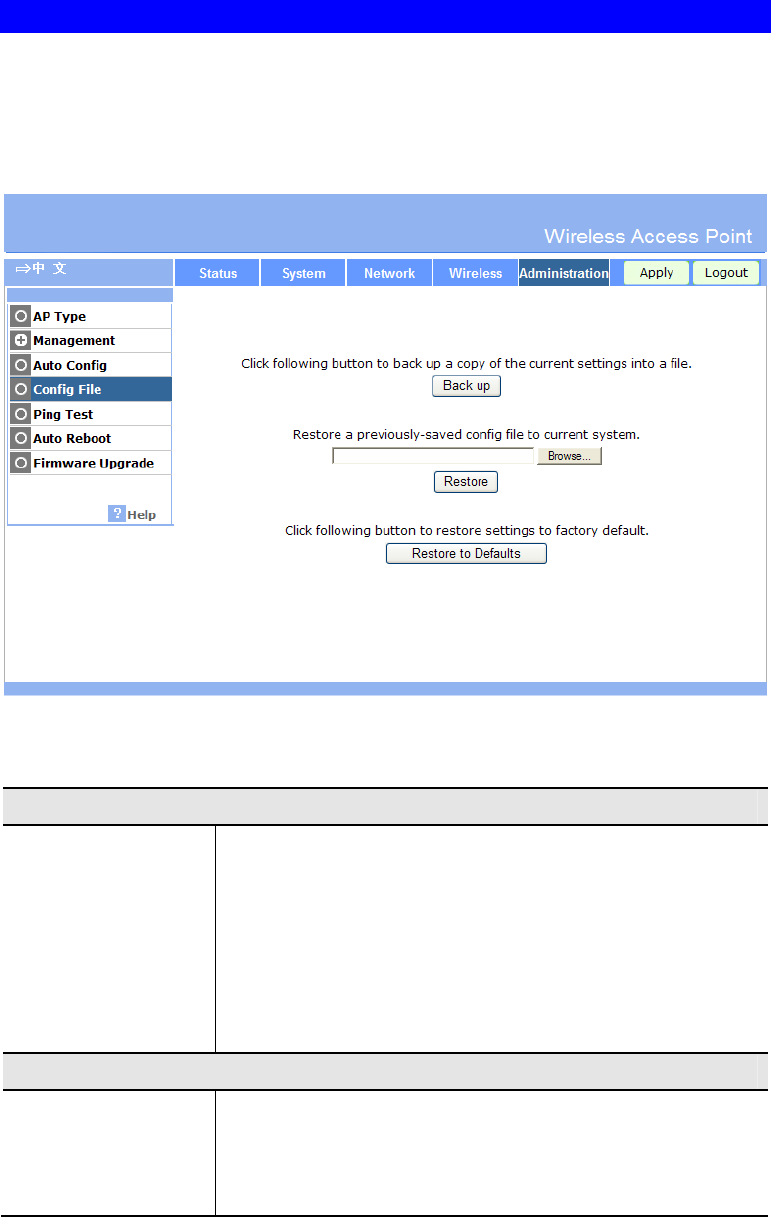
Access Point Management
91
Config File
This screen allows you to Backup (download) the configuration file, and to restore (upload) a
previously-saved configuration file.
You can also set the Wireless Access Point back to its factory default settings.
To reach this screen, select Config File in the Management section of the menu.
Figure 81: Config File Screen
Data - Config File Screen
Backup
Back up a copy of the
current settings to a
file
Once you have the Access Point working properly, you should
back up the settings to a file on your computer. You can later
restore the Access Point's settings from this file, if necessary.
To create a backup file of the current settings:
Click Back up.
If you don't have your browser set up to save downloaded
files automatically, locate where you want to save the file,
rename it if you like, and click Save.
Restore
Restore saved settings
from a file To restore settings from a backup file:
1. Click Browse.
2. Locate and select the previously saved backup file.
3. Click Restore.

Wireless Access Point User Guide
92
Defaults
Revert to factory
default settings To erase the current settings and restore the original factory
default settings, click Restore to Defaults button.
Note!
This will terminate the current connection. The Access Point
will be unavailable until it has restarted.
By default, the Access Point will act as a DHCP client, and
automatically obtain an IP address. You will need to deter-
mine its new IP address in order to re-connect.
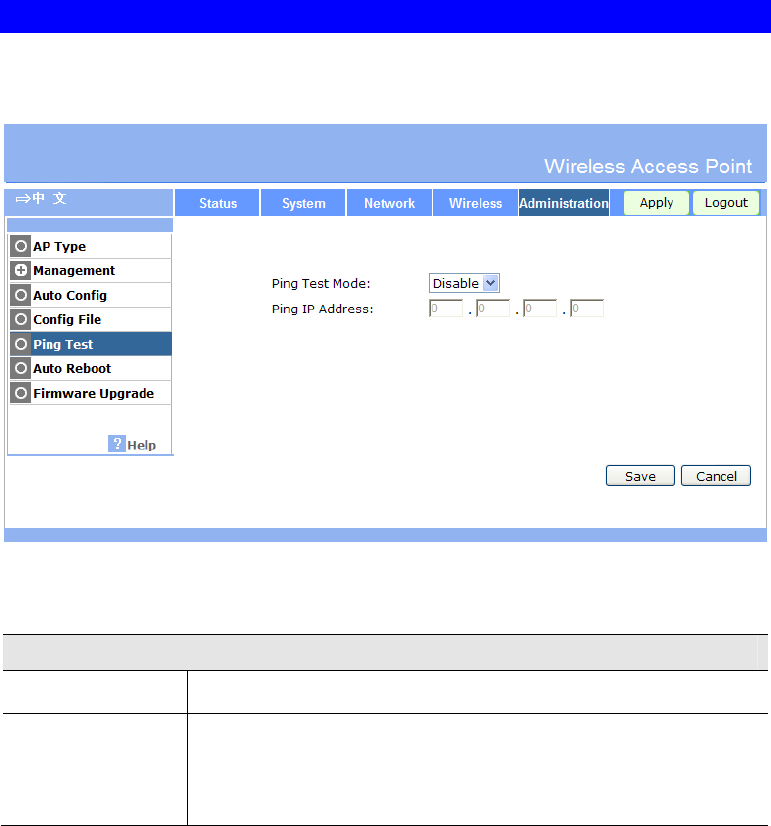
Access Point Management
93
Ping Test
This screen allows you to perform a "Ping". These activities can be useful in solving network
problems.
Figure 82: Ping Test Screen
Data - Ping Test Screen
Ping
Ping Test Mode Select the desired option from the drop-down list.
Ping IP Address Enter the IP address you wish to ping. The IP address can be on your
LAN, or on the Internet. Note that if the address is on the Internet,
and no connection currently exists, you could get a "Timeout" error.
In that case, wait a few seconds and try again.
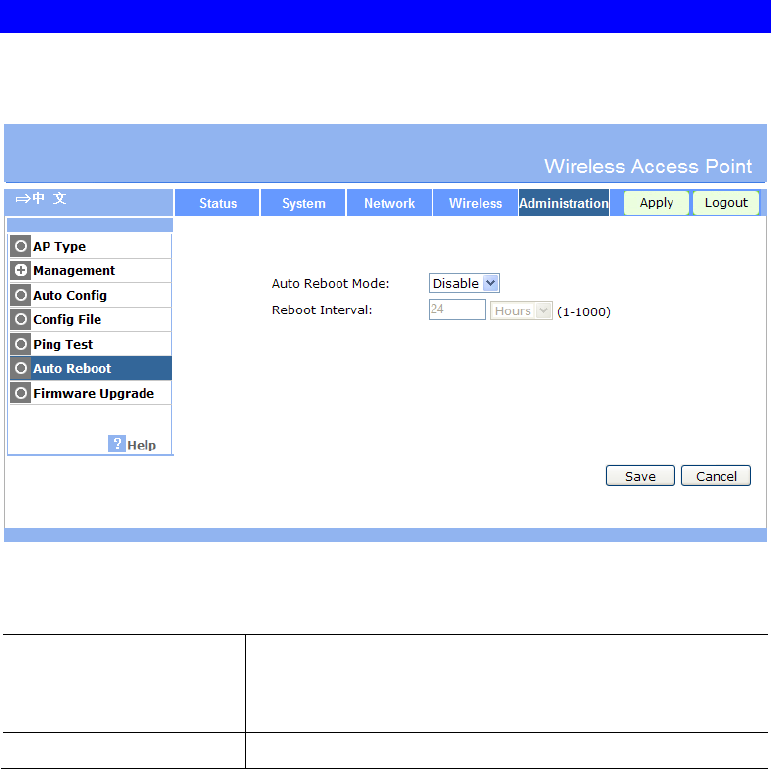
Wireless Access Point User Guide
94
Auto Reboot
If you have a Syslog Server on your LAN, this screen allows you to configure the Access Point
to send log data to your Syslog Server.
Figure 83: Auto Reboot Screen
Data - Auto Reboot Screen
Auto Reboot Mode Select the desired Option:
Disable - Auto Reboot feature is not used.
Enable - Auto Reboot feature is in use.
Reboot Interval Enter the desired time for reboot interval.
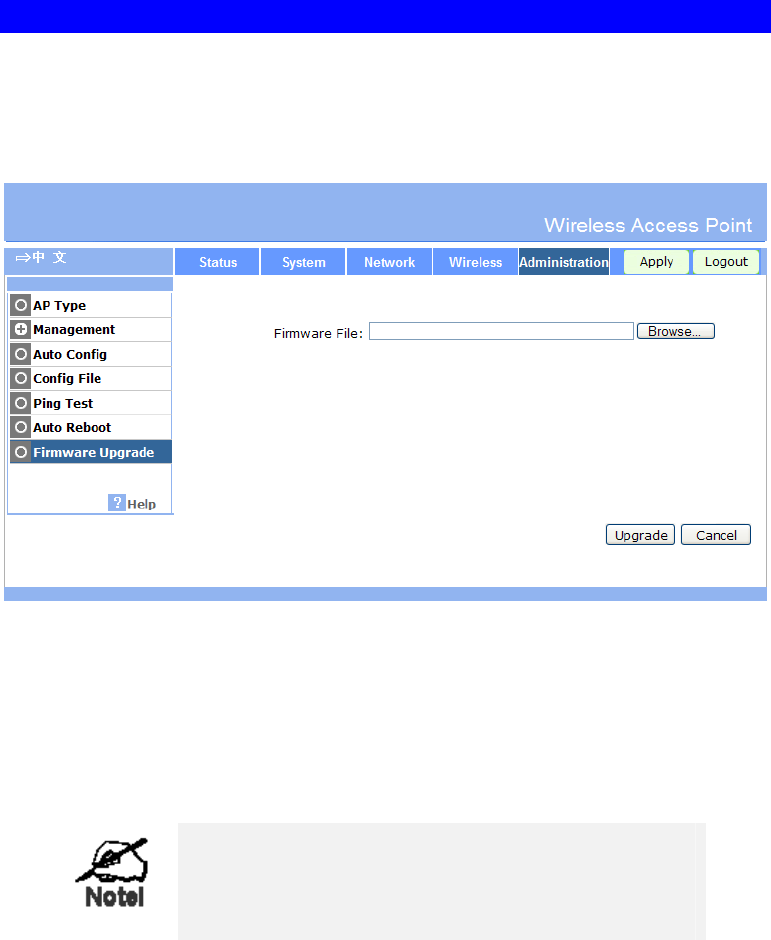
Access Point Management
95
Firmware Upgrade
The firmware (software) in the Wireless Access Point can be upgraded using your Web
Browser.
You must first download the upgrade file, and then select Upgrade Firmware in the
Management section of the menu. You will see a screen like the following.
Figure 84: Firmware Upgrade Screen
To perform the Firmware Upgrade:
1. Click the Browse button and navigate to the location of the upgrade file.
2. Select the upgrade file. Its name will appear in the Firmware File field.
3. Click the Upgrade button to commence the firmware upgrade.
The Wireless Access Point is unavailable during the
upgrade process, and must restart when the up-
grade is completed. Any connections to or through
the Wireless Access Point will be lost.

96
Chapter 7
Access Point Mode
This Chapter explains configuration and operation when in "Access Point".
Overview
There are two modes available on the Device Mode screen.
Router - In this mode, this device can provide shared Internet Access to all your LAN
users. Also, by default, it acts a DHCP Server, providing an IP address and related infor-
mation to all Wireless and LAN users.
Bridge - The device links your Wireless Stations to your wired LAN. The Wireless
stations and devices on the wired LAN are then on the same network, and can communi-
cate with each other without regard for whether they are connected to the network via a
Wireless or wired connection.
This Chapter describes operation while in Access Point Mode.
Management Connections
You need to have a DHCP Server on your LAN to provide IP addresses to the Wireless
clients using this Access Point.
This AP must be a valid device on your LAN, to allow management connections. You
must assign a (fixed) IP address which is within the address range used on your LAN, but
not within the address range used by your DHCP server.
When you connect in future, just connect normally, using the IP address you assigned.
1. Start your WEB browser.
2. In the Address box, enter "HTTP://" and the current IP Address of the Wireless ADSL
Modem, as in this example, which uses the Wireless ADSL Modem's default IP Address:
HTTP://192.168.0.228
3. When prompted for the User name and Password, enter admin for the user name, and the
current password, as set on the password screen. (The password is the same regardless of
the mode.)
7
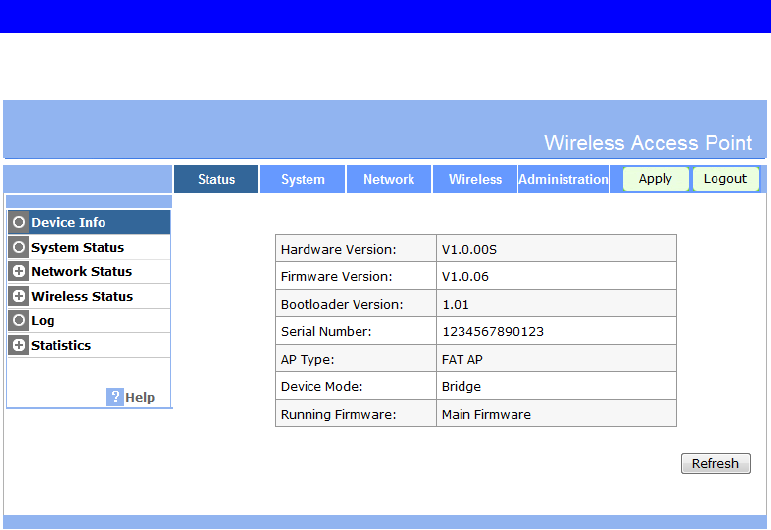
Access Point Mode
97
Home Screen
If in Access Point mode, the home screen will look like the example below.
Figure 85: Home Screen - Bridge Mode
Note that the menu has changed, many of the options in Router mode are the same as Bridge
mode. The screens available are:
Device Mode - change back to Router mode, if desired.
System - this screen and related sub-screens are the same as in Router mode.
Wireless - this screen and related sub-screens are the same as in Router mode.
Administration - this screen and related sub-screens are the same as in Router mode.
Status - displays current settings and status. See the following section for details.
The following section only describes the screens that are different than those in Router mode.
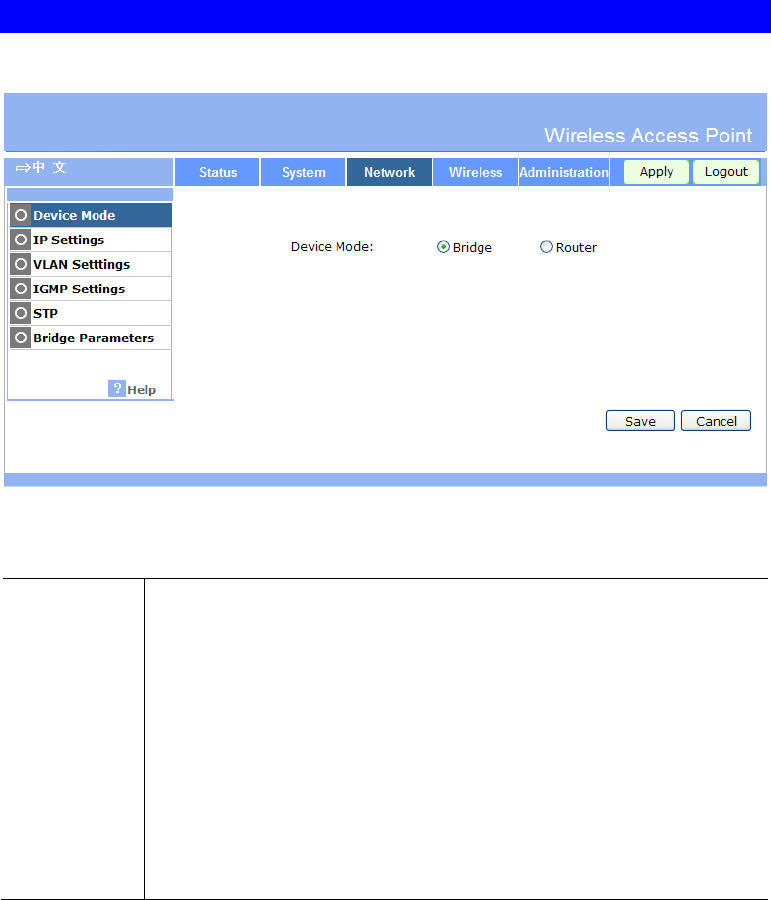
Wireless Access Point User Guide
98
Device Mode Screen
This screen is used to change back to Router mode, if desired.
Figure 86: Device Mode Screen
Data - Device Mode Screen
Device Mode Select the desired device mode for the router:
Router - In this mode, this device can provide shared Internet Access
to all your LAN users. Also, by default, it acts a DHCP Server,
providing an IP address and related information to all Wireless and
LAN users.
Bridge - The device links your Wireless Stations to your wired LAN.
The Wireless stations and devices on the wired LAN are then on the
same network, and can communicate with each other without regard
for whether they are connected to the network via a Wireless or wired
connection.
After changing the mode, this device will restart, which will take a few
seconds. The menu will also change, depending on the mode you are in.
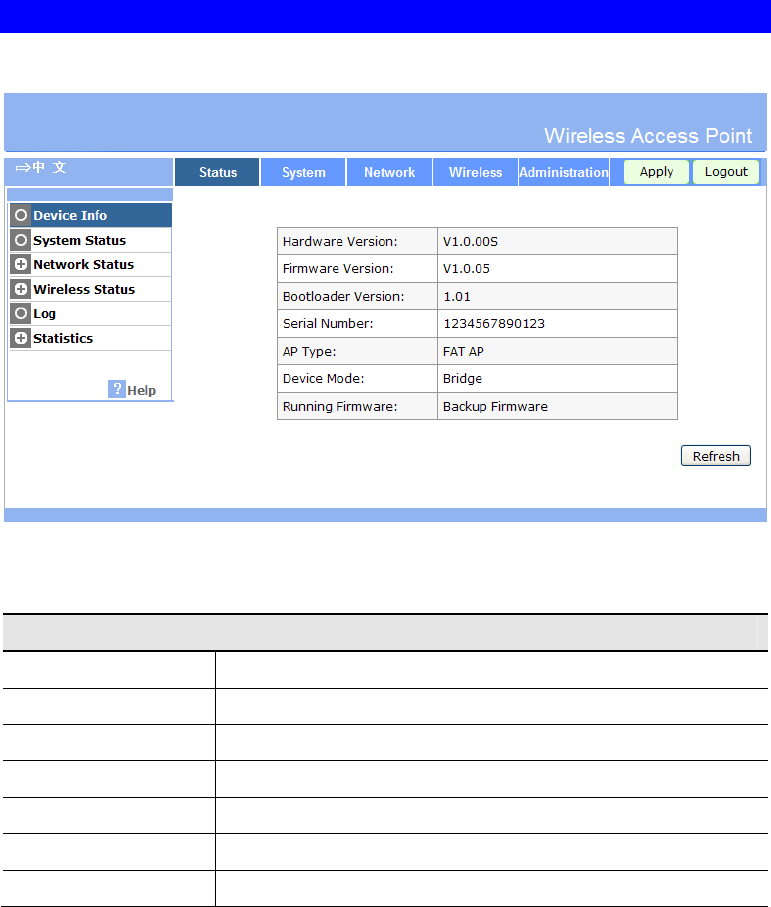
Access Point Mode
99
Status Screen
In Access Point mode, the Status screen looks like the example below.
Figure 87: Device Info Screen - Bridge Mode
Data - Device Info Screen (Bridge Mode)
Device Info
Hardware Version The version of the hardware currently used.
Firmware Version The version of the firmware currently installed.
Bootloader Version The version of the bootloader currently used.
Serial Number The serial number of the device.
AP Type The current AP type is displayed.
Device Mode The current device mode is displayed.
Running Firmware The currently running firmware is displayed.
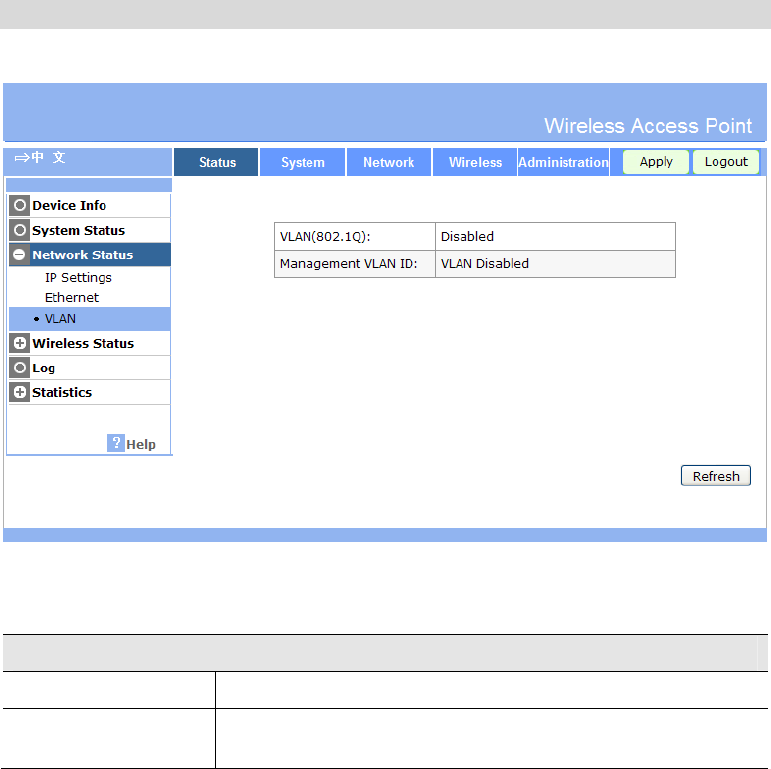
Wireless Access Point User Guide
100
VLAN Screen
In Access Point mode, the VLAN screen looks like the example below.
Figure 88: VLAN Screen
Data - VLAN Screen
VLAN
VLAN(802.1Q) It displays the status (Enabled or disabled) of VLAN.
Management VLAN
ID It displays the VLAN ID of Management VLAN.

101
Appendix A
Specifications
Wireless Access Point
Hardware Specifications
LAN port 1 x RJ45 auto-sensing 10/100/1000BASE-TX Ethernet
with 802.3af+ PoE. Can support Full Duplex and Half
Duplex transfer function.
Antennae 4 external omni antennas
Operating Temperature -10 C to 50 C
Operating Humidity 10% - 90% non-condensing
Power Adapter 12V/1A External
Console Port 1 x RJ45-base Console
Wireless Interface
Standards IEEE 802.11a/b/g/n
2.4GHz/5GHz
Radio Chains 2x2
Spatial Streams 2
Channelization 20MHz and/or 40MHz
Frequency Band 2.4 – 2.484 GHz and 5.15 – 5.85 GHz
Operating Channels US/Canada: 1-11
Europe/China/Japan: 1-13
5GHz channels: 36, 40, 44, 48, 52, 56, 60, 64, 100, 104,
108, 112, 116, 120, 124, 128, 132, 136, 140, 149, 153,
157, 161, 165
BSSID Up to 16 per Radios (32 total)
Power Save Supported
Wireless Security WEP, WPA-PSK, WPA-TKIP, WPA2 AES, 802.11i
RF Power 20dBm at max
Receive Sensitivity -91dBm @802.11b
-89dBm @802.11a/g
-83dBm @802.11n
Performance 160Mbps per band
A

Wireless Access Point User Guide
102
Connectivity Up to 128 clients per band (256 total)

Appendix A - Specifications
103
FCC Statement
This equipment has been tested and found to comply with the limits for a Class B digital device, pursuant
to part 15 of the FCC rules. These limits are designed to provide reasonable protection against harmful
interference in a residential installation. This equipment generates, uses and can radiate radio frequency
energy and, if not installed and used in accordance with the instructions, may cause harmful interference
to radio communications. However, there is no guarantee that interference will not occur in a particular
installation. If this equipment does cause harmful interference to radio or television reception, which can
be determined by turning the equipment off and on, the user is encouraged to try to correct the interfer-
ence by one or more of the following measures:
-Reorient or relocate the receiving antenna.
-Increase the separation between the equipment and receiver.
-Connect the equipment into an outlet on a circuit different from that to which the receiver is connected.
-Consult the dealer or an experienced radio/TV technician for help.
You are cautioned that changes or modifications not expressly approved by the party responsible for
compliance could void your authority to operate the equipment.
This device complies with Part 15 of the FCC Rules. Operation is subject to the following two conditions:
This device may not cause harmful interference.
This device must accept any interference received, including interference that may cause undesired
operation.

Wireless Access Point User Guide
104
FCC RF Radiation Exposure Statement
1. This Transmitter must not be co-located or operating in conjunction with any other antenna or
transmitter.
2. This equipment complies with FCC RF radiation exposure limits set forth for an uncontrolled
environment. This equipment should be installed and operated with a minimum distance of 20 cen-
timeters between the radiator and your body.

105
Appendix B
Troubleshooting
Overview
This chapter covers some common problems that may be encountered while using the Wireless
Access Point and some possible solutions to them. If you follow the suggested steps and the
Wireless Access Point still does not function properly, contact your dealer for further advice.
General Problems
Problem 1: Can't connect to the Wireless Access Point to configure it.
Solution 1: Check the following:
The Wireless Access Point is properly installed, LAN connections are
OK, and it is powered ON. Check the LEDs for port status.
Ensure that your PC and the Wireless Access Point are on the same
network segment. (If you don't have a router, this must be the case.)
If your PC is set to "Obtain an IP Address automatically" (DHCP
client), restart it.
You can use the following method to determine the IP address of the
Wireless Access Point, and then try to connect using the IP address, in-
stead of the name.
To Find the Access Point's IP Address
1. Open a MS-DOS Prompt or Command Prompt Window.
2. Use the Ping command to “ping” the Wireless Access Point. Enter
ping followed by the Default Name of the Wireless Access Point.
e.g. ping SC003318
3. Check the output of the ping command to determine the IP address of
the Wireless Access Point, as shown below.
Figure 89: Ping
If your PC uses a Fixed (Static) IP address, ensure that it is using an IP
Address which is compatible with the Wireless Access Point. (If no DHCP
Server is found, the Wireless Access Point will default to an IP Address and
Mask of 192.168.0.228 and 255.255.255.0.) On Windows PCs, you can use
Control Panel-Network to check the Properties for the TCP/IP protocol.
B
Wireless Access Point User Guide
106
Problem 2: My PC can't connect to the LAN via the Wireless Access Point.
Solution 2 Check the following:
The SSID and WEP settings on the PC match the settings on the Wire-
less Access Point.
On the PC, the wireless mode is set to "Infrastructure"
If using the Access Control feature, the PC's name and address is in the
Trusted Stations list.
If using 802.1x mode, ensure the PC's 802.1x software is configured
correctly. See Chapter 4 for details of setup for the Windows XP 802.1x
client. If using a different client, refer to the vendor's documentation.

107
Appendix C
About Wireless LANs
Overview
Wireless networks have their own terms and jargon. It is necessary to understand many of
these terms in order to configure and operate a Wireless LAN.
Wireless LAN Terminology
Modes
Wireless LANs can work in either of two (2) modes:
Ad-hoc
Infrastructure
Ad-hoc Mode
Ad-hoc mode does not require an Access Point or a wired (Ethernet) LAN. Wireless Sta-
tions (e.g. notebook PCs with wireless cards) communicate directly with each other.
Infrastructure Mode
In Infrastructure Mode, one or more Access Points are used to connect Wireless Stations
(e.g. Notebook PCs with wireless cards) to a wired (Ethernet) LAN. The Wireless Stations
can then access all LAN resources.
Access Points can only function in "Infrastructure" mode,
and can communicate only with Wireless Stations which are
set to "Infrastructure" mode.
SSID/ESSID
BSS/SSID
A group of Wireless Stations and a single Access Point, all using the same ID (SSID),
form a Basic Service Set (BSS).
Using the same SSID is essential. Devices with different SSIDs are unable to communi-
cate with each other. However, some Access Points allow connections from Wireless
Stations which have their SSID set to “any” or whose SSID is blank (null).
ESS/ESSID
A group of Wireless Stations, and multiple Access Points, all using the same ID (ESSID),
form an Extended Service Set (ESS).
C

Wireless Access Point User Guide
108
Different Access Points within an ESS can use different Channels. To reduce interference,
it is recommended that adjacent Access Points SHOULD use different channels.
As Wireless Stations are physically moved through the area covered by an ESS, they will
automatically change to the Access Point which has the least interference or best perfor-
mance. This capability is called Roaming. (Access Points do not have or require Roaming
capabilities.)
Channels
The Wireless Channel sets the radio frequency used for communication.
Access Points use a fixed Channel. You can select the Channel used. This allows you to
choose a Channel which provides the least interference and best performance. For 802.11g,
13 channels are available in the USA and Canada, but 11channels are available in North
America if using 802.11b.
If using multiple Access Points, it is better if adjacent Access Points use different Chan-
nels to reduce interference. The recommended Channel spacing between adjacent Access
Points is 5 Channels (e.g. use Channels 1 and 6, or 6 and 11).
In "Infrastructure" mode, Wireless Stations normally scan all Channels, looking for an
Access Point. If more than one Access Point can be used, the one with the strongest signal
is used. (This can only happen within an ESS.)
If using "Ad-hoc" mode (no Access Point), all Wireless stations should be set to use the
same Channel. However, most Wireless stations will still scan all Channels to see if there
is an existing "Ad-hoc" group they can join.
WEP
WEP (Wired Equivalent Privacy) is a standard for encrypting data before it is transmitted. This
is desirable because it is impossible to prevent snoopers from receiving any data which is
transmitted by your Wireless Stations. But if the data is encrypted, then it is meaningless
unless the receiver can decrypt it.
If WEP is used, the Wireless Stations and the Wireless Access Point must have the same
settings.
WPA-PSK
Like WEP, data is encrypted before transmission. WPA is more secure than WEP, and should
be used if possible. The PSK (Pre-shared Key) must be entered on each Wireless station. The
256Bit encryption key is derived from the PSK, and changes frequently.
WPA2-PSK
This is a further development of WPA-PSK, and offers even greater security, using the AES
(Advanced Encryption Standard) method of encryption.
WPA-Enterprise
This version of WPA requires a Radius Server on your LAN to provide the client authentica-
tion according to the 802.1x standard. Data transmissions are encrypted using the WPA
standard.

Appendix C - About Wireless LANs
109
If this option is used:
The Access Point must have a "client login" on the Radius Server.
Each user must have a "user login" on the Radius Server.
Each user's wireless client must support 802.1x and provide the login data when required.
All data transmission is encrypted using the WPA standard. Keys are automatically generated,
so no key input is required.
802.1x
This uses the 802.1x standard for client authentication, and WEP for data encryption. If possi-
ble, you should use WPA-Enterprise instead, because WPA encryption is much stronger than
WEP encryption.
If this option is used:
The Access Point must have a "client login" on the Radius Server.
Each user must have a "user login" on the Radius Server.
Each user's wireless client must support 802.1x and provide the login data when required.
All data transmission is encrypted using the WEP standard. You only have to select the
WEP key size; the WEP key is automatically generated.

110
Appendix D
Command Line Interface
Overview
If desired, the Command Line Interface (CLI) can be used for configuration. This creates the
possibility of creating scripts to perform common configuration changes. The CLI requires a
Telnet connection to the Wireless Access Point.
Using the CLI - Telnet
1. Start your Telnet client, and establish a connection to the Access Point.
e.g.
Telnet 192.168.0.228
2. You will be prompted for the user name and password. Enter the same login name and
password as used for the HTTP (Web) interface.
The default values are admin for the User Name, and password for the Password.
3. Once connected, you can use any of the commands listed in the following Command
Reference.
Command Reference
The following commands are available.
config vap Config Virtual AP X
? Display CLI Command List
help Display CLI Command List
get 11nampdu Set 11n A-MPDU Aggregation Mode
get 11namsdu Set 11n A-MSDU Aggregation Mode
get 11nguardinterval Set 11n Guard Interval Mode
get 11nsubchannel Set 11n Extension Sub-Channel
get 11nradioband Set 11n Radio Band
get 802.11d Display 802.11d Mode
get acctserver Display Accounting Server
get acctport Display Accounting Port
get acctsecret Display Accounting Secret
get acl Display Access Control Status
get active Display VAP Active (up) Mode
get aging Display Idle Timeout Interval
get authentication Display Authentication Type of WEP
D

Appendix D - Command Line Interface
111
get beaconinterval Display Beacon Interval
get channel Display Radio Channel
get country Display Country/Domain
get defaultkey Display Default Key Index
get description Display Access Point Description
get dhcp Display DHCP Mode
get dhcpserverendip Display DHCP Server End IP Address
get dhcpserverstartip Display DHCP Server start IP Address
get dnsserver Display IP Address of DNS Server
get
dot1xdynkeyupdate Display 802.1x Dynamic Key Update Mode
get dot1xdynkeylife Display 802.1x Dynamic Key Life Time (in Minutes)
get dot1xkeytype Display 802.1x Distribute Key Method
get fragthreshold Display Fragment Threshold
get gateway Display Gateway IP Address
get gtkupdate Display Group Key Update Mode
get gtkupdateinterval Display Group Key Update Interval (in Seconds)
get http Display HTTP Mode
get httpport Display HTTP Port Number
get https Display HTTPS Mode
get httpsport Display HTTPS Port Number
get ipaddr Display IP Address
get ipmask Display IP Subnet Mask
get isolation Display Isolate All Virtual APs State
get key Display WEP Key Value
get keylength Display WEP Key Length
get lltd Display LLTD Mode
get md5supplicant Display 802.1x MD5 Supplicant Mode
get md5suppname Display 802.1x Supplicant MD5 Name
get md5supppassword Display 802.1x Supplicant MD5 Password
get md5supptype Display 802.1x MD5 Supplicant Type
get nativevlanid Display Native VLAN ID
get ntp Display NTP Server IP Address
get operationmode Display Operation Mode
get password Display Login Password

Wireless Access Point User Guide
112
get psk Display Pre-shared Key
get radiusserver Display RADIUS Server IP Address
get radiusport Display RADIUS Port Number
get radiussecret Display RADIUS Shared Secret
get remoteptmp Display PTMP's Remote MAC Address List
get remoteptp Display PTP's Remote MAC Address
get roguedetect Display Rogue AP Detection Mode
get rogueinteval Display Interval of Every Rogue AP Detection
get roguelegal Display Legal AP List of Legal AP
get roguetrap Display Rogue AP Detection Send SNMP Trap Mode
get roguetype Display Rogue AP Definition
get rtsthreshold Display RTS/CTS Threshold
get security Display Wireless Security Mode
get shortpreamble Display Short Preamble Usage
get snmpreadcommu-
nity Display SNMP Read Community
get snmpwritecommu-
nity Display SNMP Write Community
get snmpmode Display SNMP Mode
get snmpmanagemode Display SNMP Manager Mode
get snmptrapmode Display SNMP Trap Mode
get snmptrapversion Display SNMP Trap Version
get snmpv3username Display SNMP v3 User Name
get snmpv3authproto Display SNMP v3 Authentication Protocol
get snmpv3authkey Display SNMP v3 Authentication Key
get snmpv3privproto Display SNMP v3 Private Protocol
get snmpv3privkey Display SNMP v3 Private Key
get ssid Display Service Set ID
get ssidbroadcast Display SSID Broadcast Mode
get stp Display STP Mode
get strictgtkupdate Display Group Key Update Strict Status
get syslog Display Syslog Mode
get syslogport Display Syslog Port
get syslogserver Display Unicast Syslog Server Address
get syslogseverity Display Syslog Severity Level

Appendix D - Command Line Interface
113
get systemname Display Access Point System Name
get telnet Display Telnet Mode
get time Display Current System Time
get timezone Display Time Zone Setting
get uptime Display Access Point Up Time
get username Display Login User Name
get vapname Display Virtual AP Name
get version Display Firmware Version
get vlan Display VLAN Operational State
get vlanid Display the VLAN ID
get wirelessmode Display Wireless LAN Mode
get wirelessseparate Display Wireless Separate Mode
get wmm Display WMM Mode
get wmmnoack Display WMM No Acknowledgement status
set 11nampdu Set 11n A-MPDU Aggregation Mode
set 11namsdu Set 11n A-MSDU Aggregation Mode
set 11nguardinterval Set 11n Guard Interval Mode
set 11nsubchannel Set 11n Extension Sub-Channel
set 11nradioband Set 11n Radio Band
set 802.11d Set 802.11d Mode
set acctserver Set Accounting Server
set acctport Set Accounting Port
set acctsecret Set Accounting Secret
set acl Set Access Control
set active Set Active (up) Mode
set aging Set Idle Timeout Interval
set authentication Set Authentication Type of WEP
set beaconinterval Set Beacon Interval
set channel Set Radio Channel
set country Set Country/Domain
set defaultkey Set Default Key Index
set description Set Access Point Description
set dhcp Set DHCP Mode
set dhcpserverendip Set DHCP Server End IP Address
set dhcpserverstartip Set DHCP Server start IP Address

Wireless Access Point User Guide
114
set dnsserver Set DNS Server IP Address
set dot1xdynkeyupdate Set 802.1x Dynamic Key Update Mode
set dot1xdynkeylife Set 802.1x Dynamic Key Life Time (in Minutes)
set dot1xkeytype Set 802.1x Distribute Key Method
set fragthreshold Set Fragment Threshold
set gateway Set Gateway IP Address
set groupkeyupdate Set Group Key Update Mode
set groupkeyupdatein-
terval Set Group Key Update Interval (in Minutes)
set http Set HTTP Mode
set httpport Set HTTP Port Number
set https Set HTTPS Enable/Disable
set httpsport Set HTTPS Port Number
set ipaddr Set IP Address
set ipmask Set IP Subnet Mask
set isolation Set Isolate All Virtual APs State
set key Set WEP Key Value
set keylength Set WEP Key Length
set lltd Set LLTD Mode
set md5supplicant Set 802.1x MD5 Supplicant Mode
set md5suppname Set 802.1x Supplicant MD5 Name
set md5supppassword Set 802.1x Supplicant MD5 Password
set md5supptype Set 802.1x MD5 Supplicant Type
set nativevlanid Set Native VLAN ID
set ntp Set NTP Server IP Address
set operationmode Set operation Mode
set password Modify Login Password
set psk Modify Pre-shared Key
set radiusserver Set RADIUS IP Address
set radiusport Set RADIUS Port Number
set radiussecret Set RADIUS Shared Secret
set remoteptmp Set PTMP's Remote MAC Address List
set remoteptp Set Remote PTP MAC Address
set roguedetect Set Rogue AP Detection Mode
set rogueinteval Set Interval of Rogue AP Detection (Range: 3 ~ 99)

Appendix D - Command Line Interface
115
set roguelegal Add/Delete Legal AP MAC/OUI
set roguesnmp Set Rogue AP Detection SNMP Trap Mode
set roguetype Set Rogue AP Definition
set rtsthreshold Set RTS/CTS Threshold
set security Set Wireless Security Mode
set shortpreamble Set Short Preamble
set snmpreadcommu-
nity Set SNMP Read Community
set snmpwritecommu-
nity Set SNMP Write Community
set snmpmode Set SNMP Mode
set snmpmanagemode Set SNMP Manager Mode
set snmptrapmode Set SNMP Trap Mode
set snmptrapversion Set SNMP Trap Version
set snmpv3username Set SNMP v3 User Name
set snmpv3authproto Set SNMP v3 Authentication Protocol
set snmpv3authkey Set SNMP v3 Authentication Key
set snmpv3privproto Set SNMP v3 Private Protocol
set snmpv3privkey Set SNMP v3 Private Key
set ssid Set Service Set ID
set ssidsuppress Set SSID Broadcast Mode
set stp Set STP Mode
set strictgtkupdate Set Group Key Update Strict Status
set syslog Set Syslog Mode
set syslogport Set Syslog Port
set syslogserver Set Unicast Syslog Server Address
set syslogseverity Set Syslog Severity Level
set systemname Set Access Point System Name
set telnet Set Telnet Mode
set timezone Set Time Zone Setting
set username Modify Login User Name
set vlan Set VLAN Operational State
set vlanid Set the VLAN Tag
set wirelessmode Set Wireless LAN Mode
set wirelessseparate Set Wireless Separate Mode

Wireless Access Point User Guide
116
set wmm Set WMM Mode
set wmmnoack Set WMM No Acknowledge
factoryrestore Restore to Default Factory Settings
apply To make the changes take effect
exit Quit the telnet